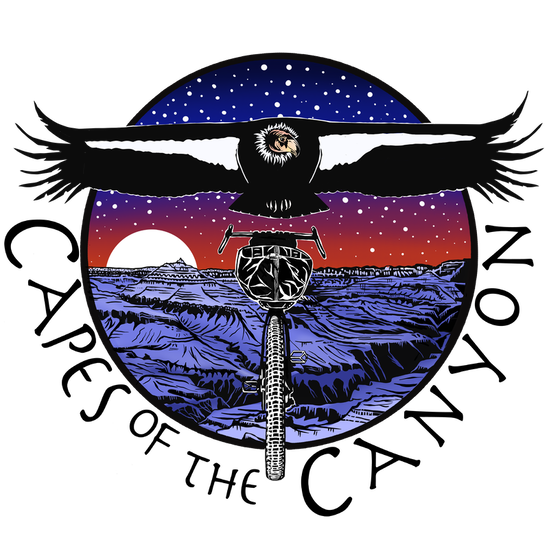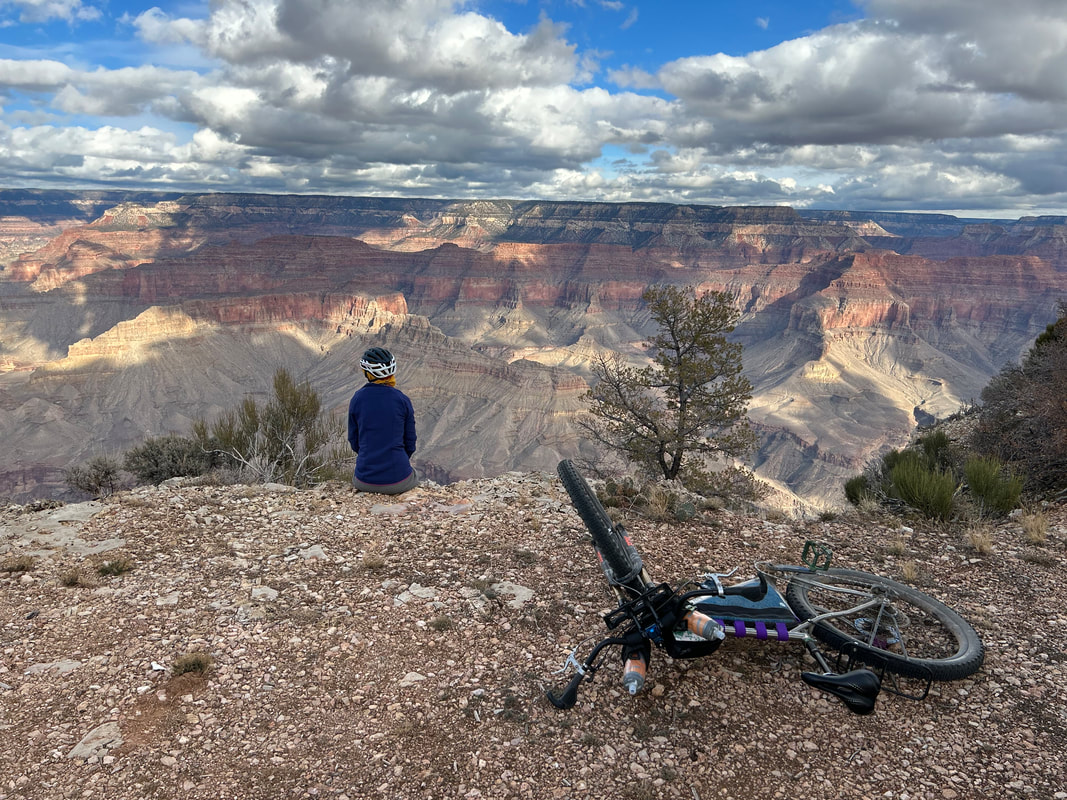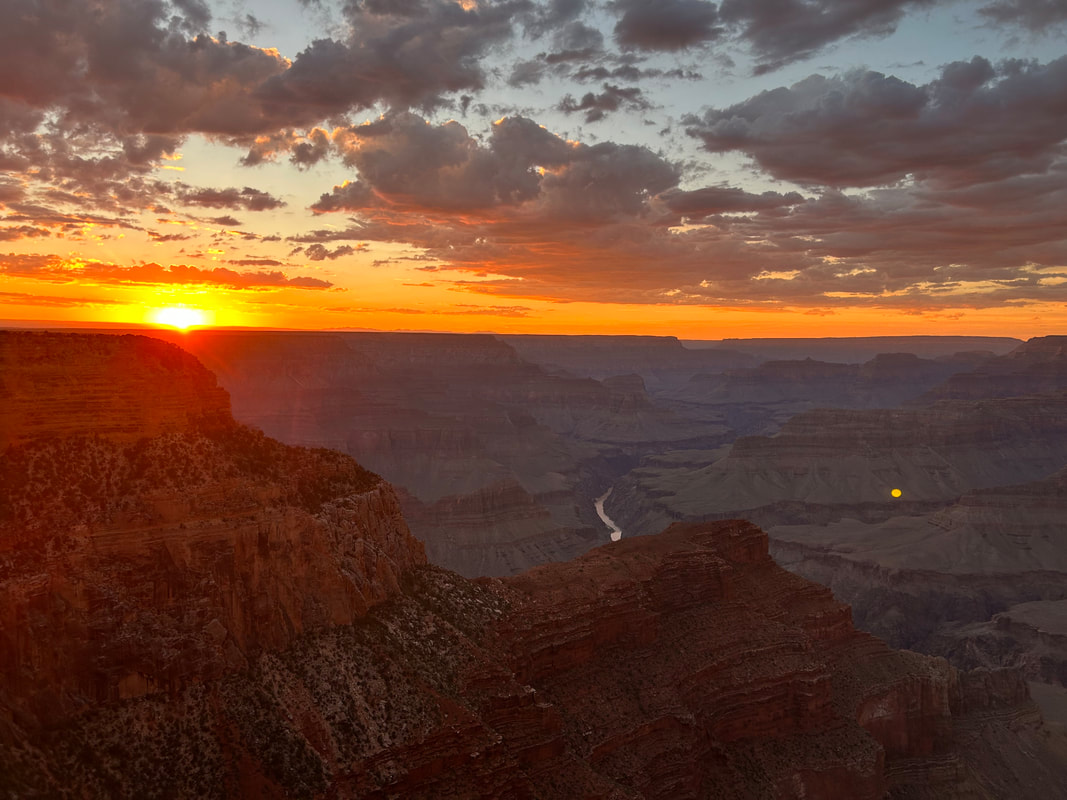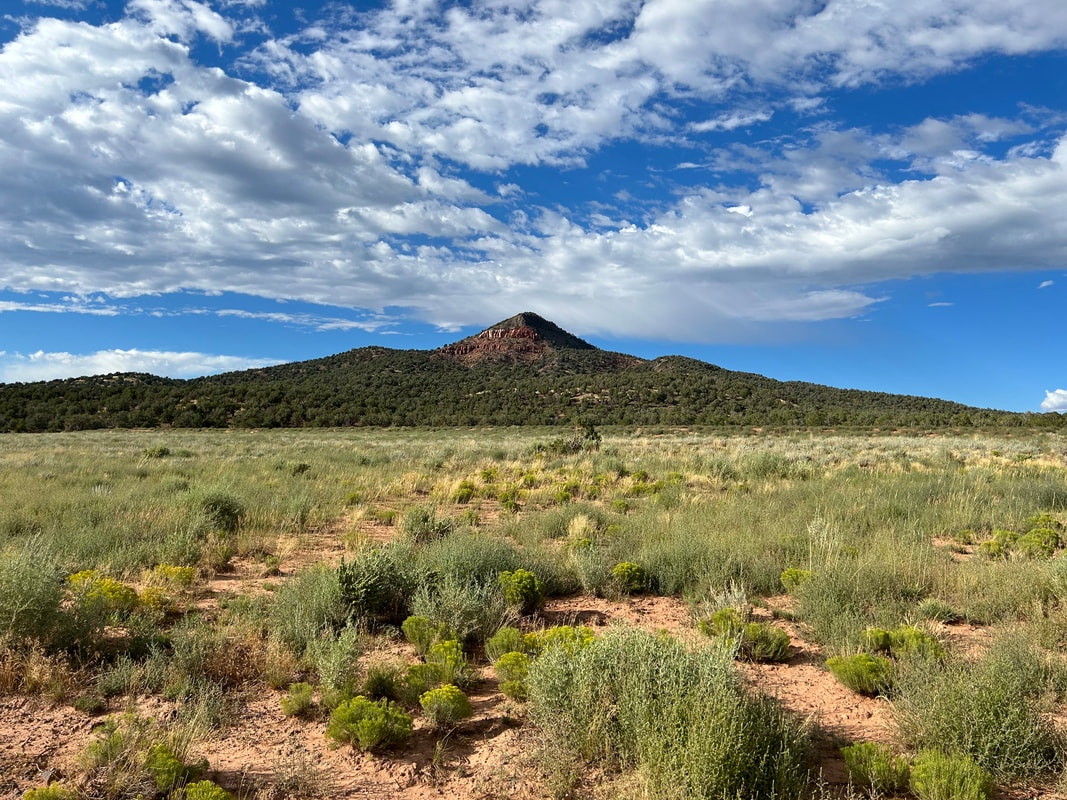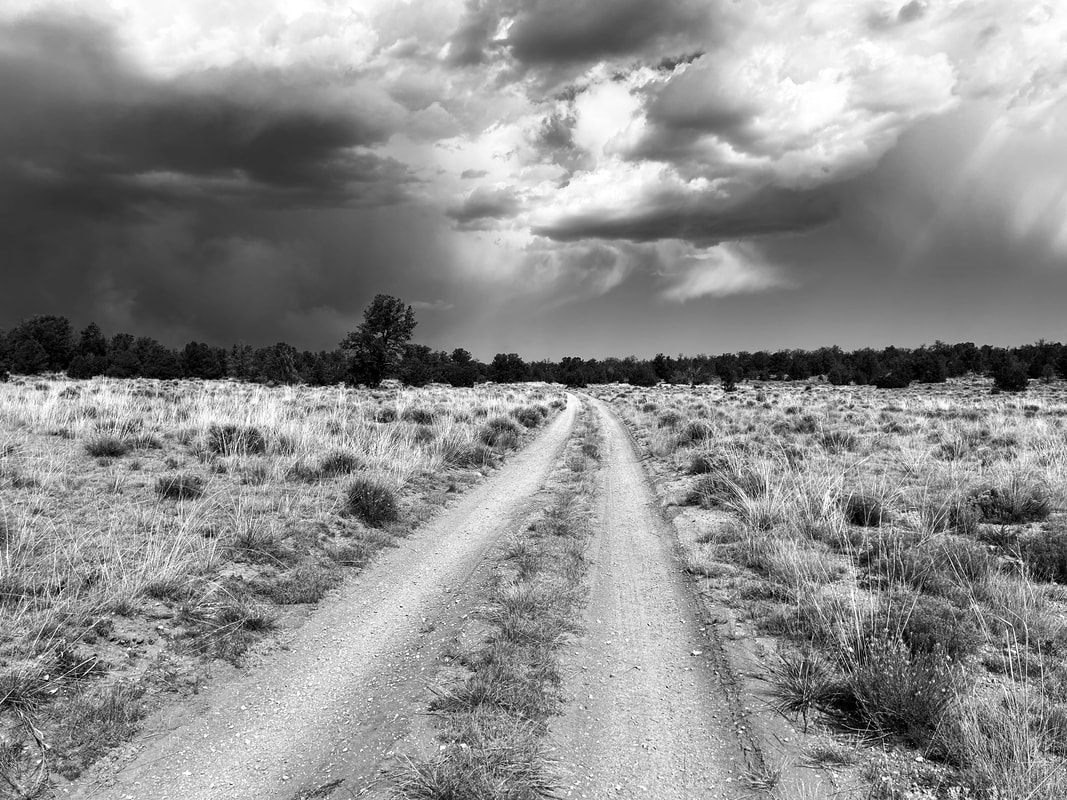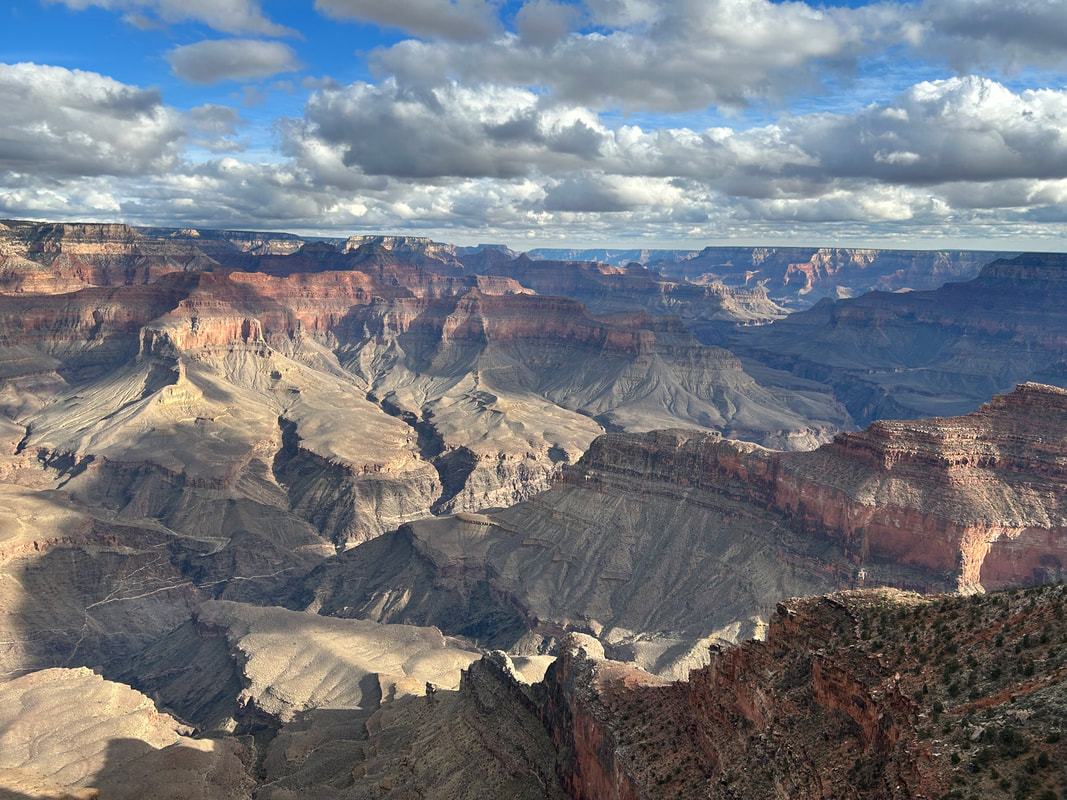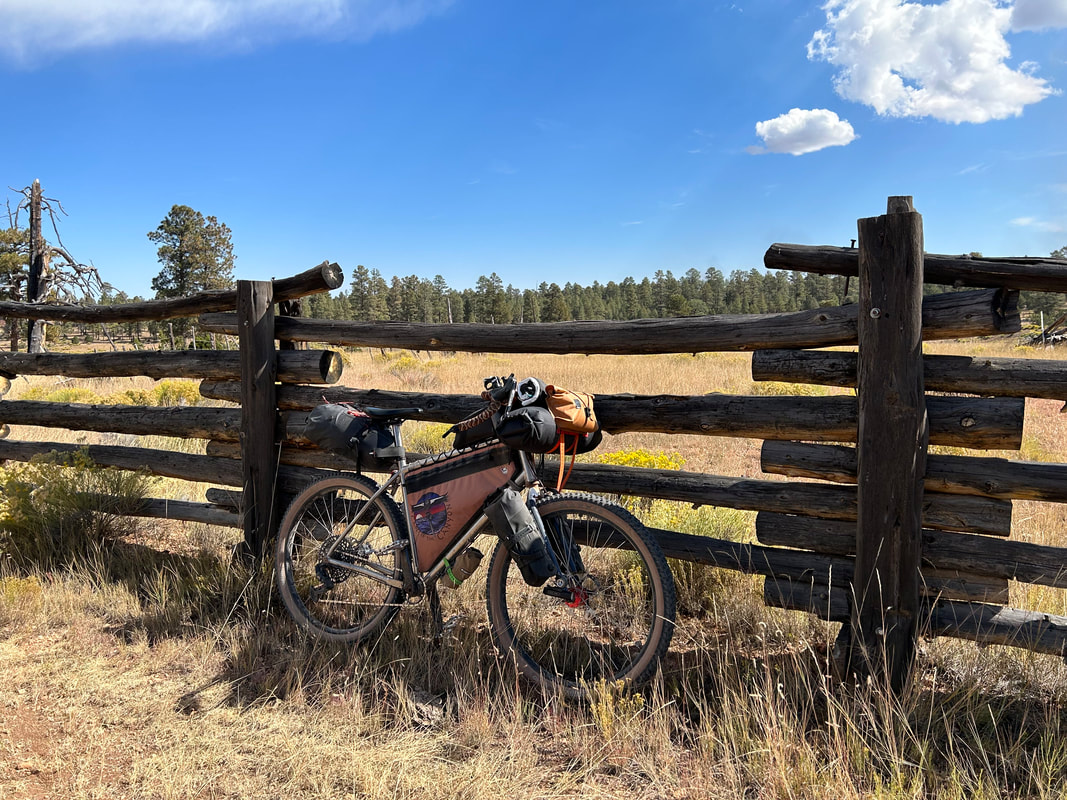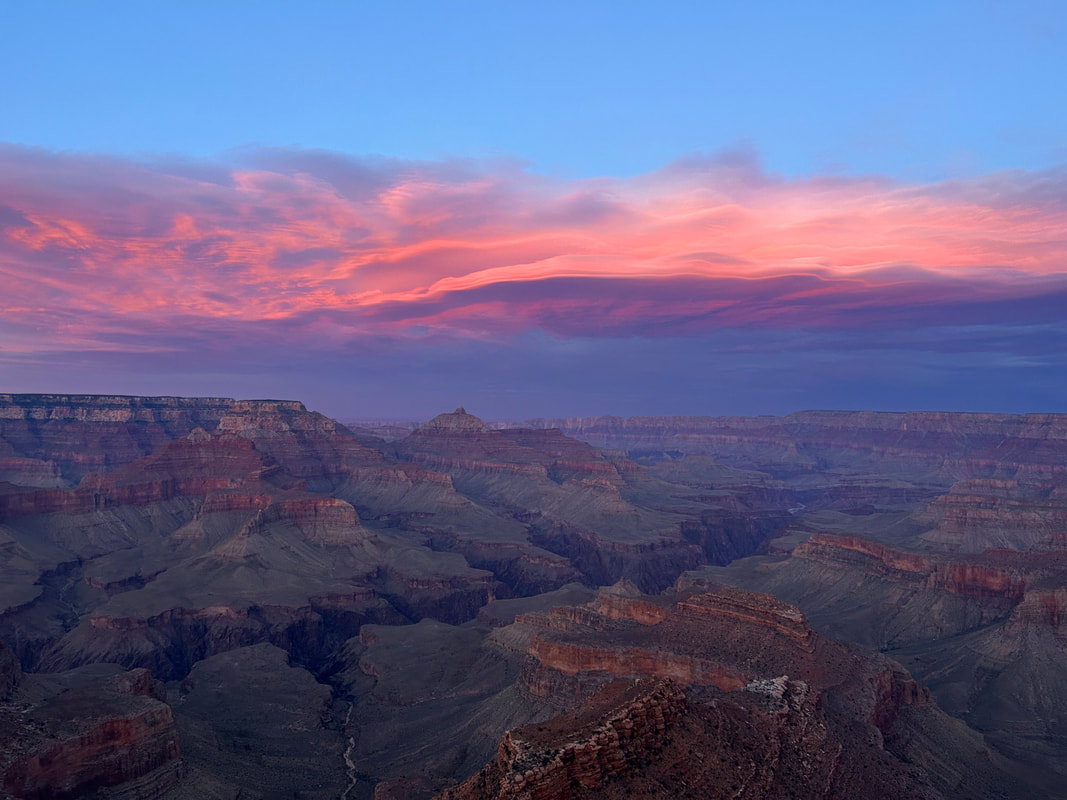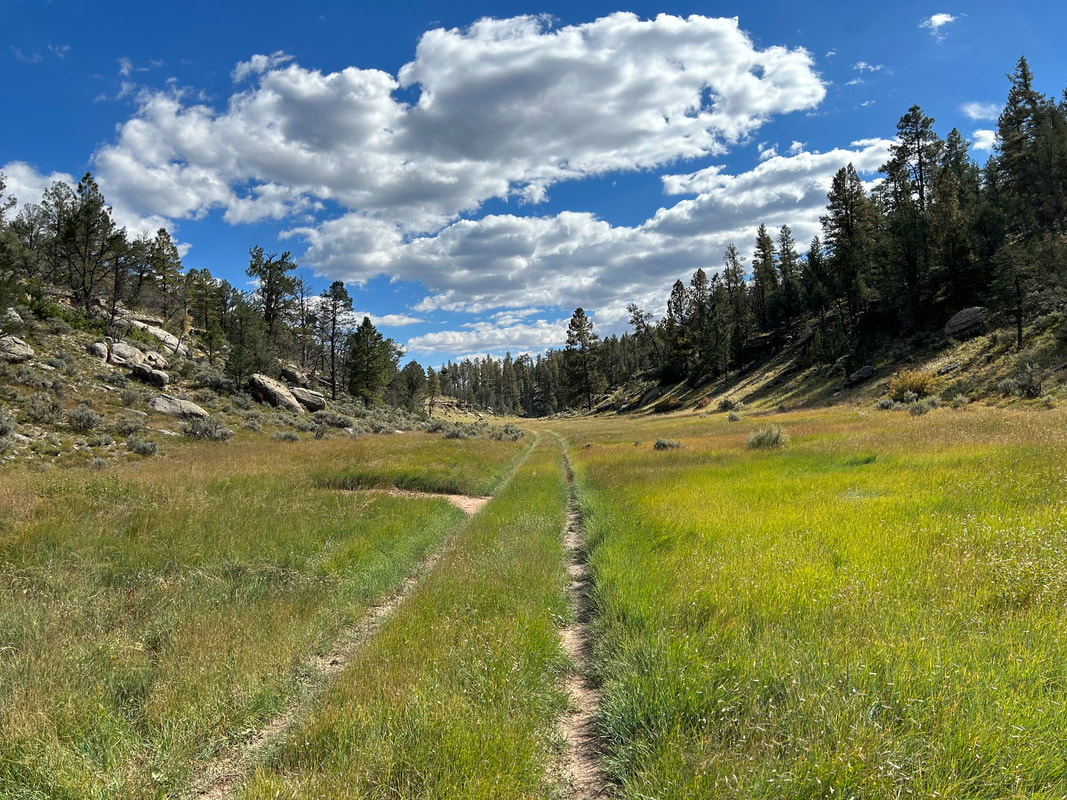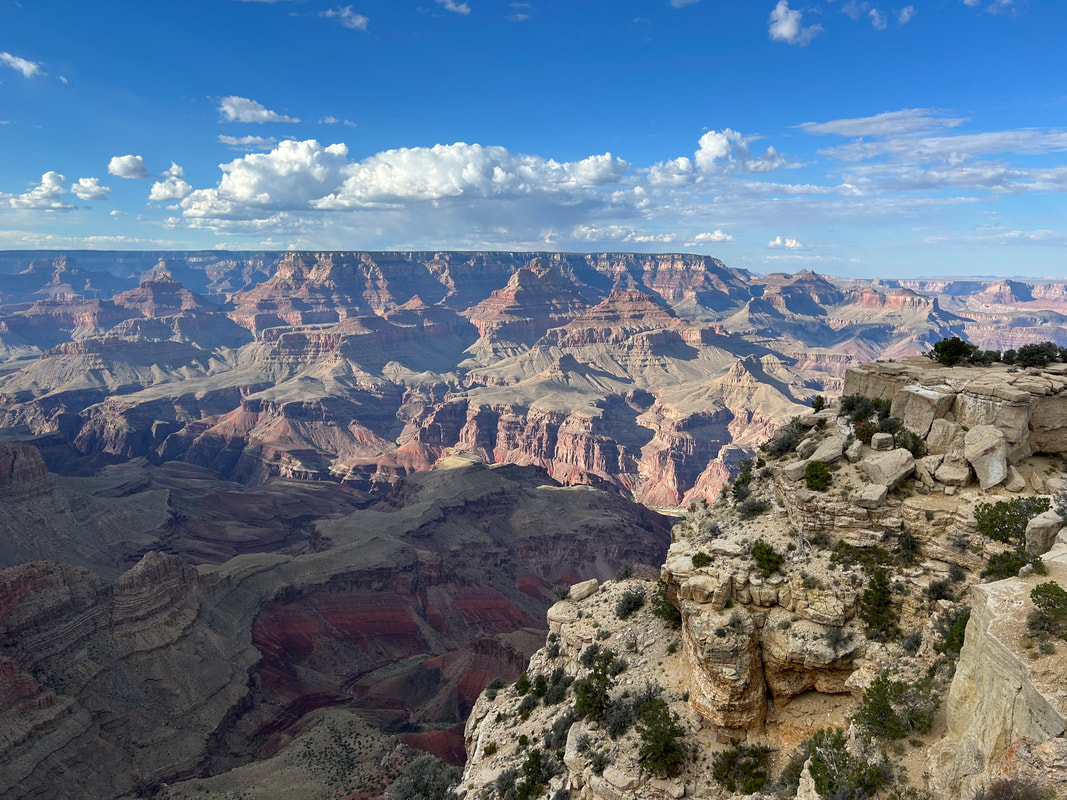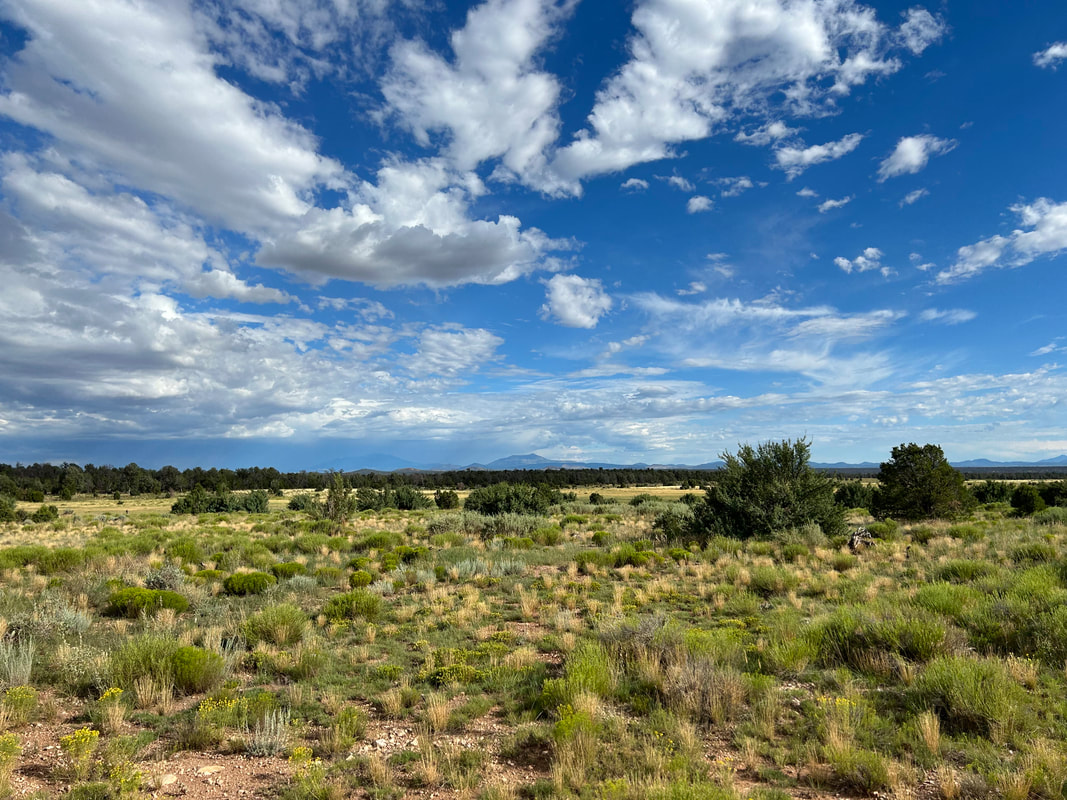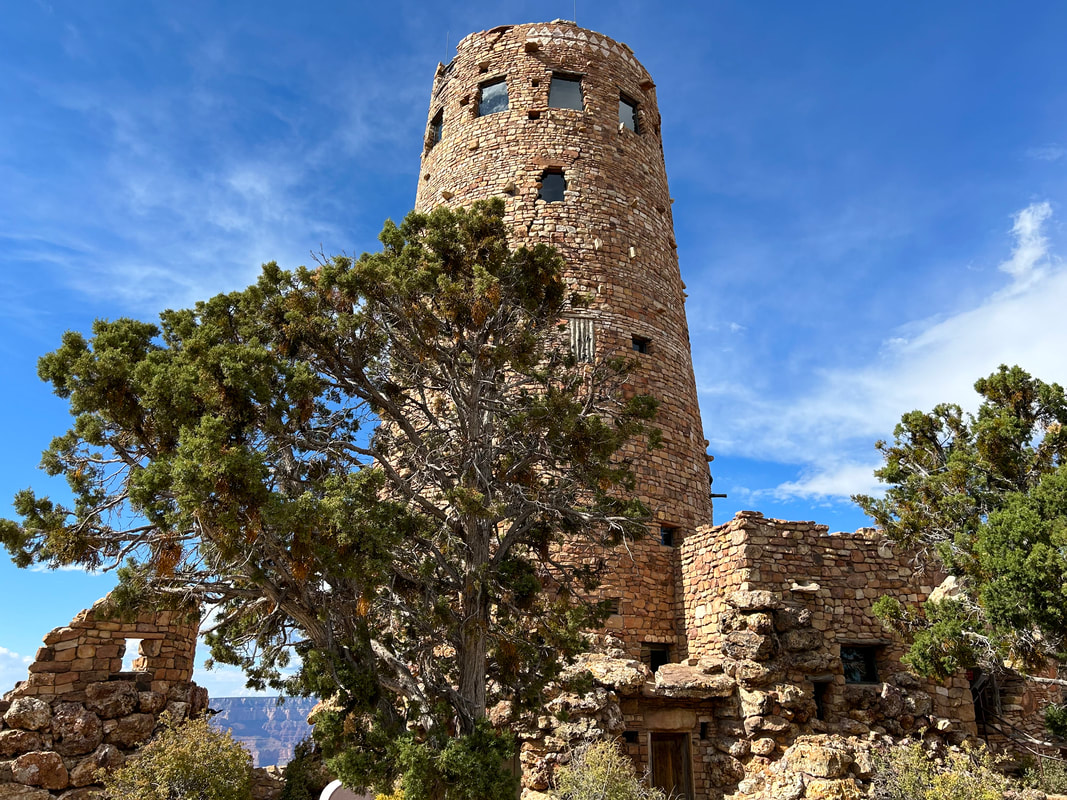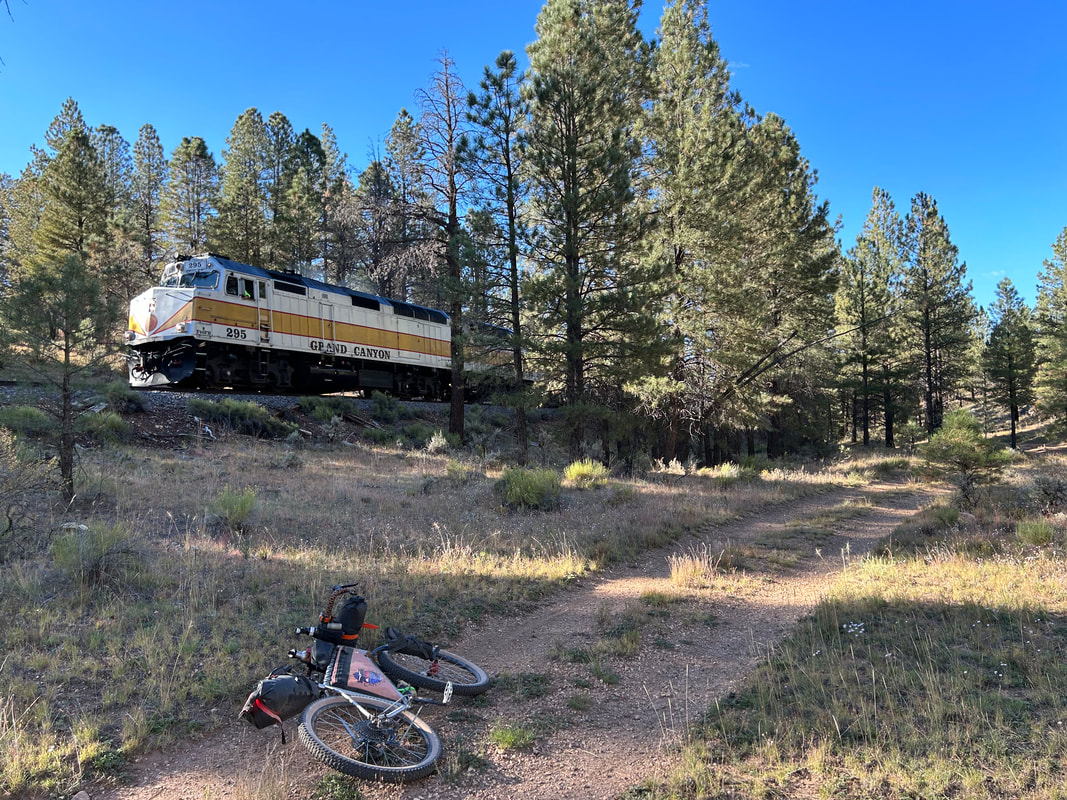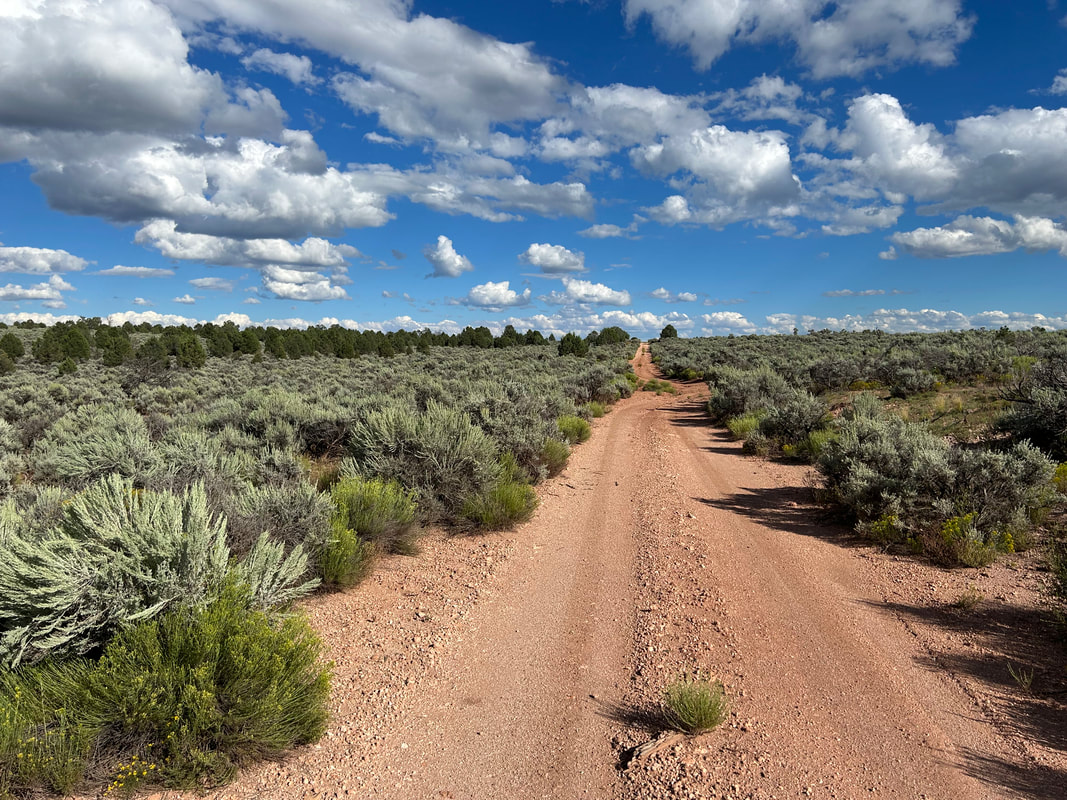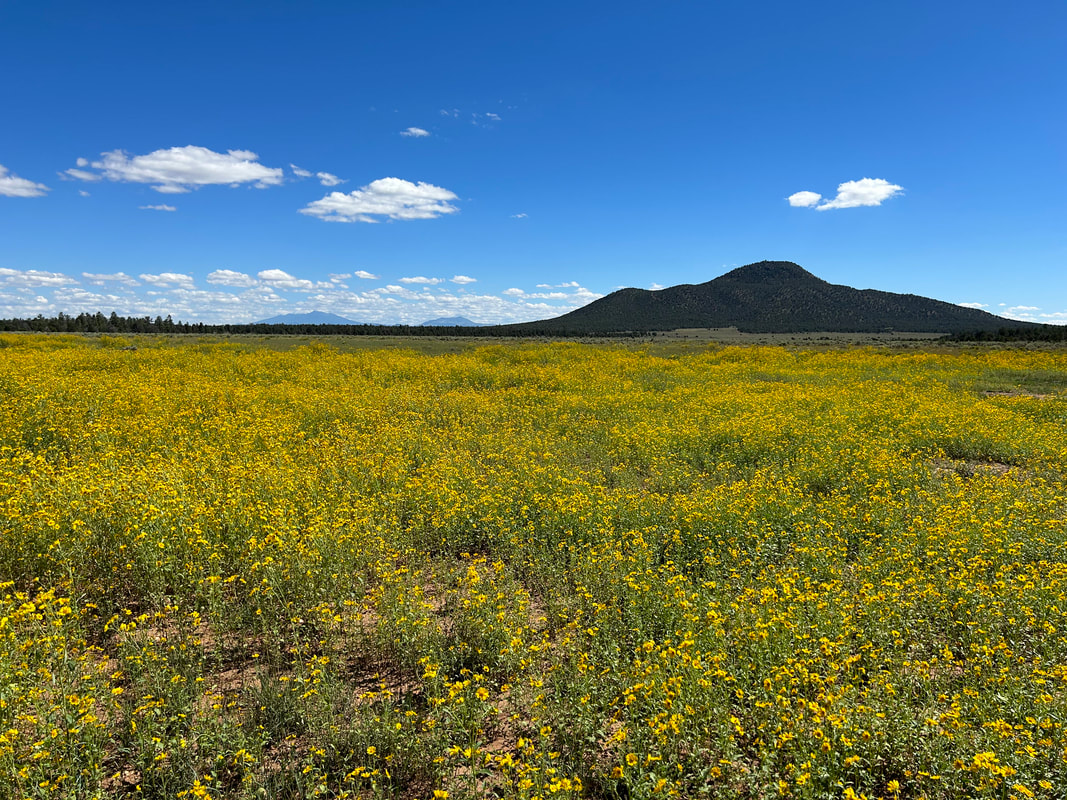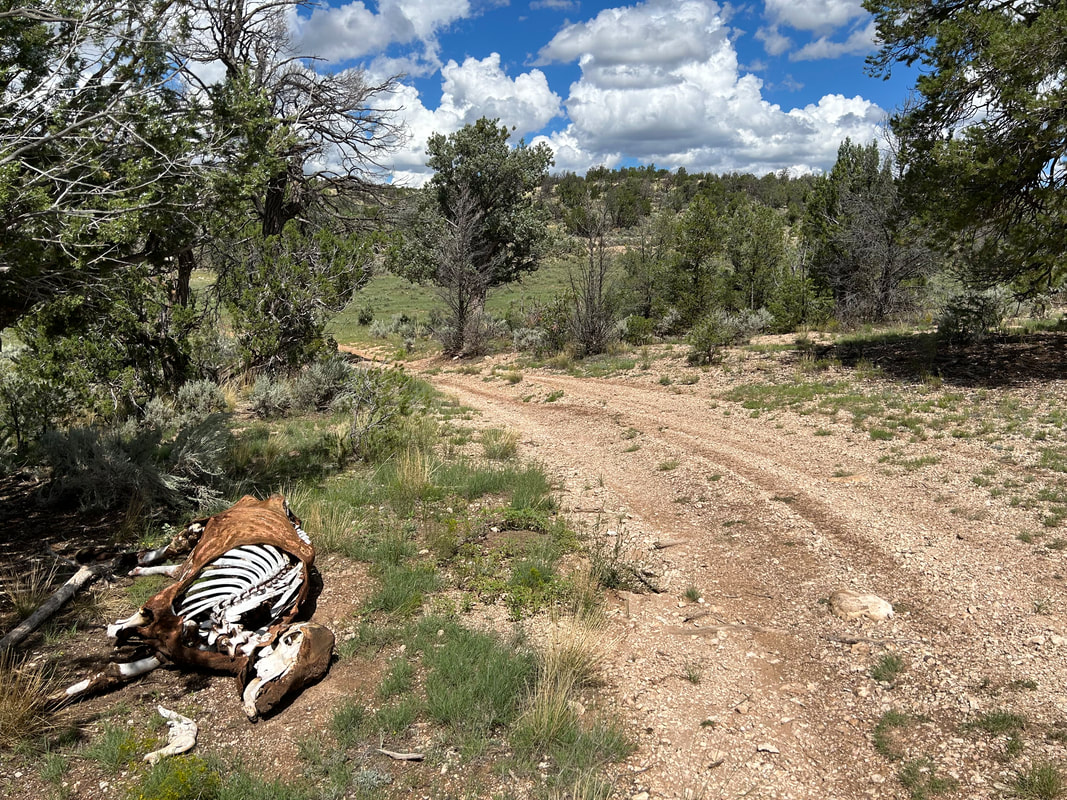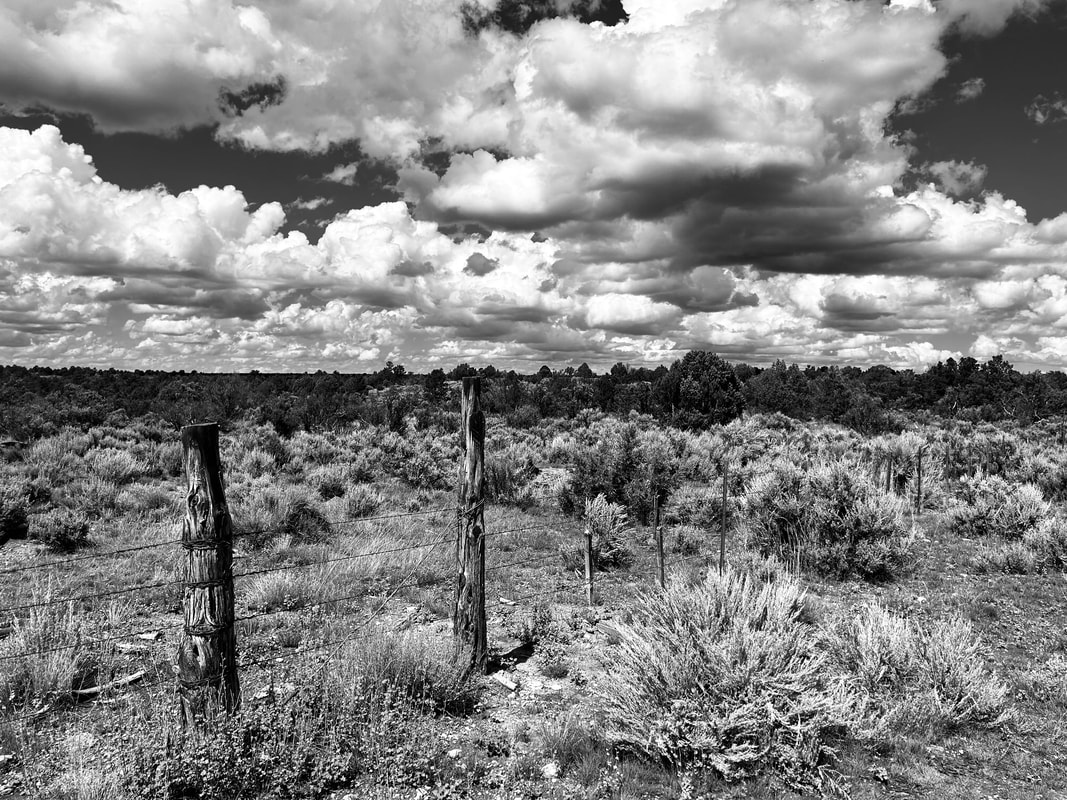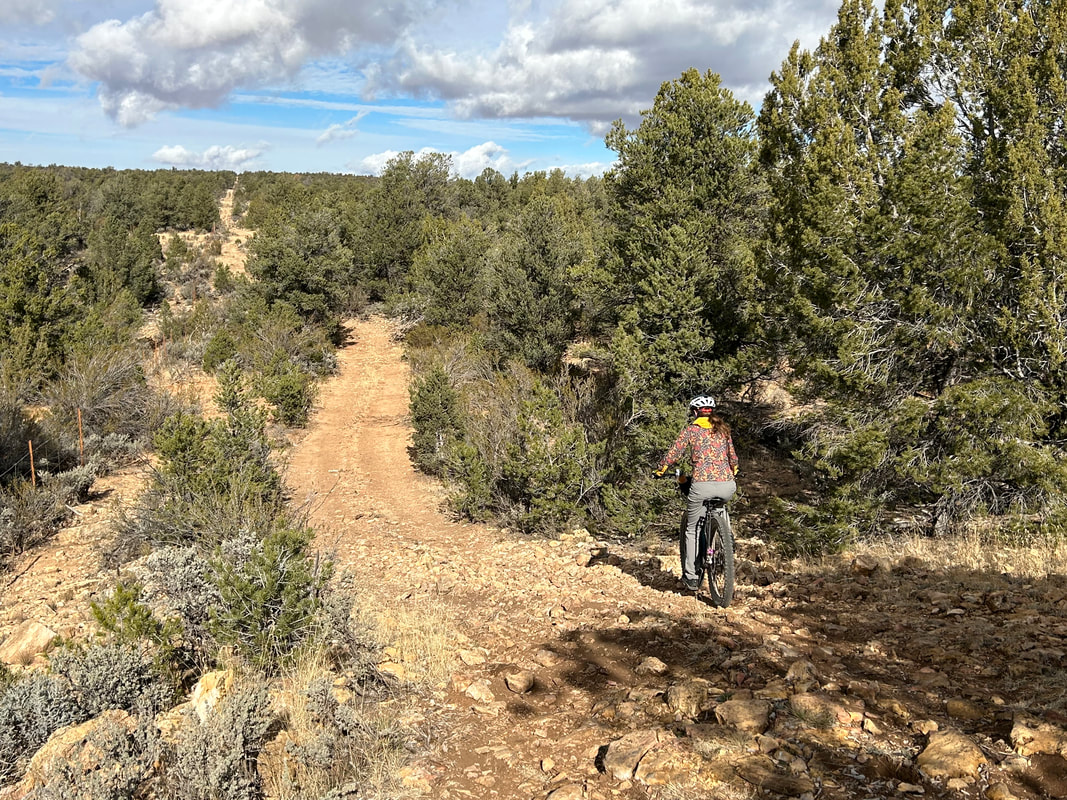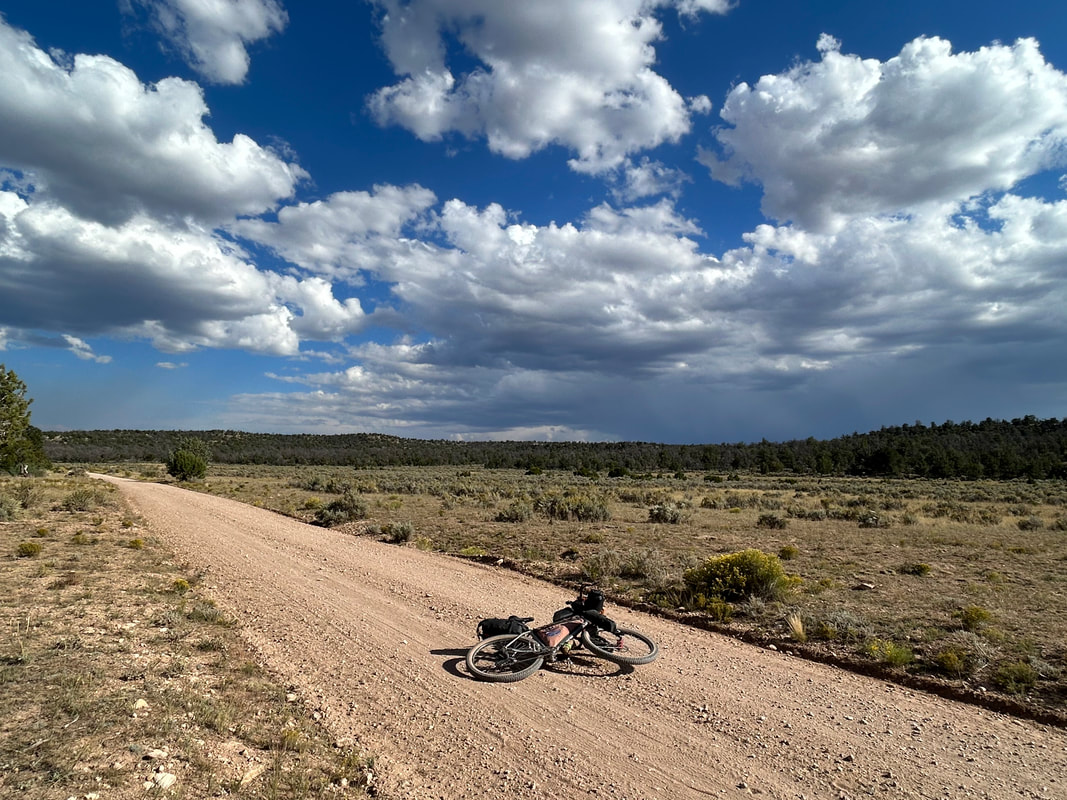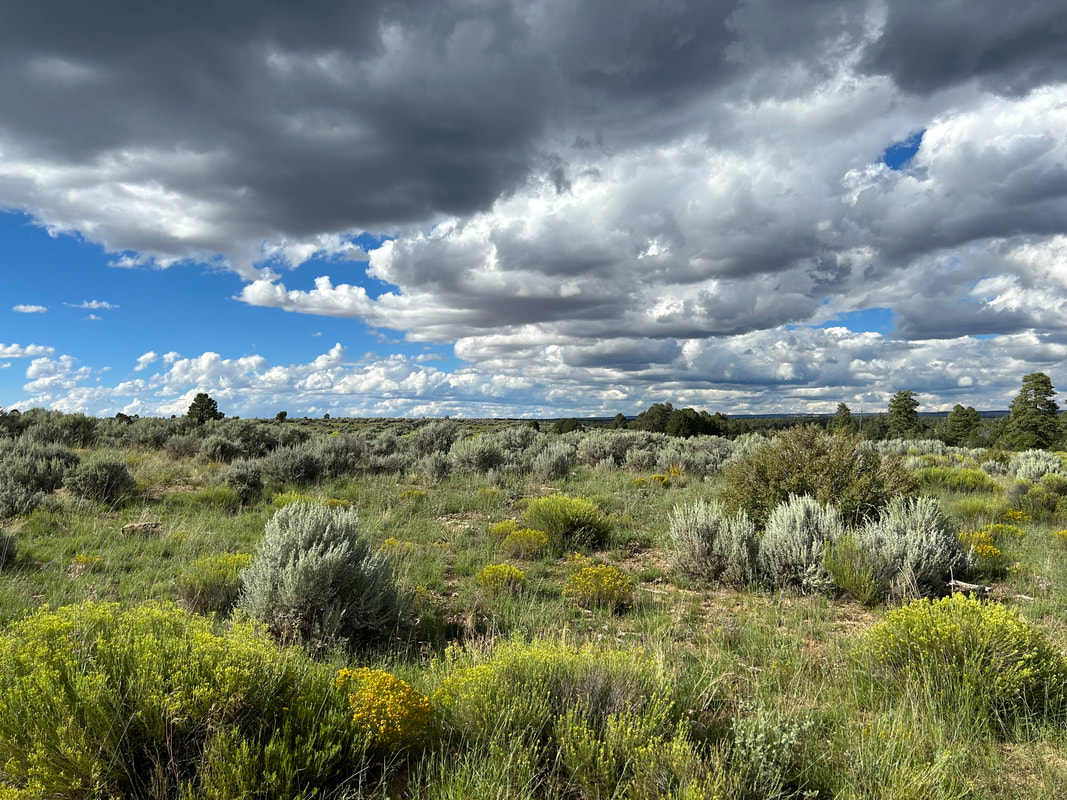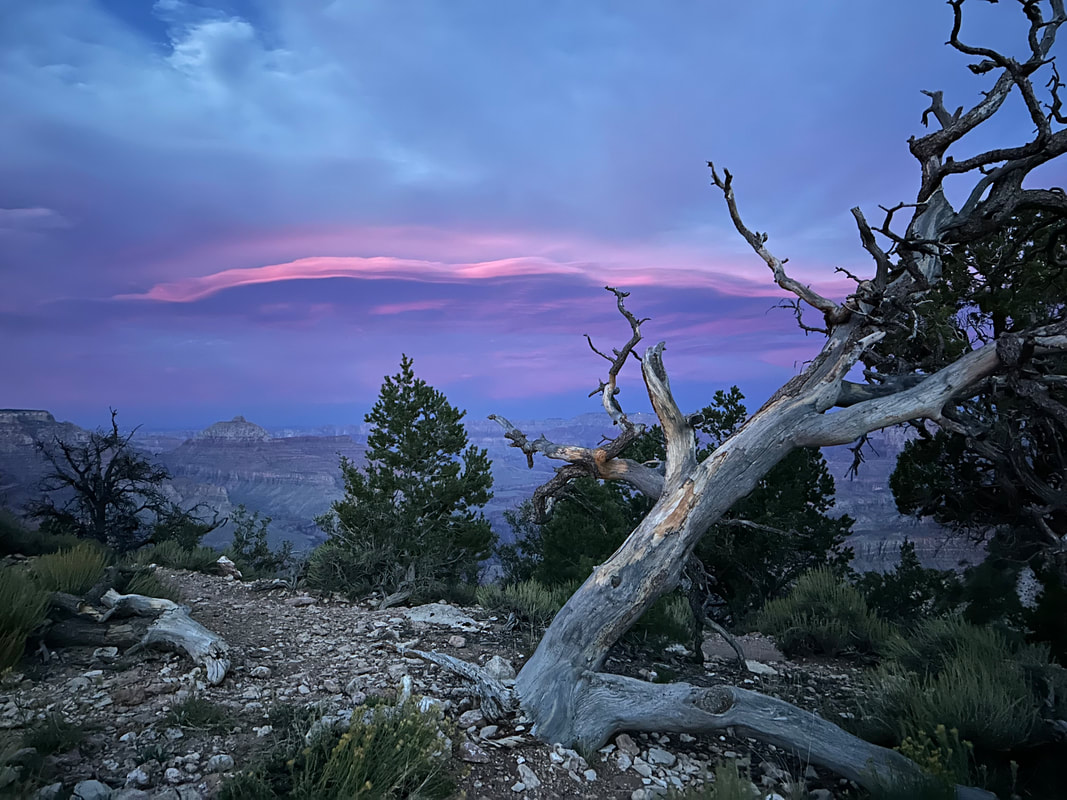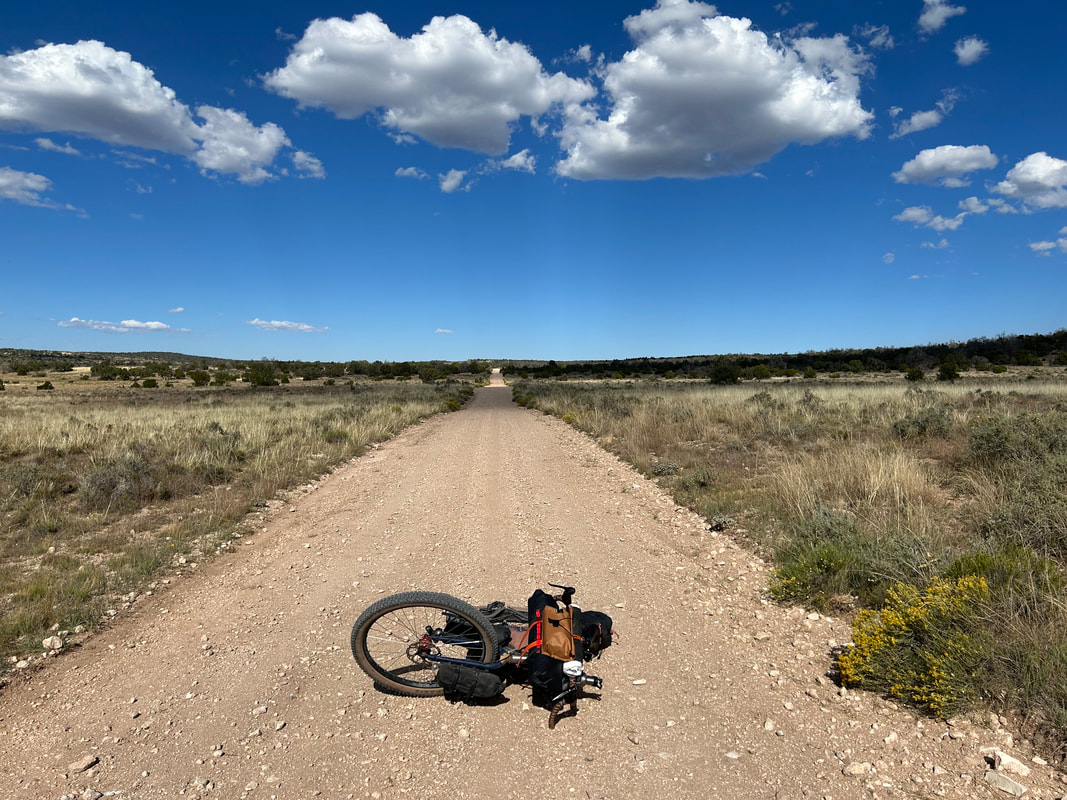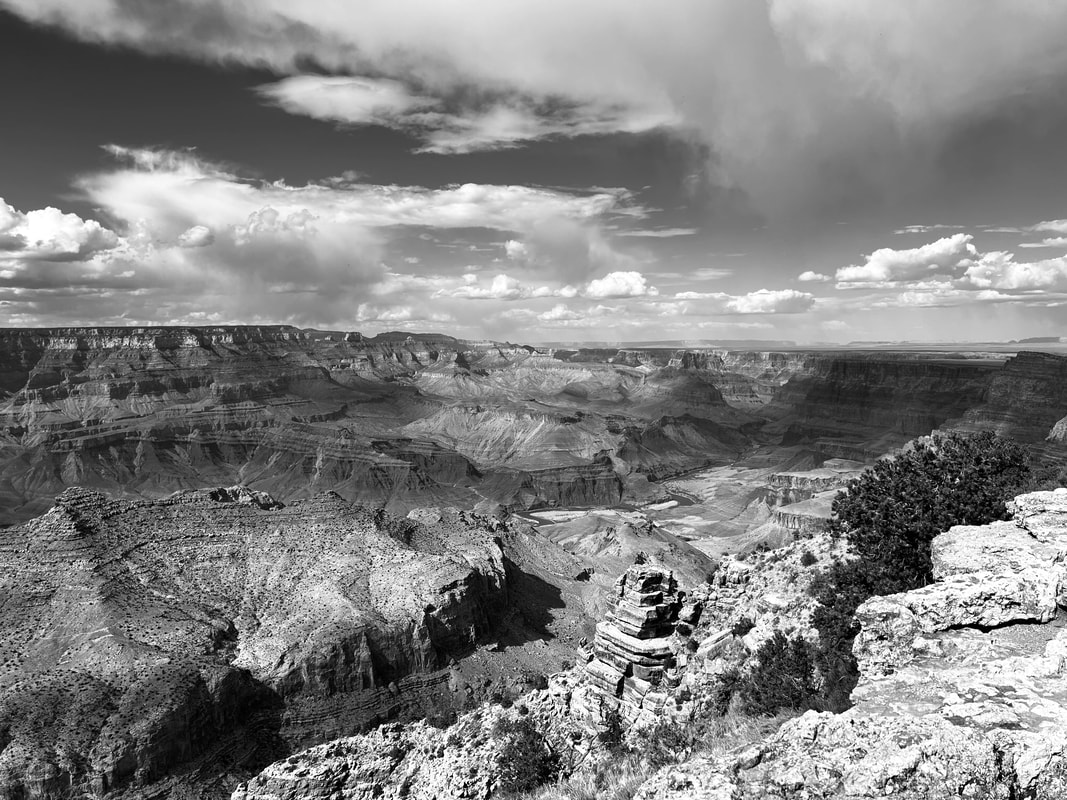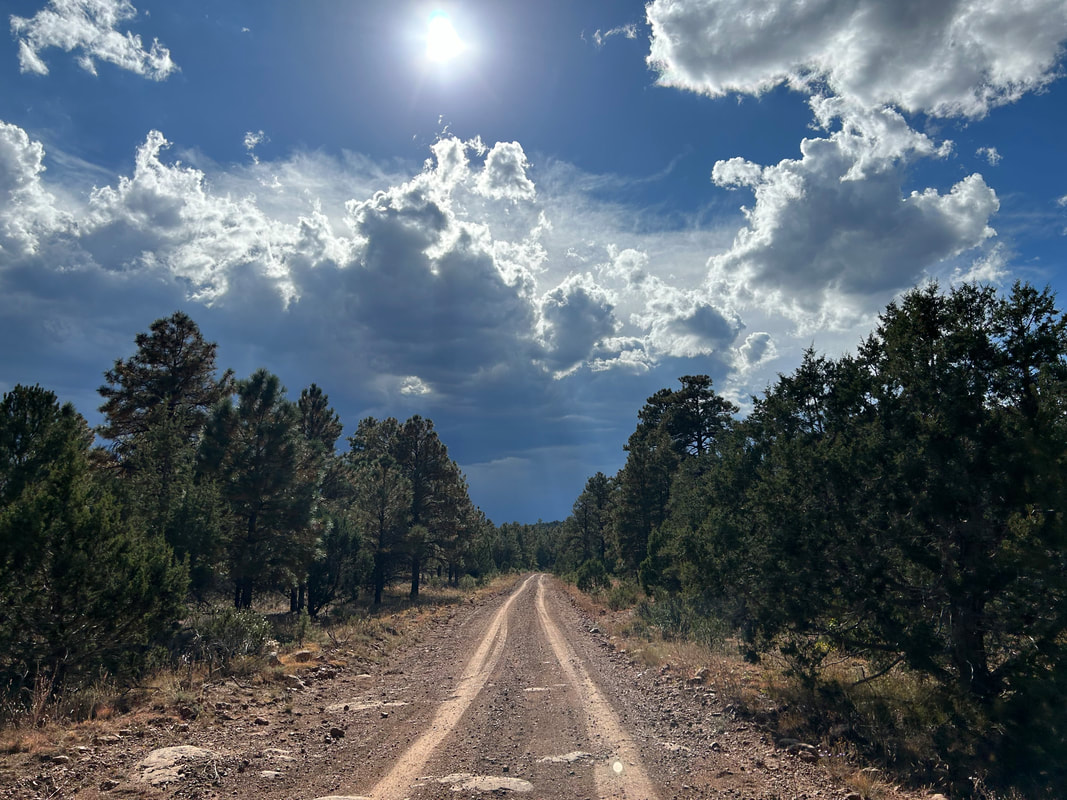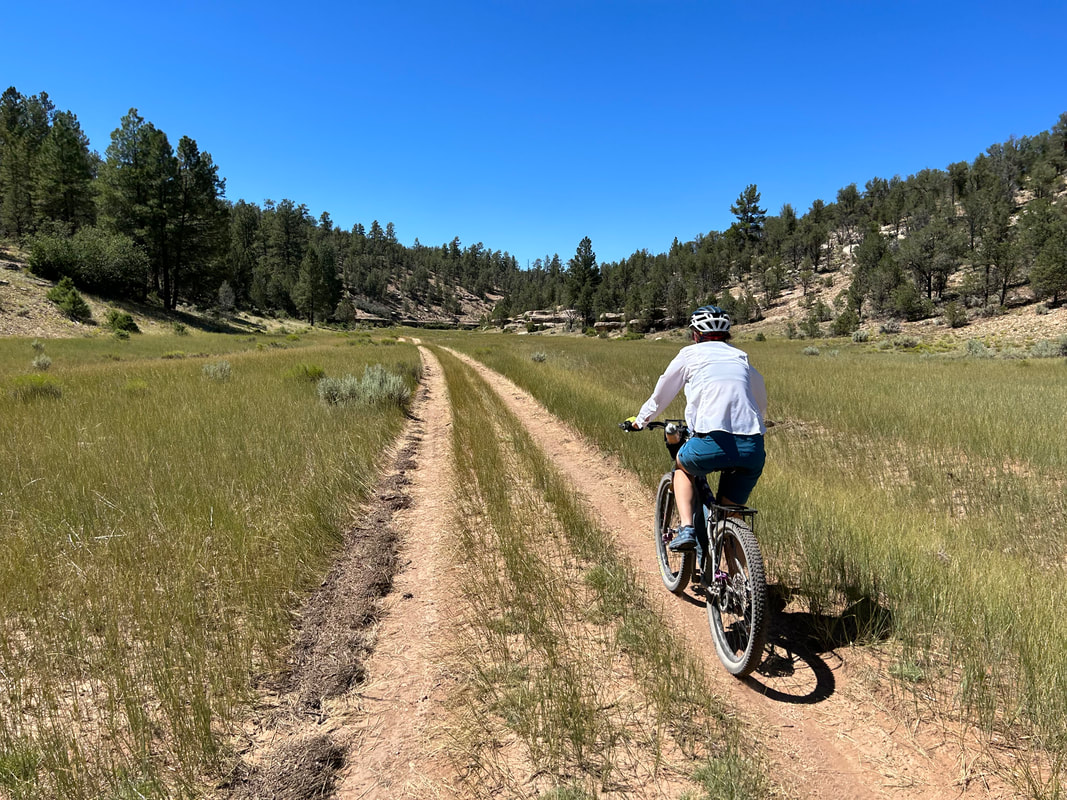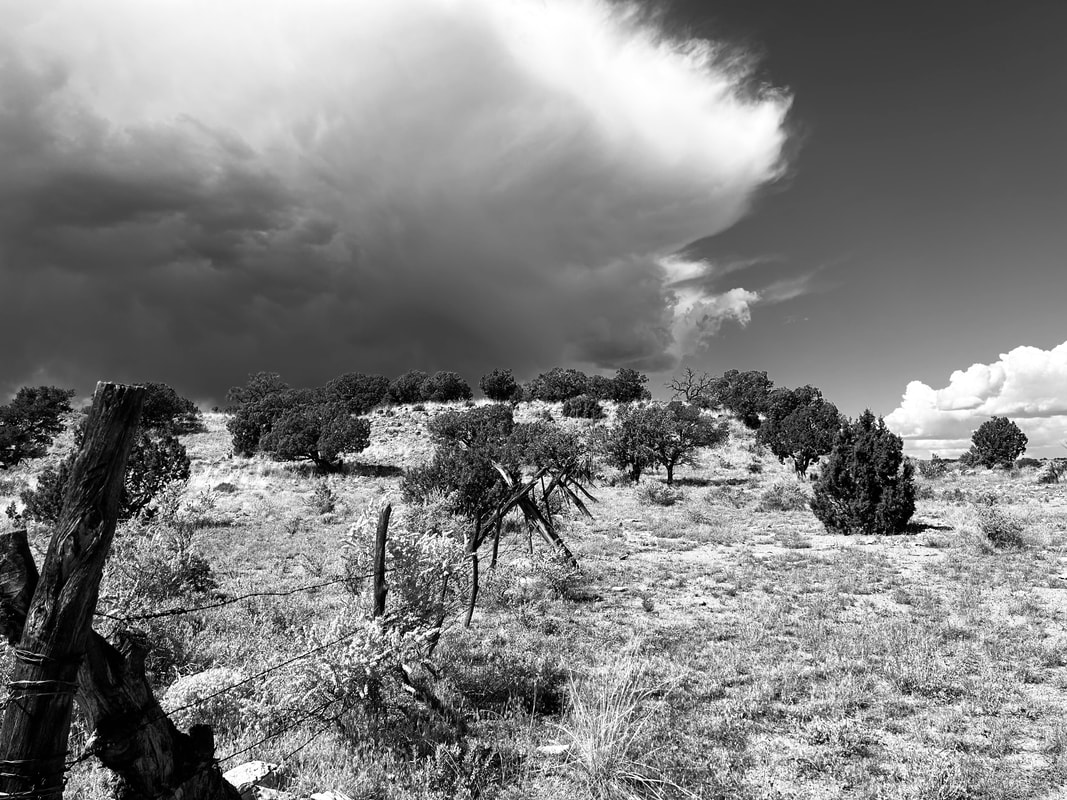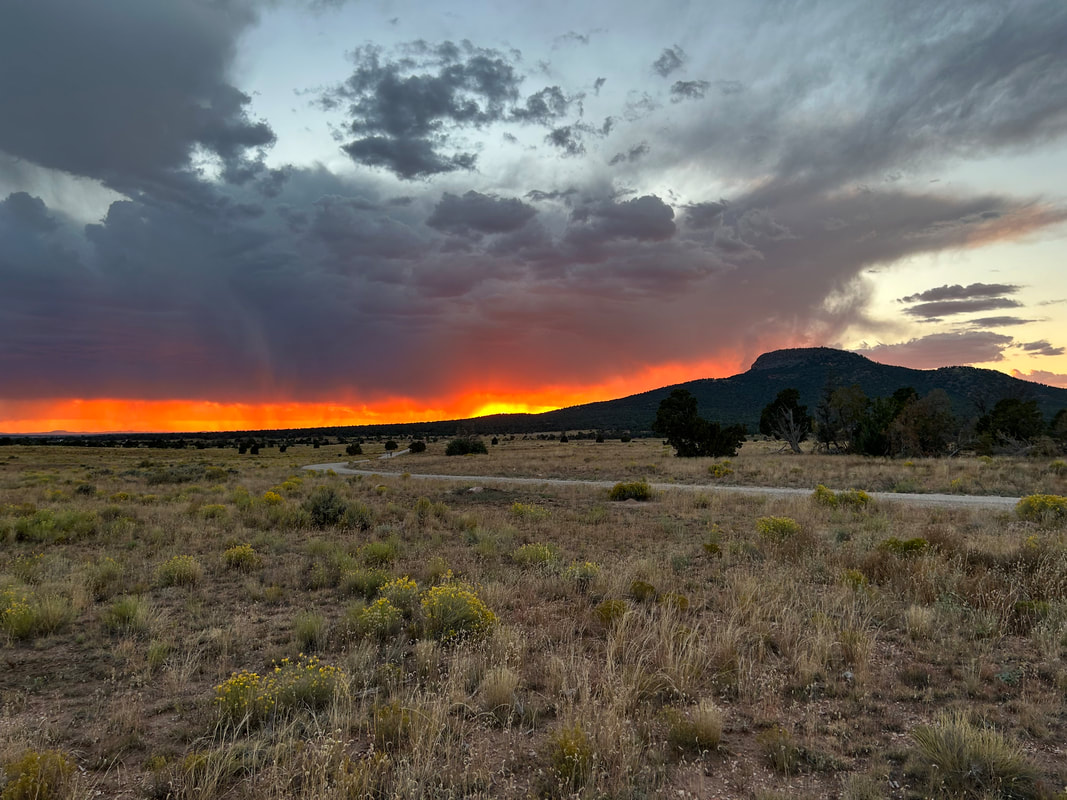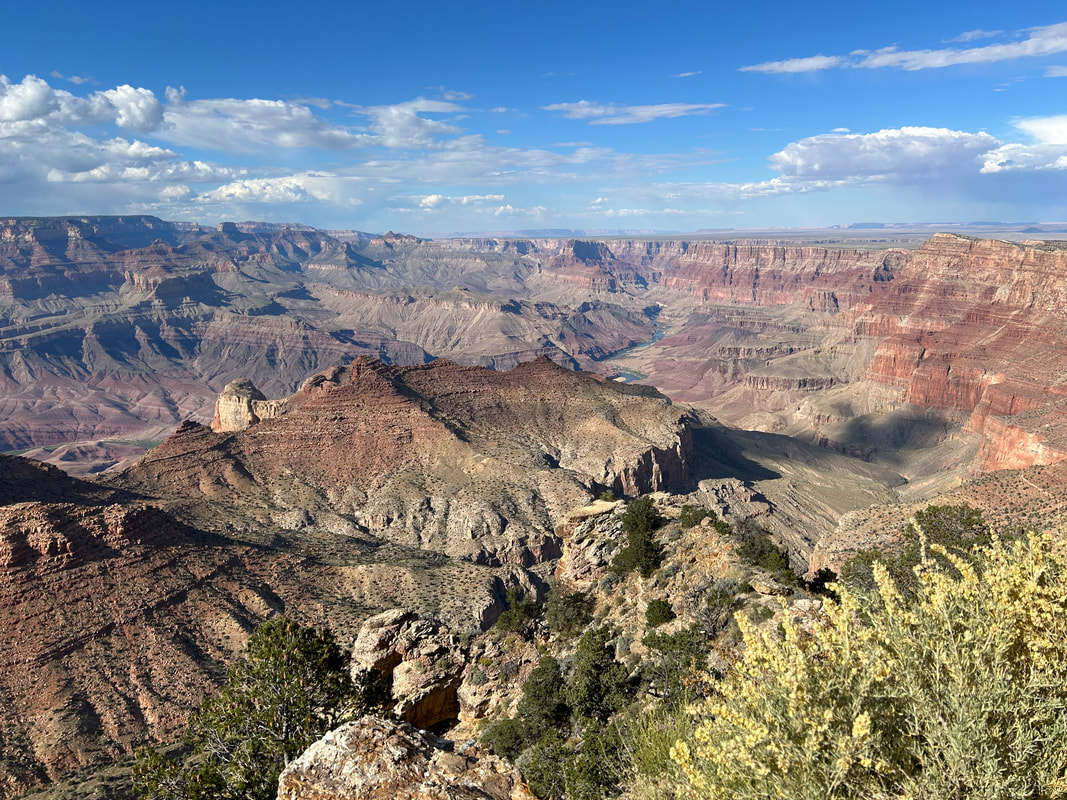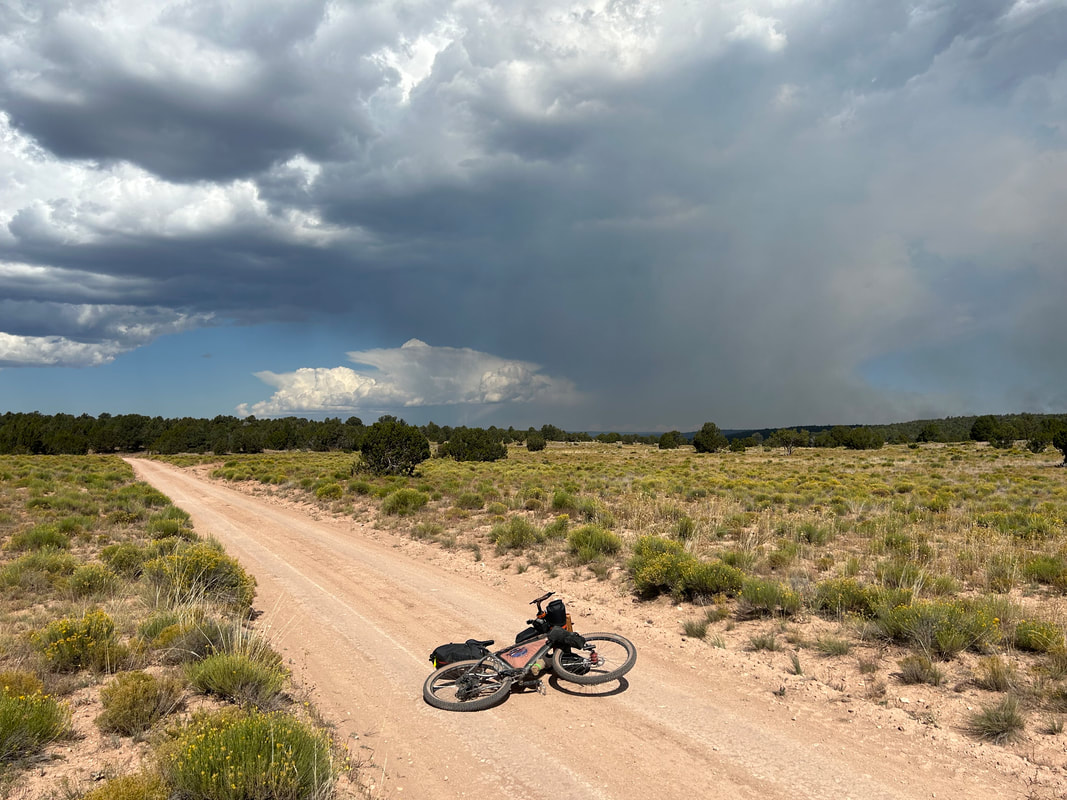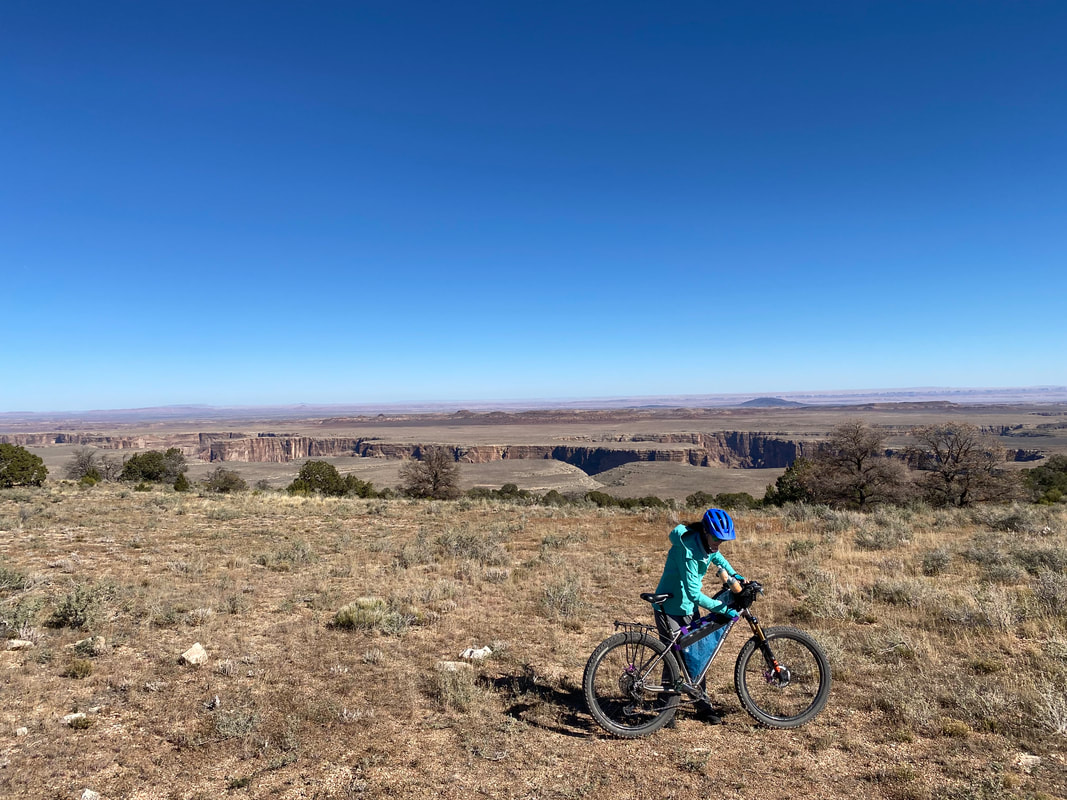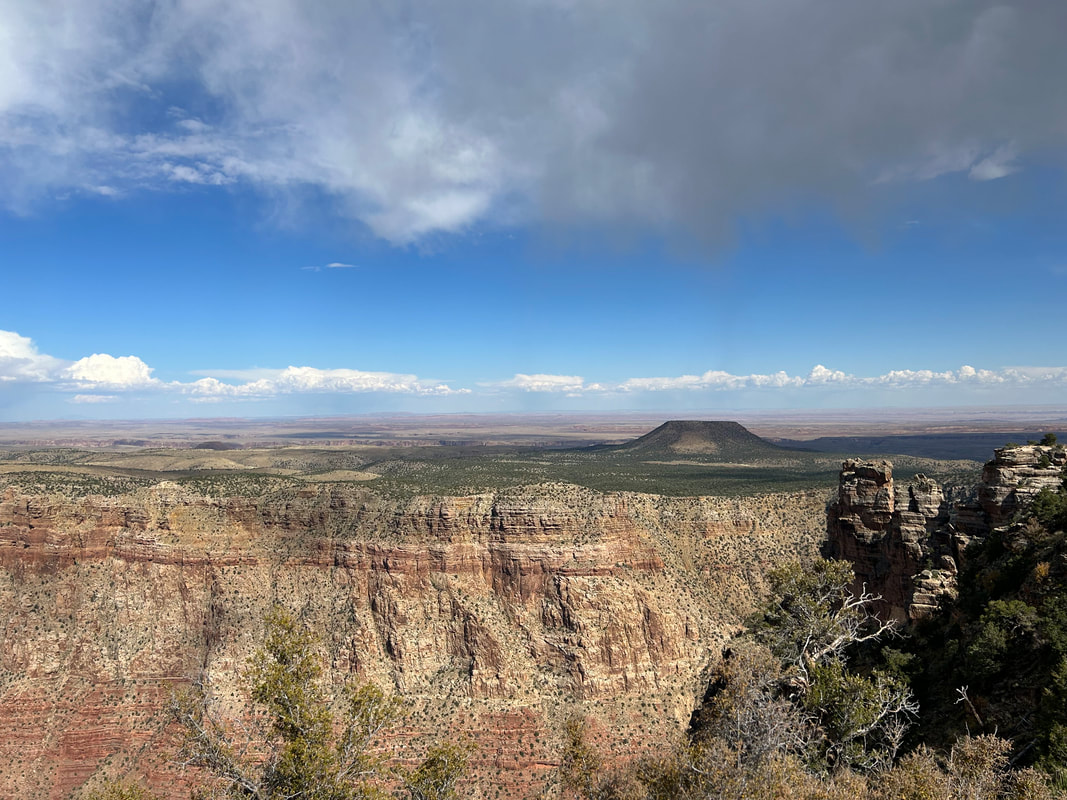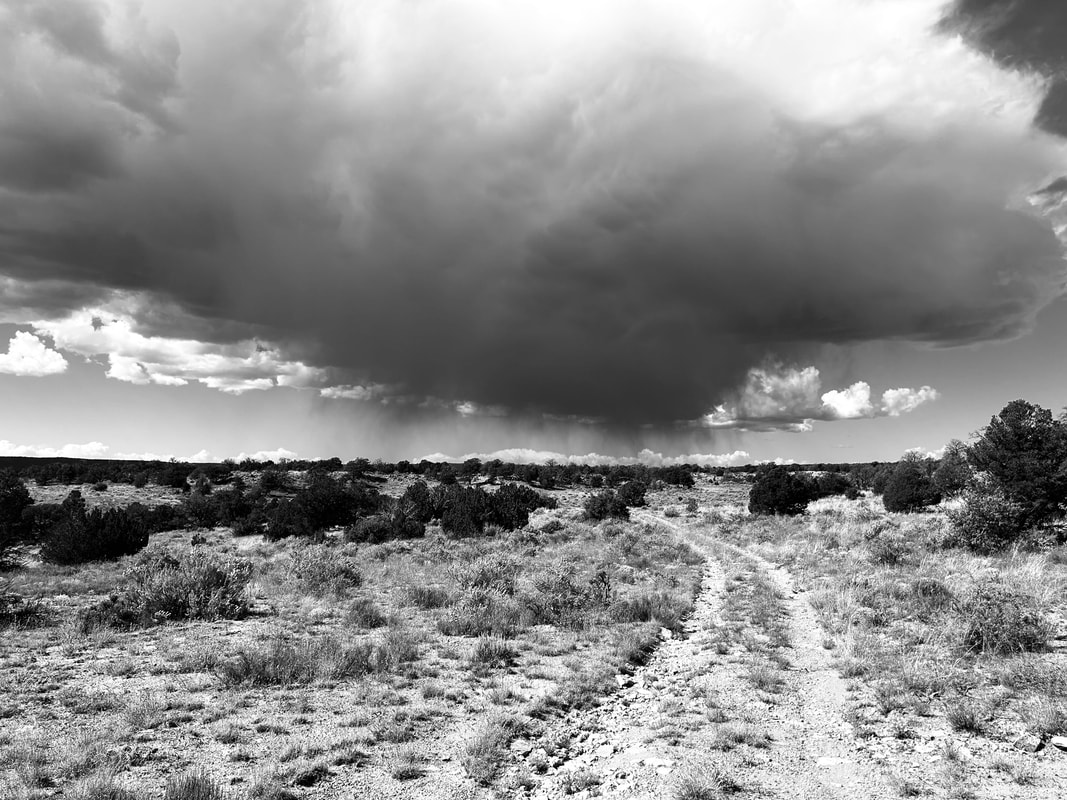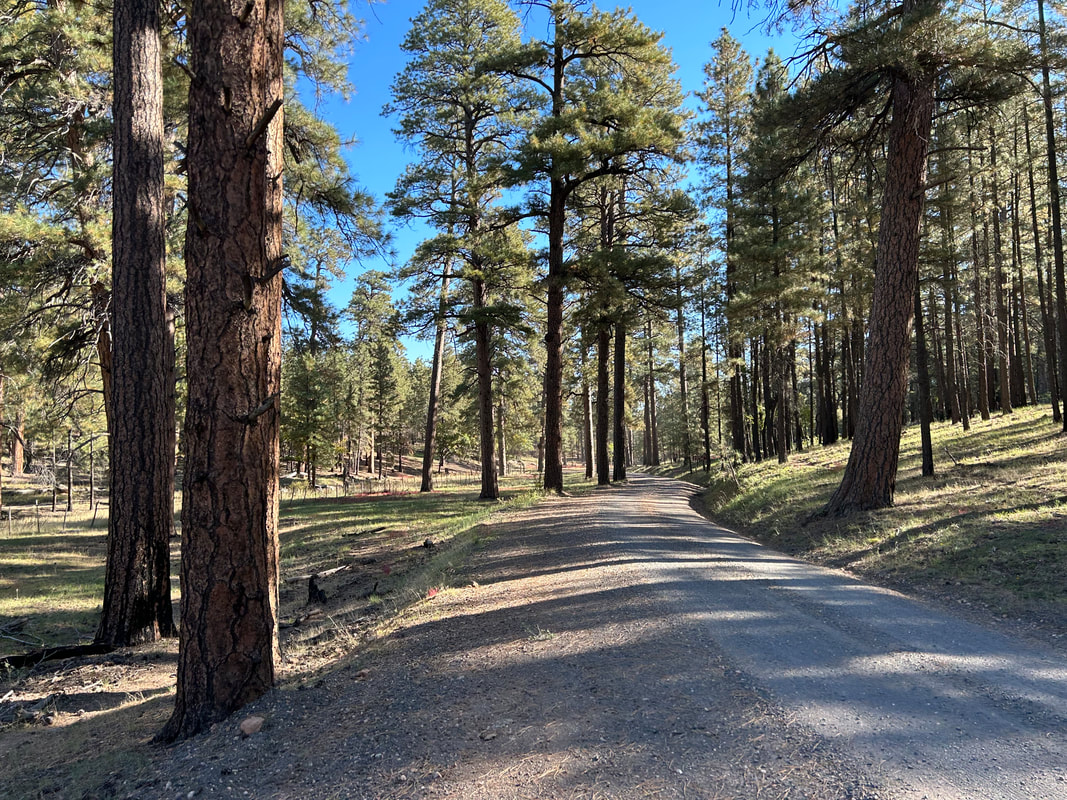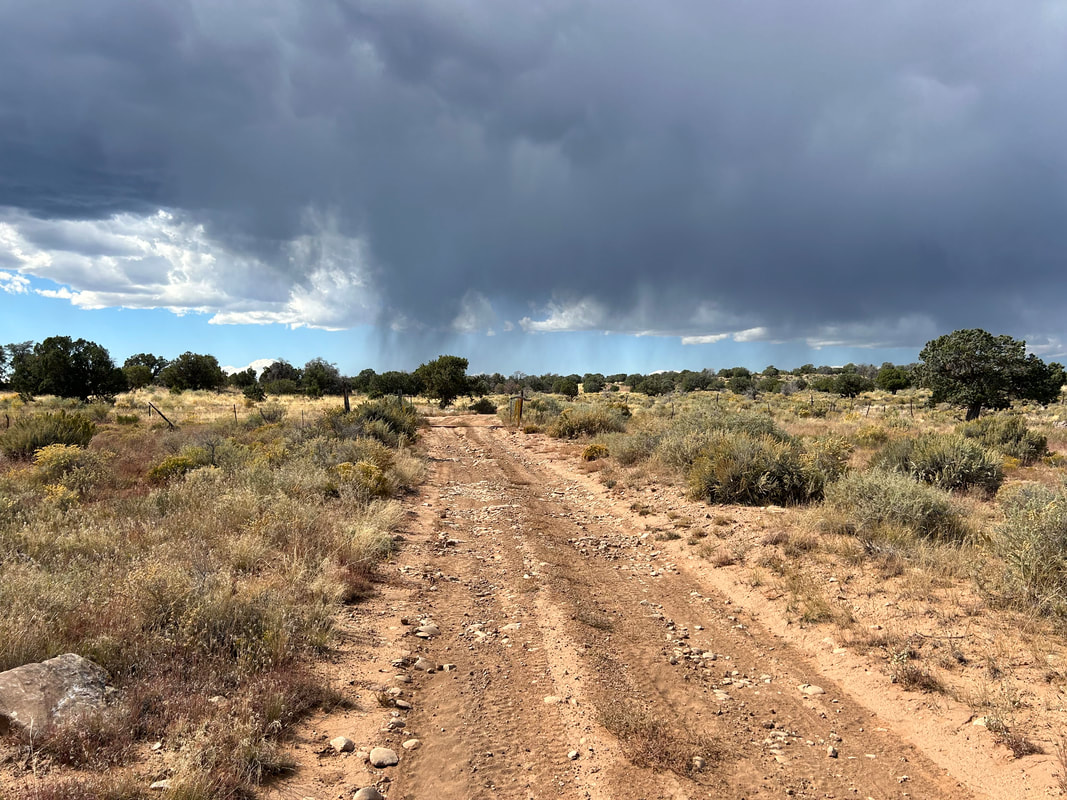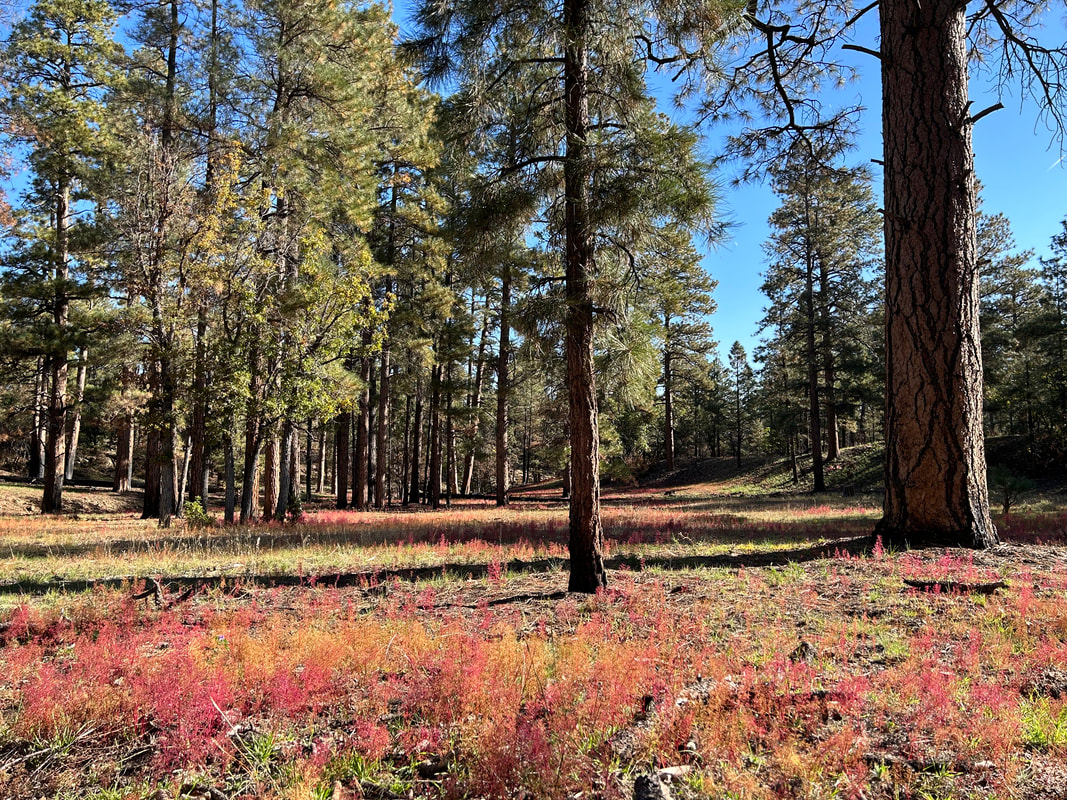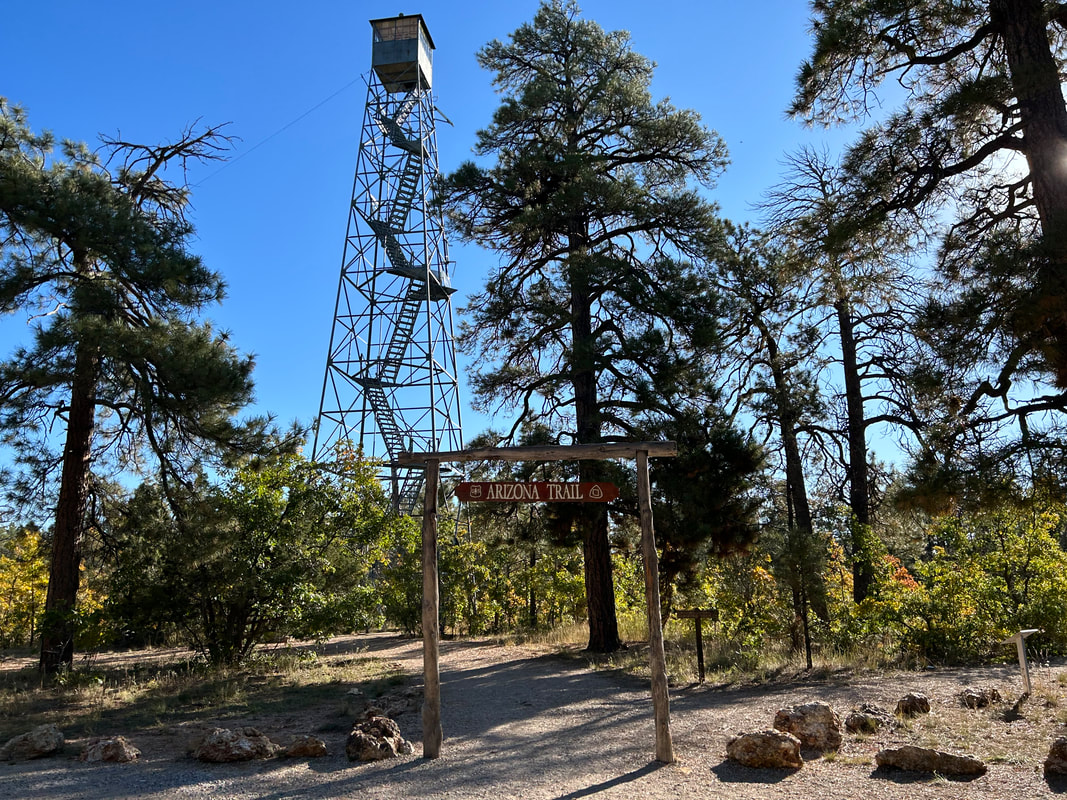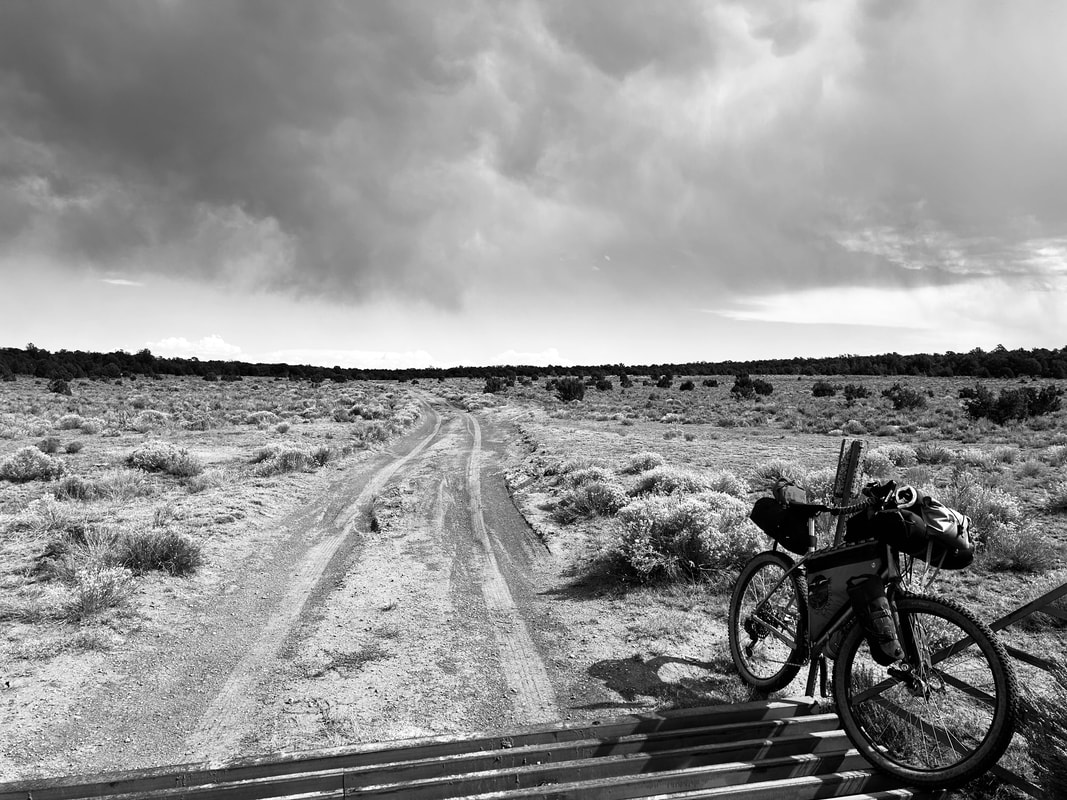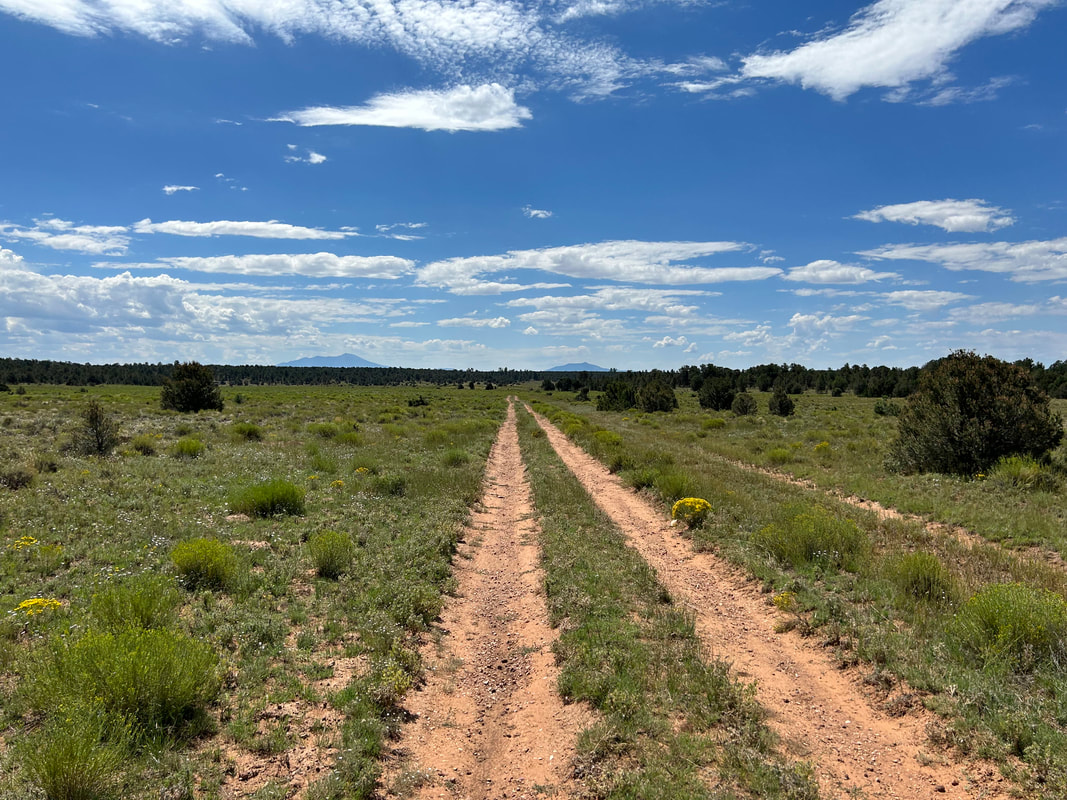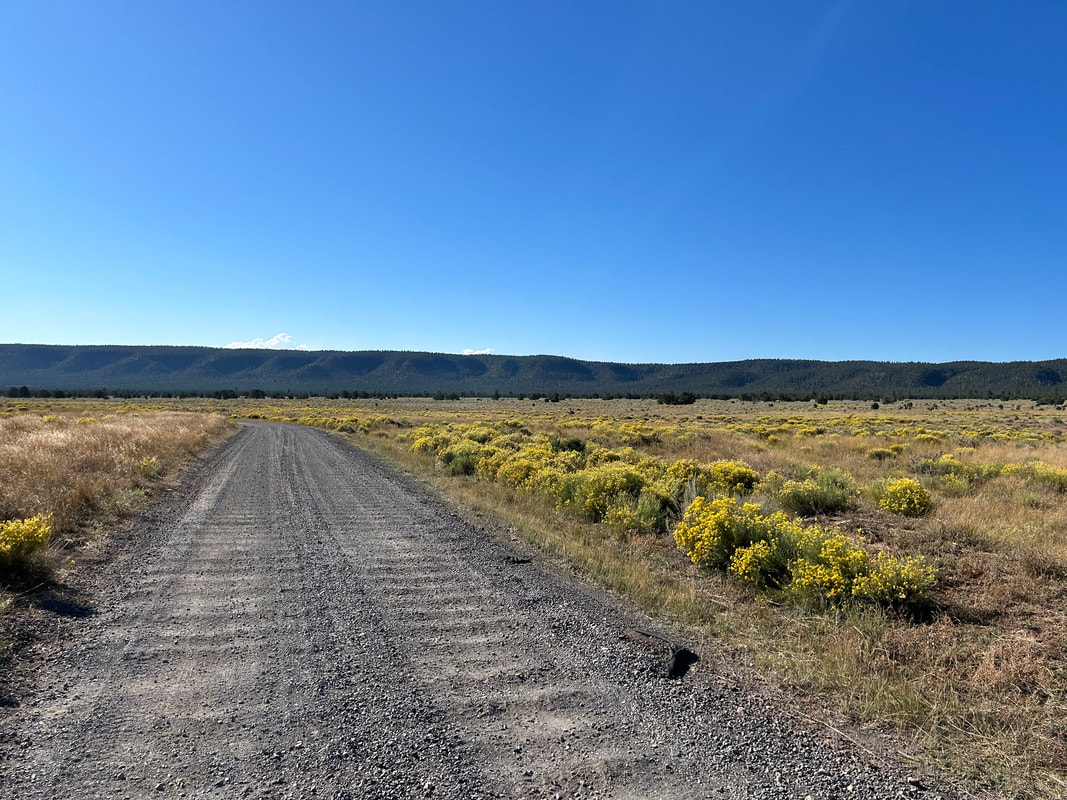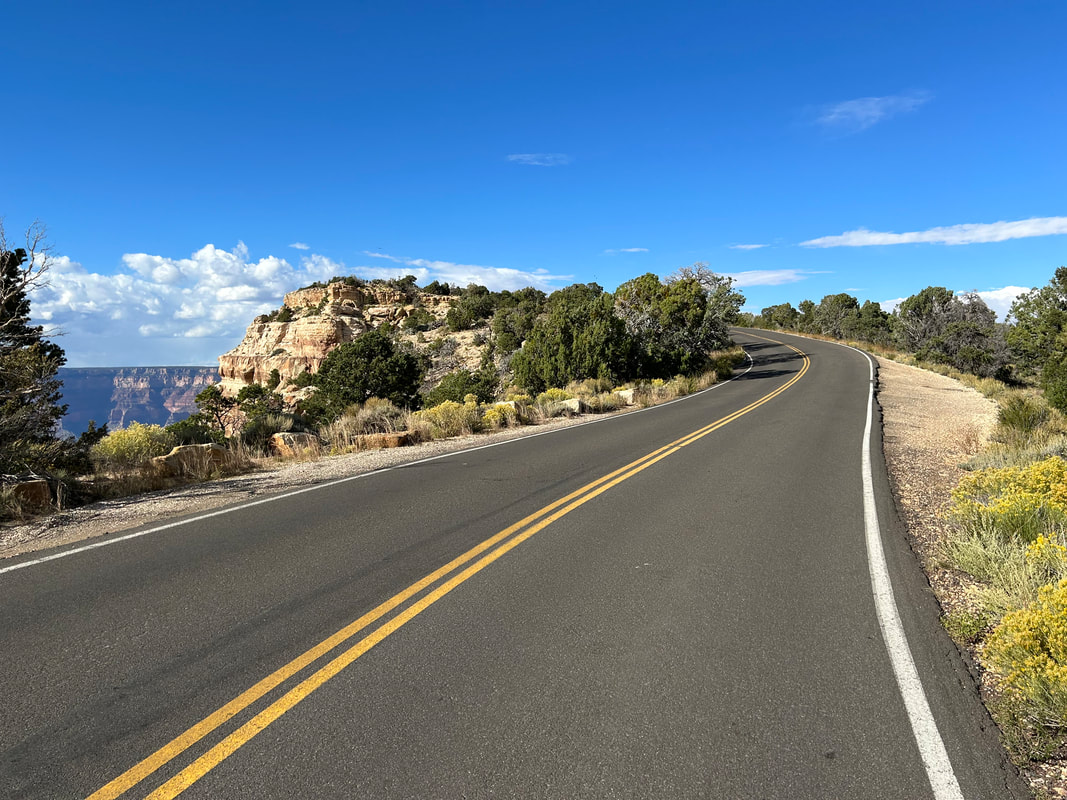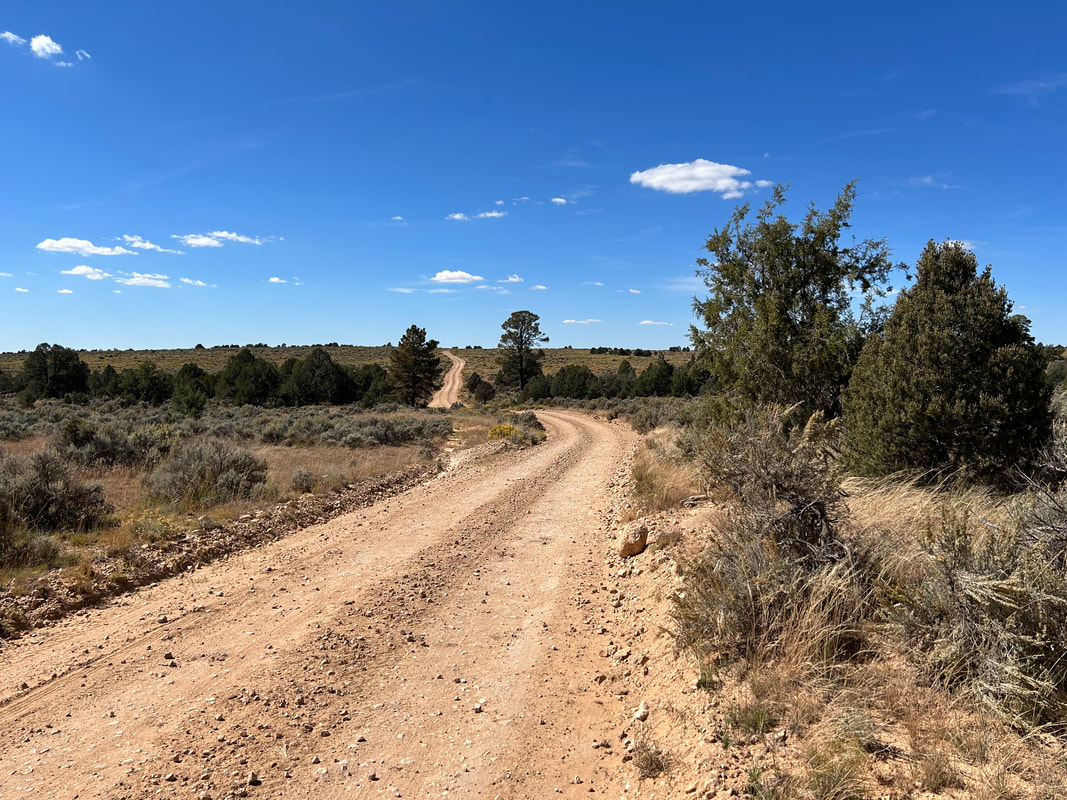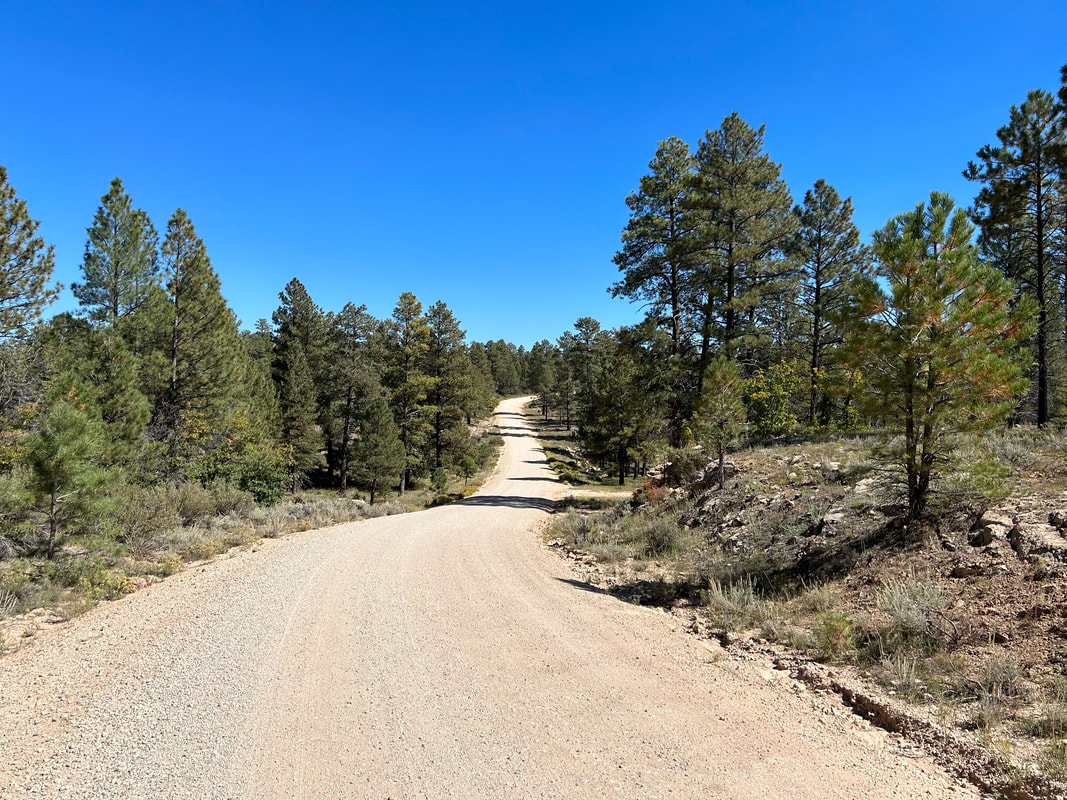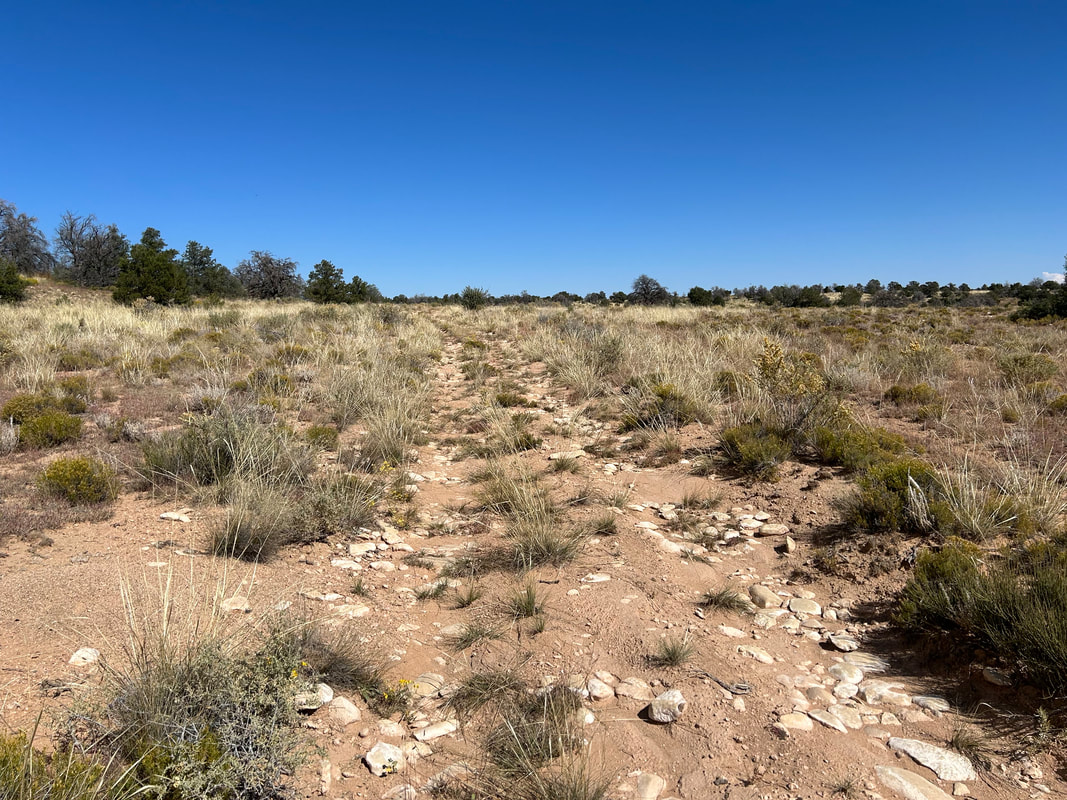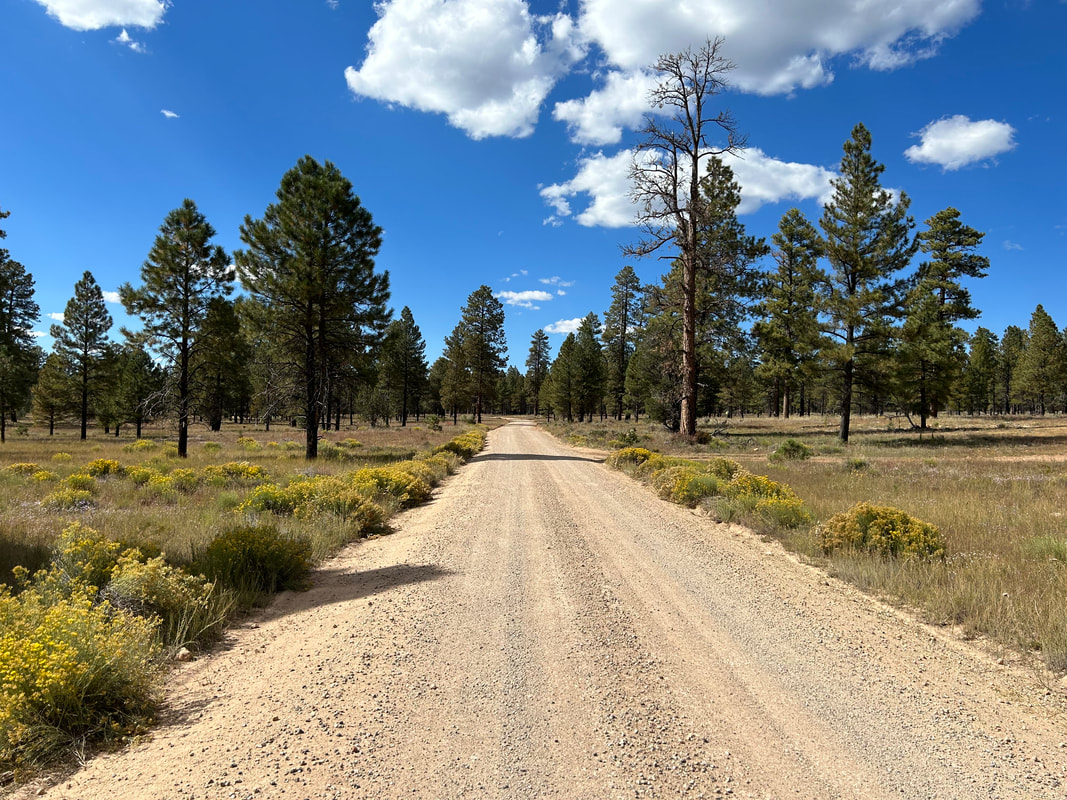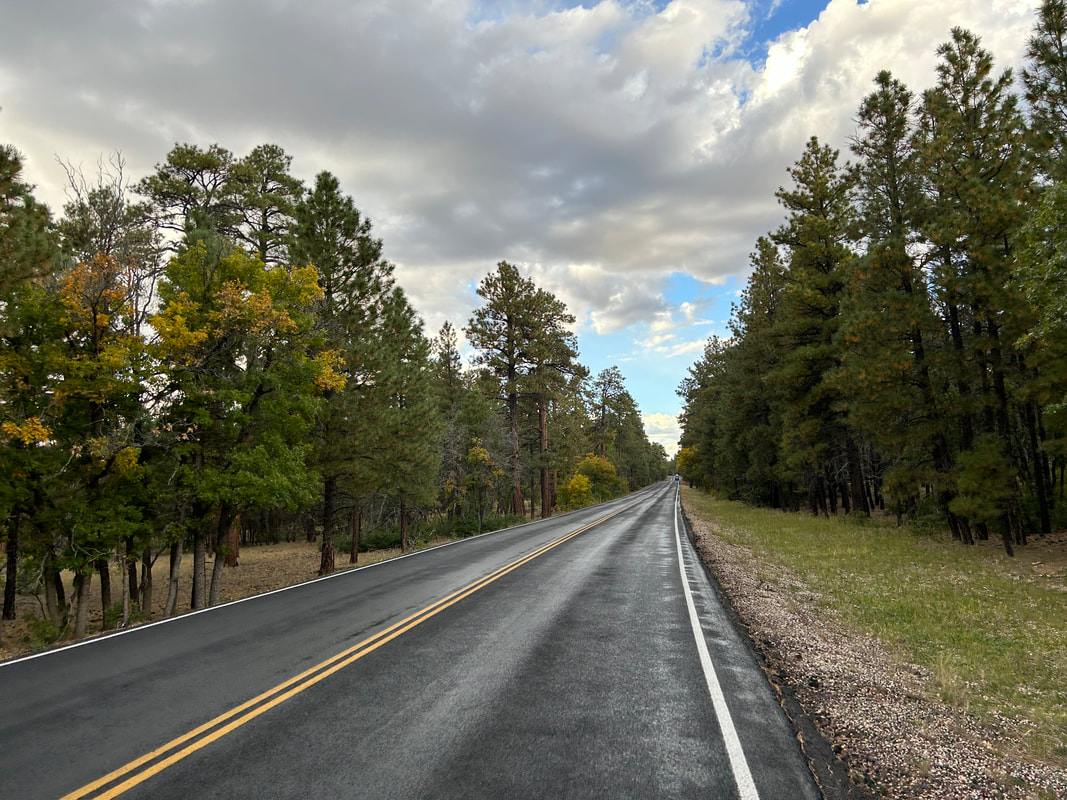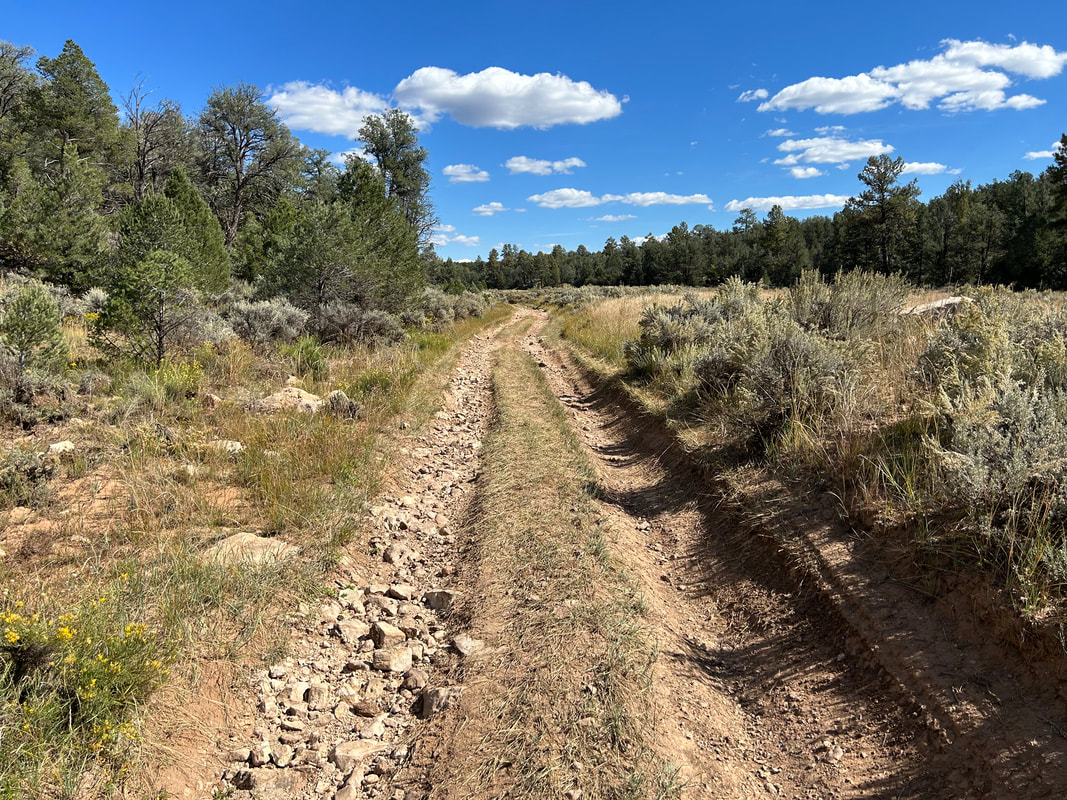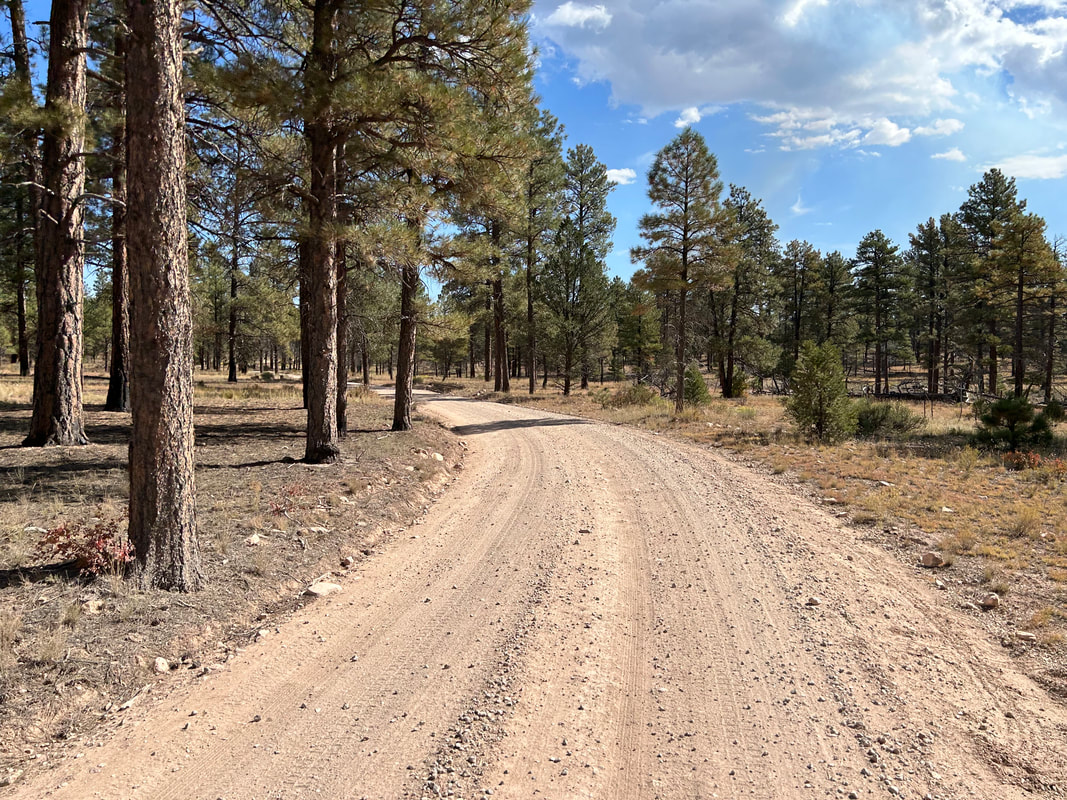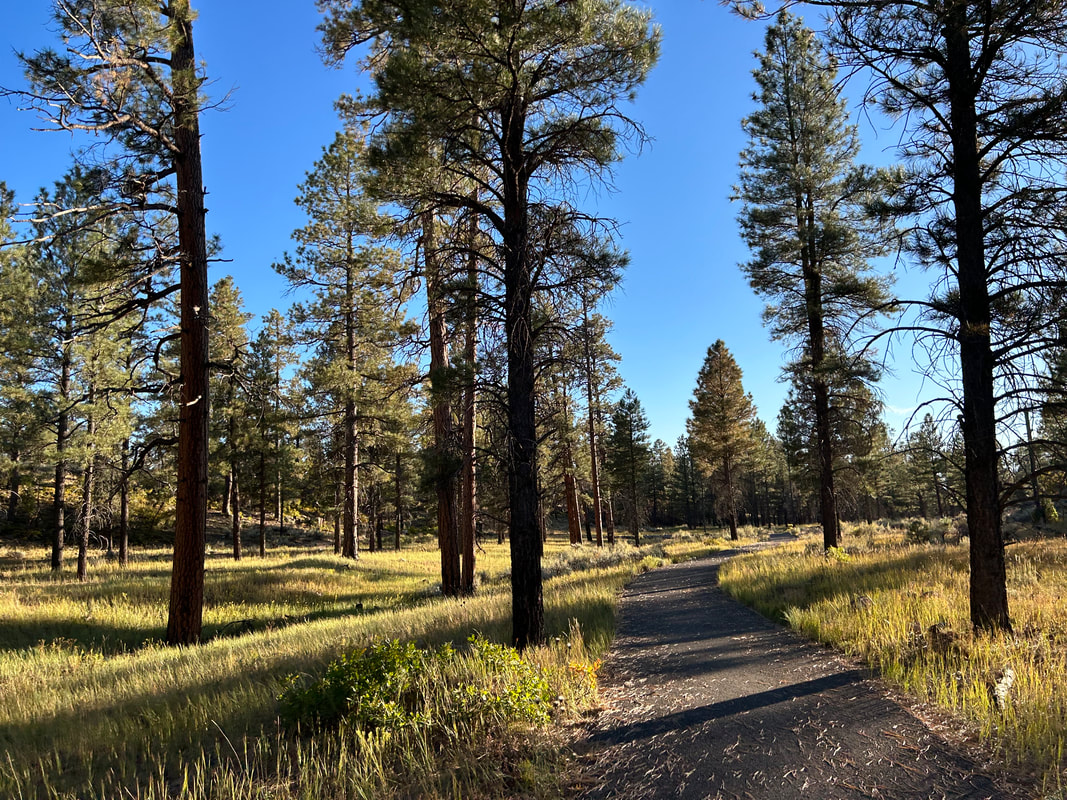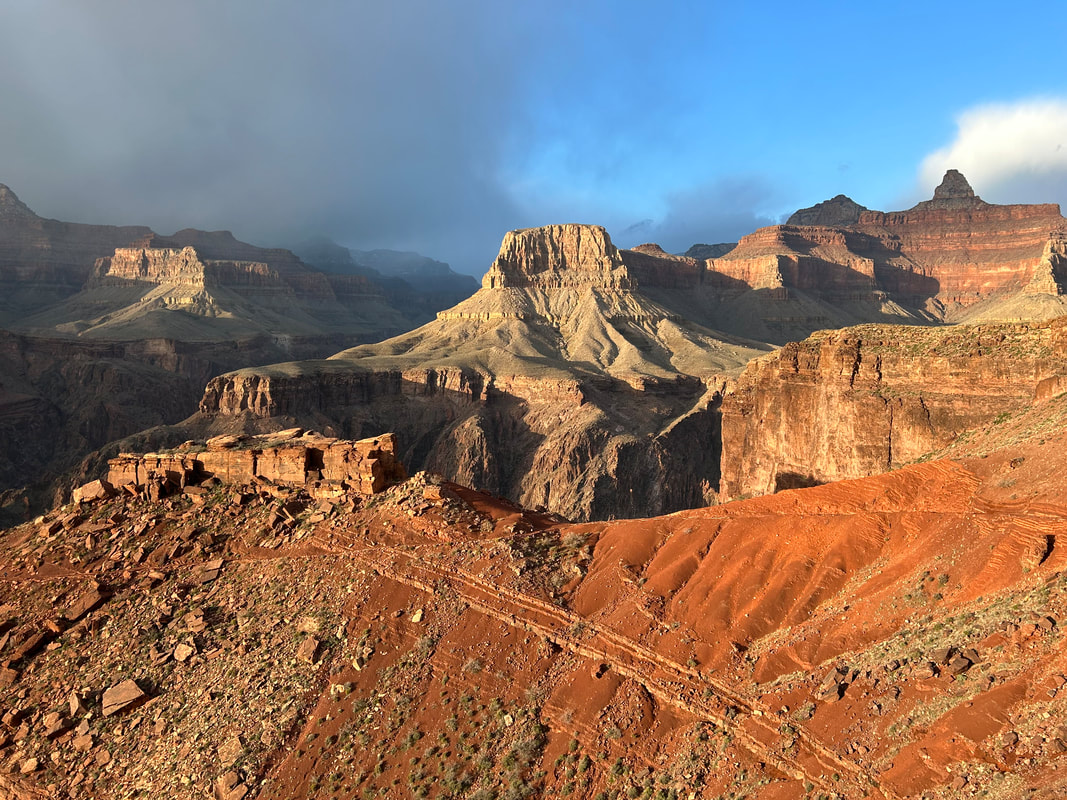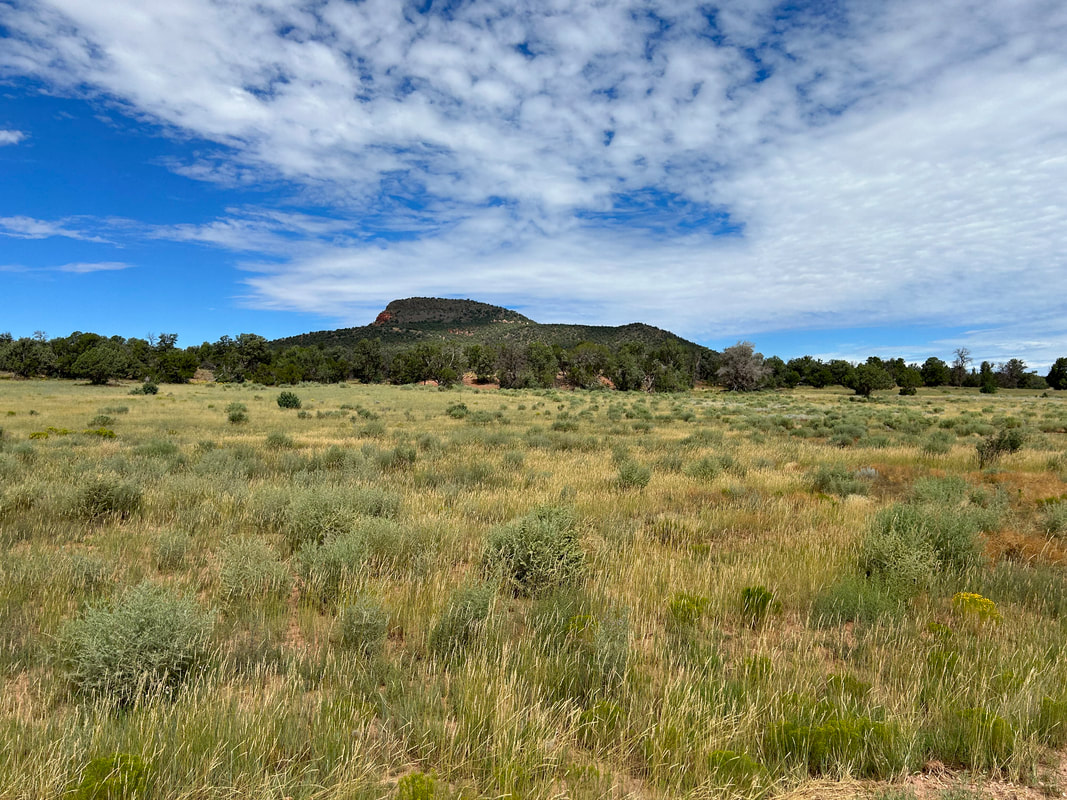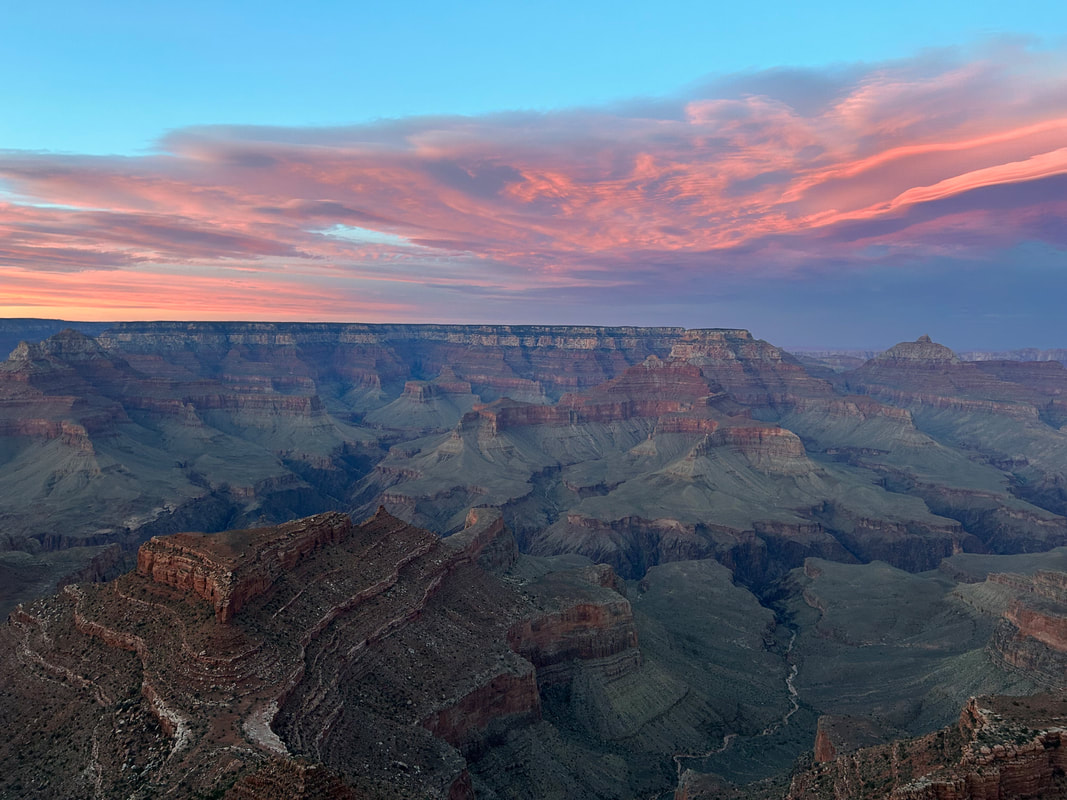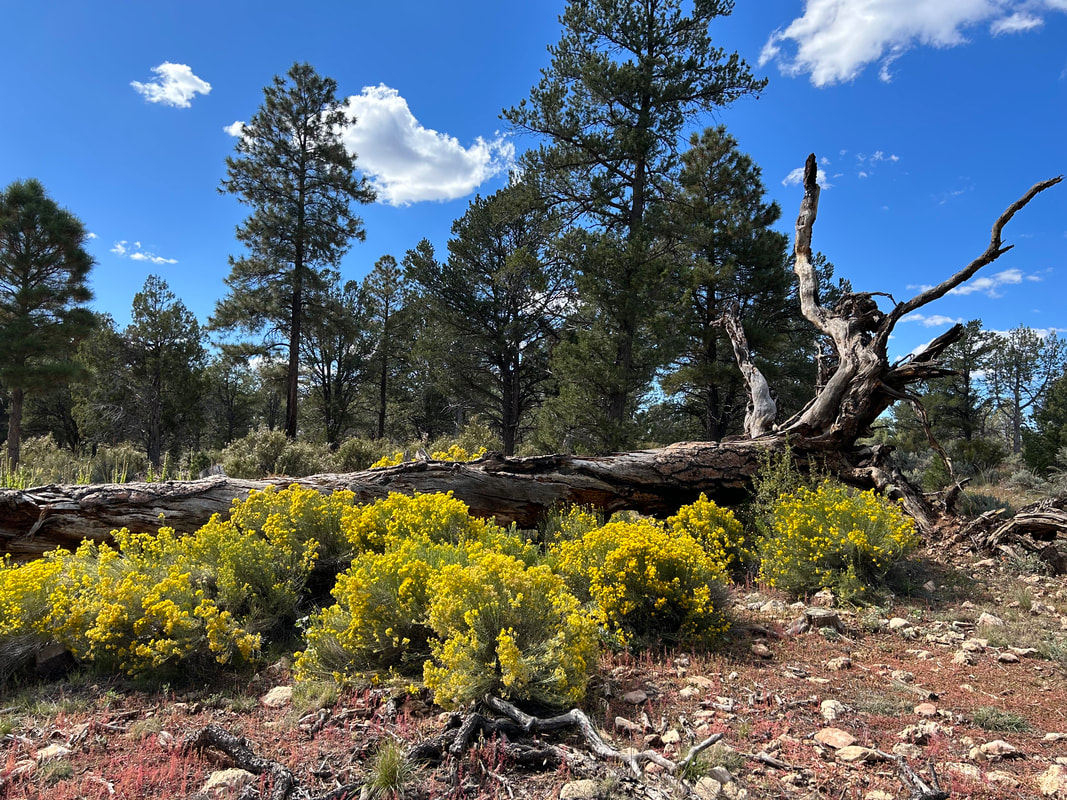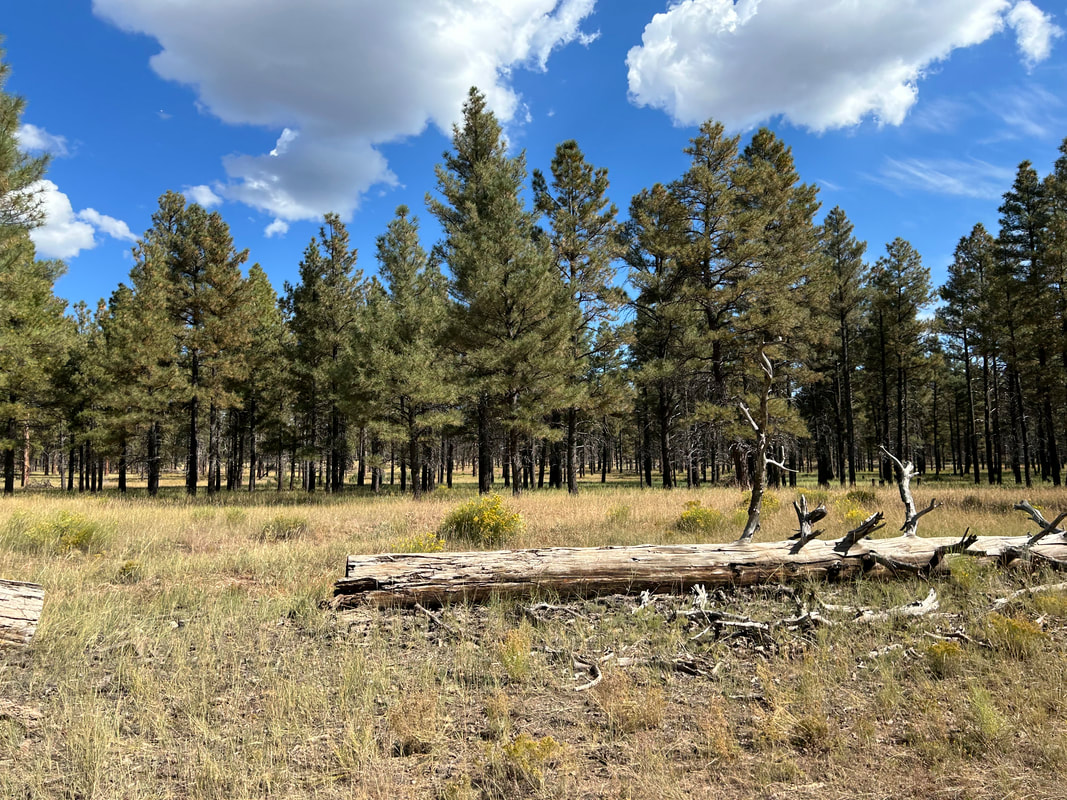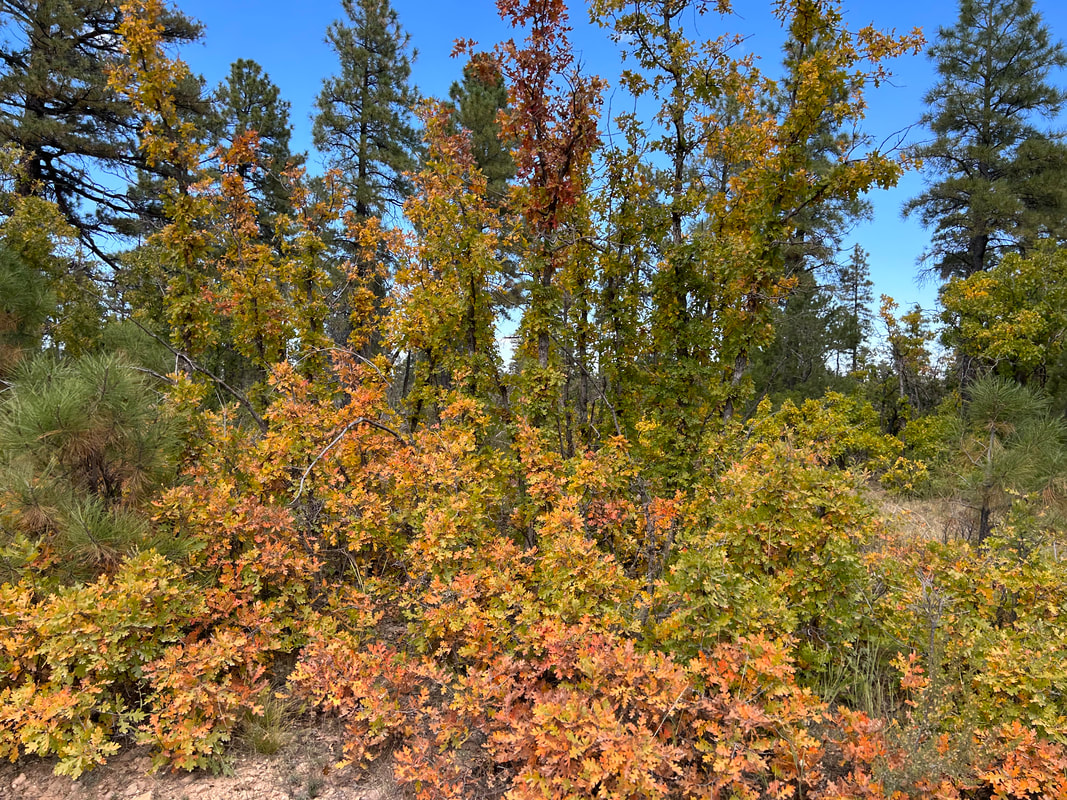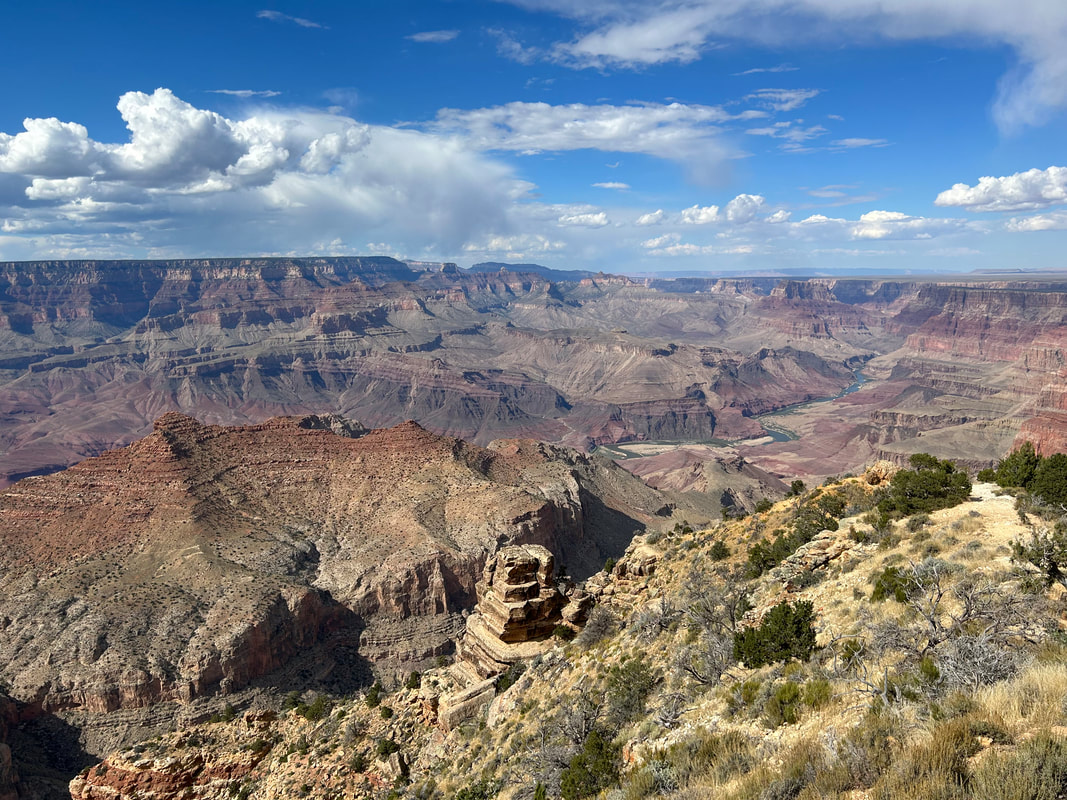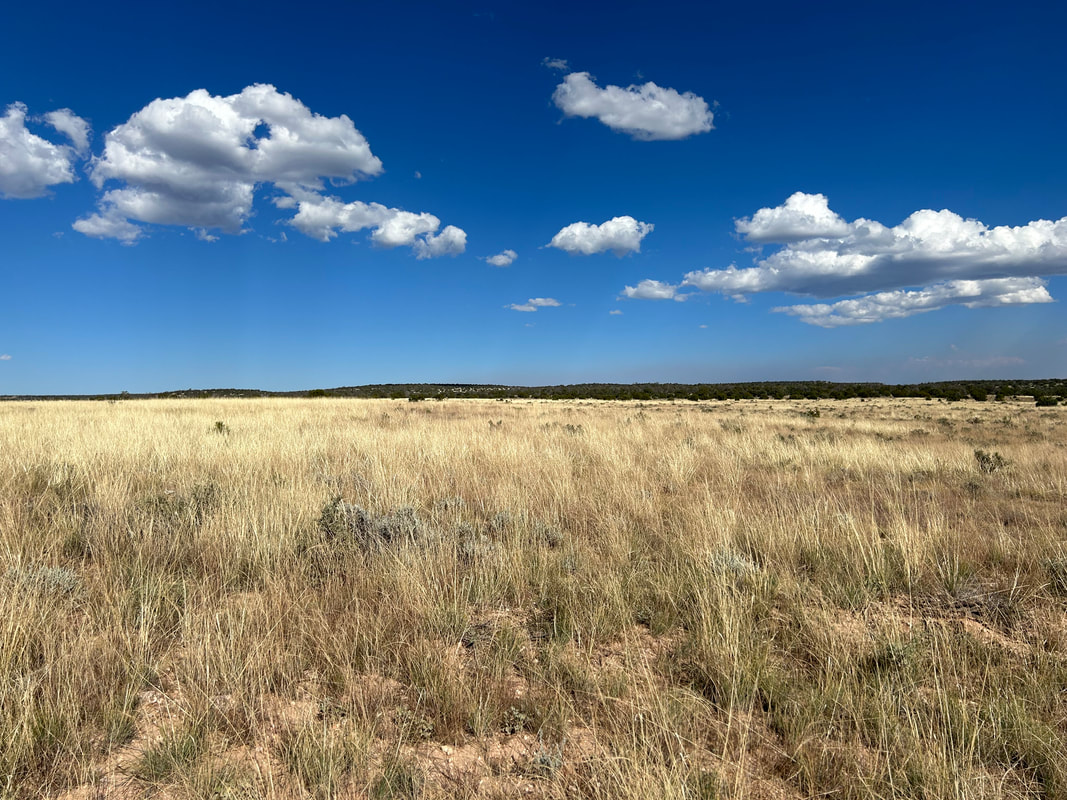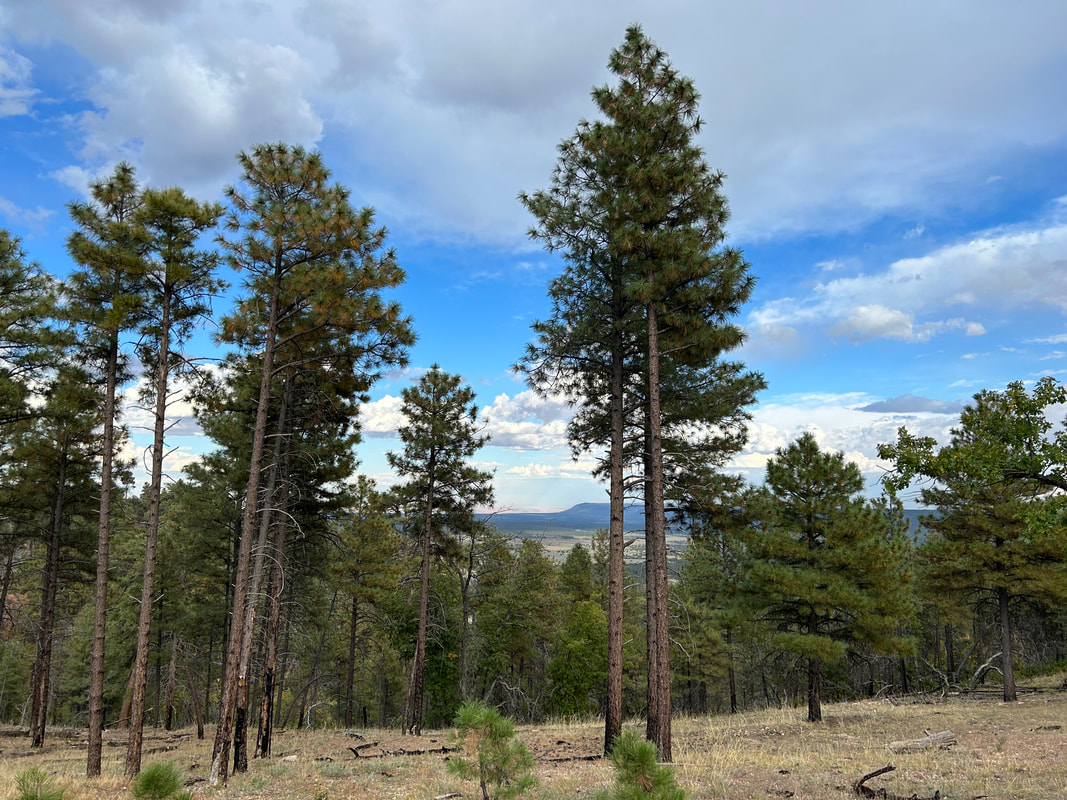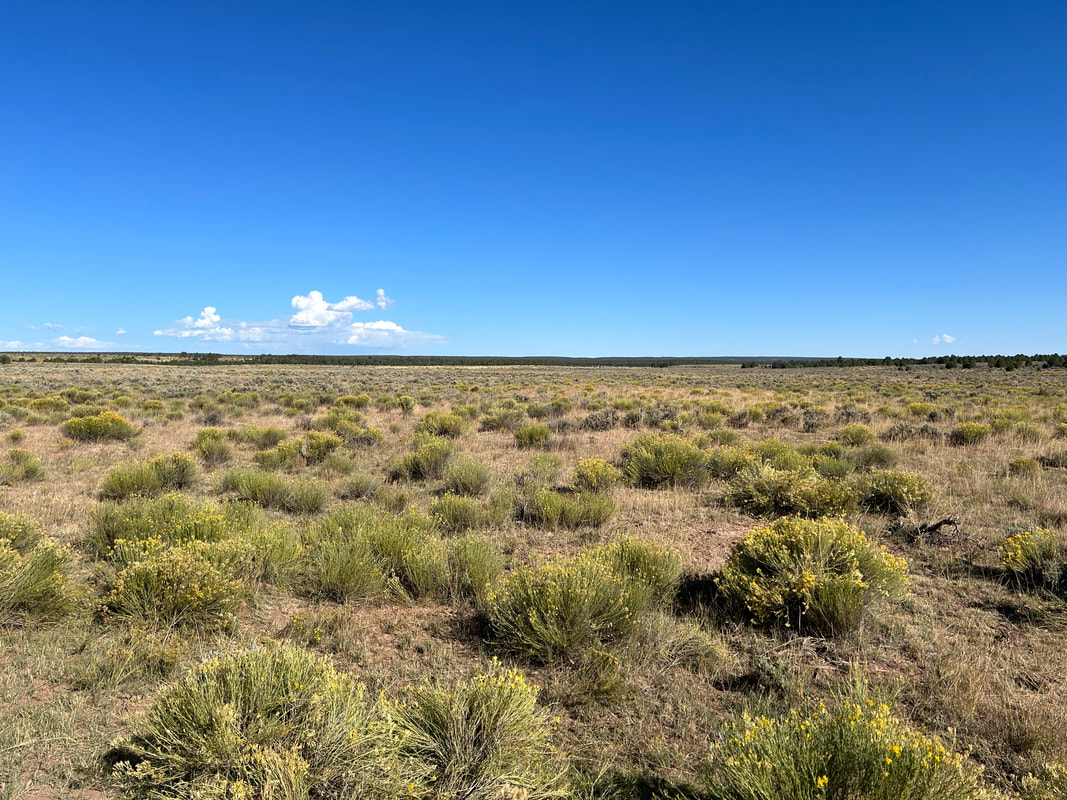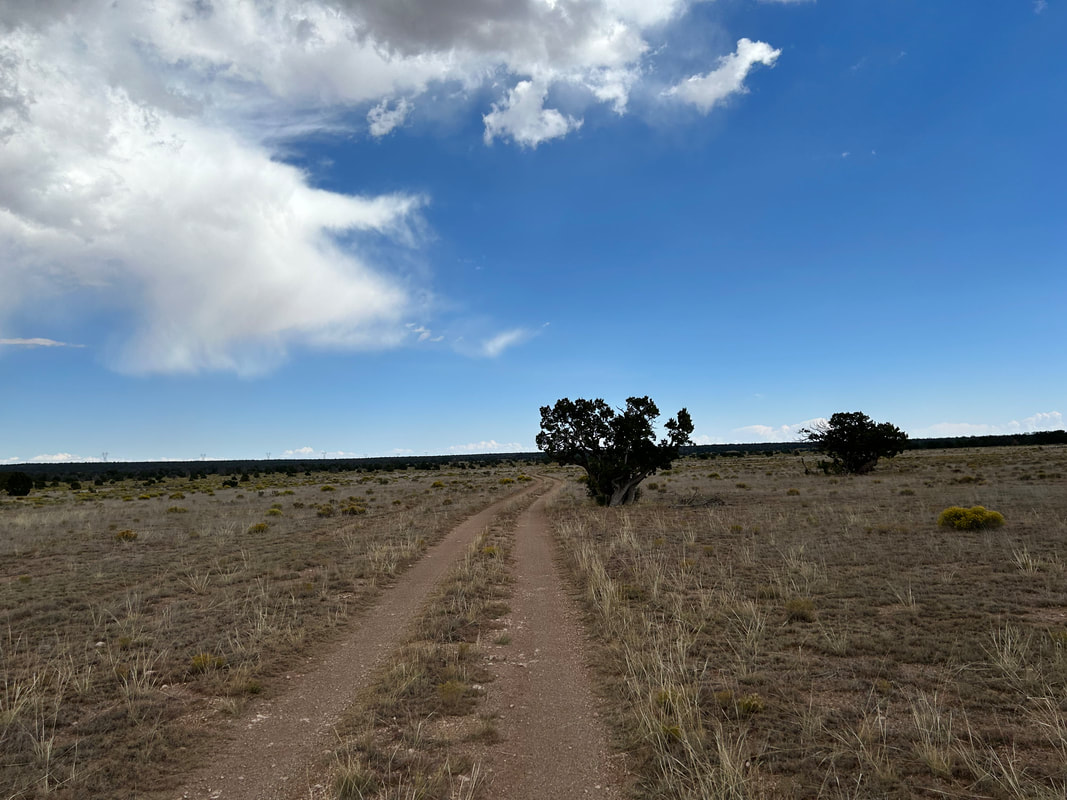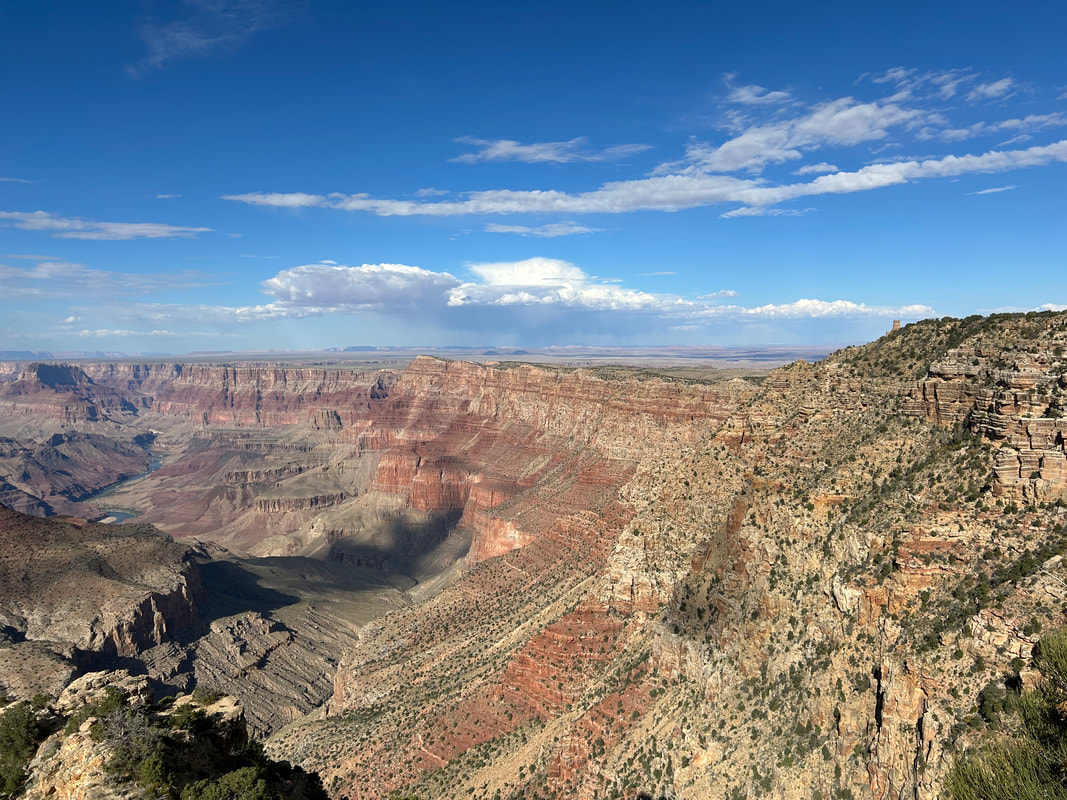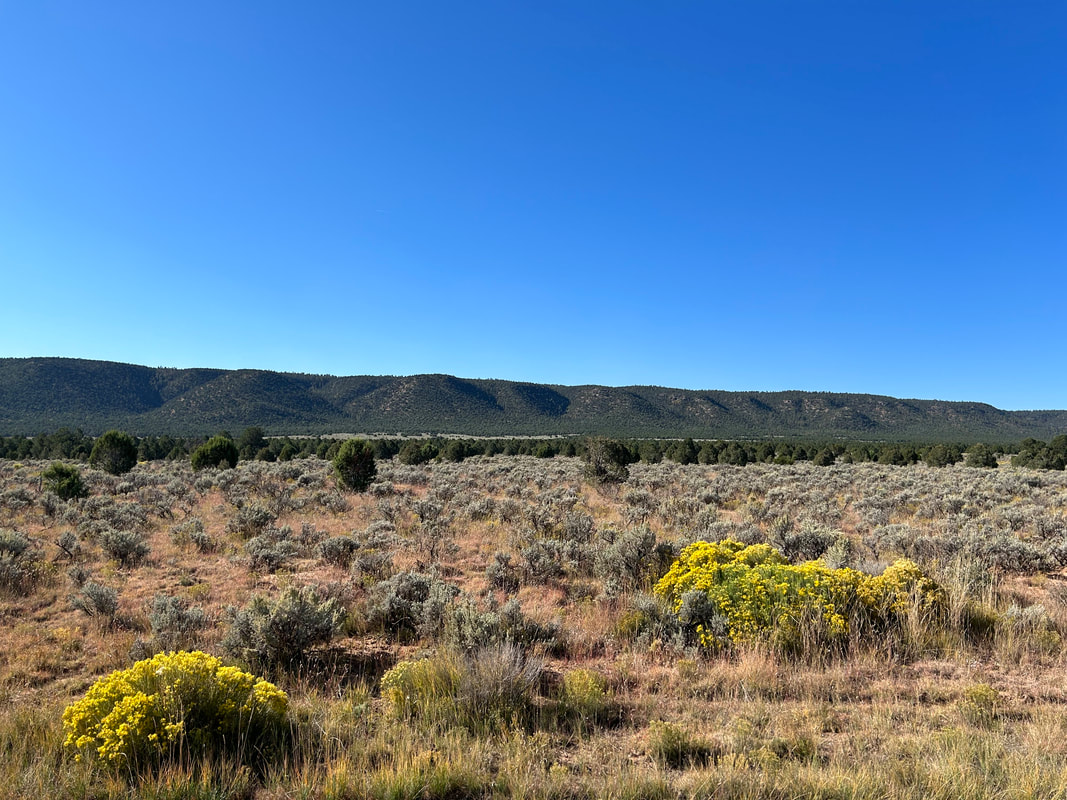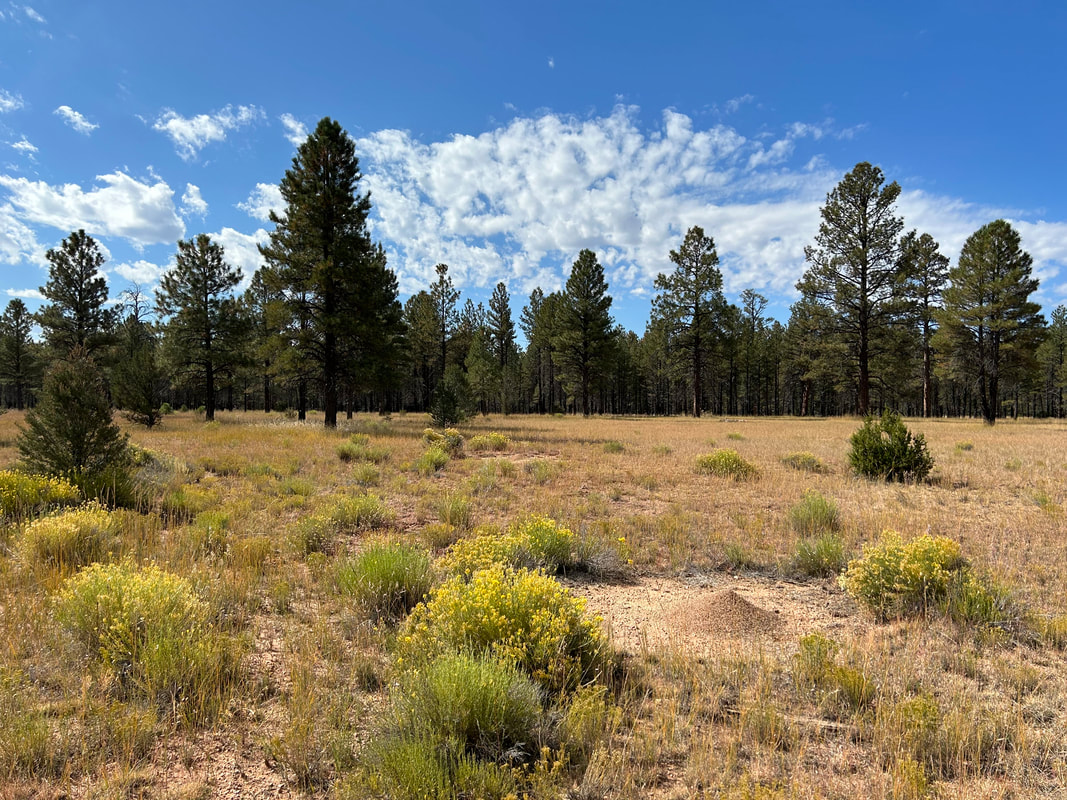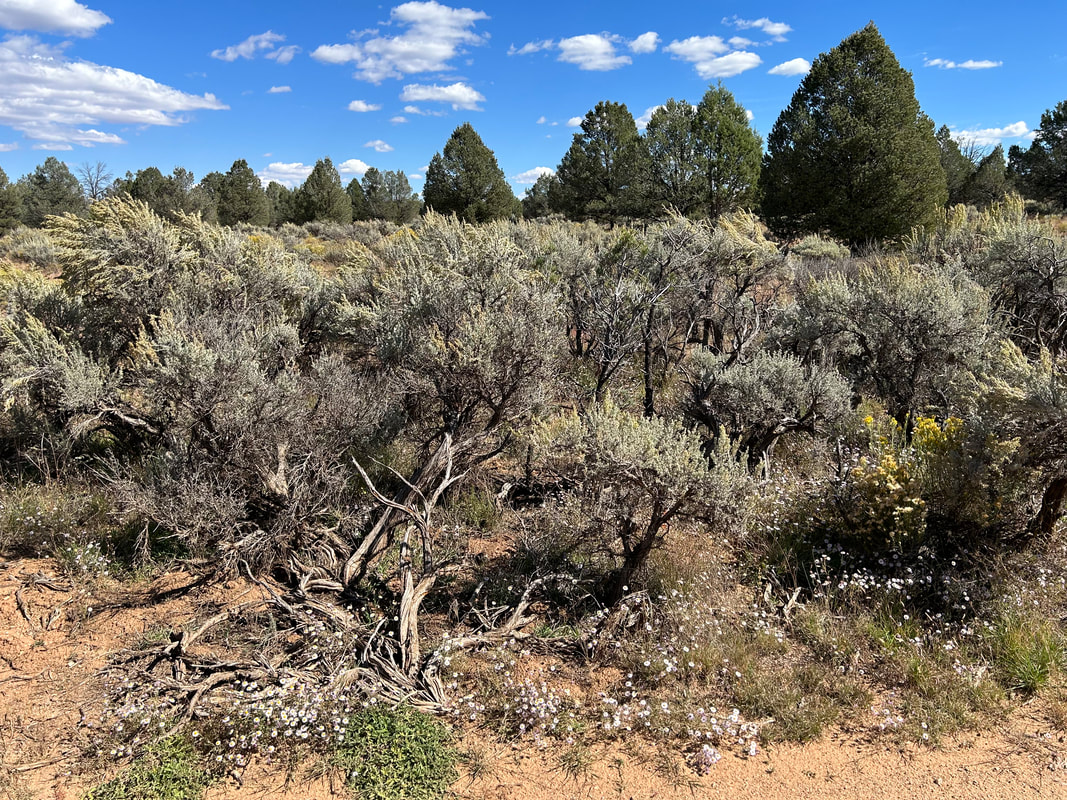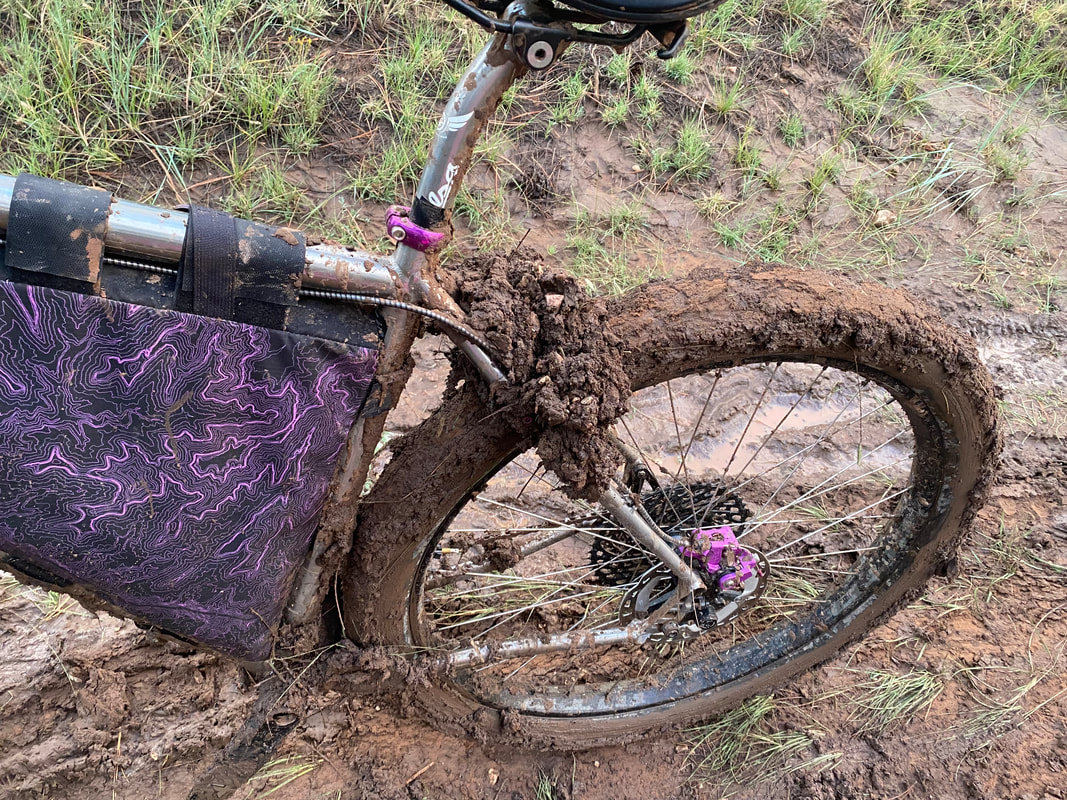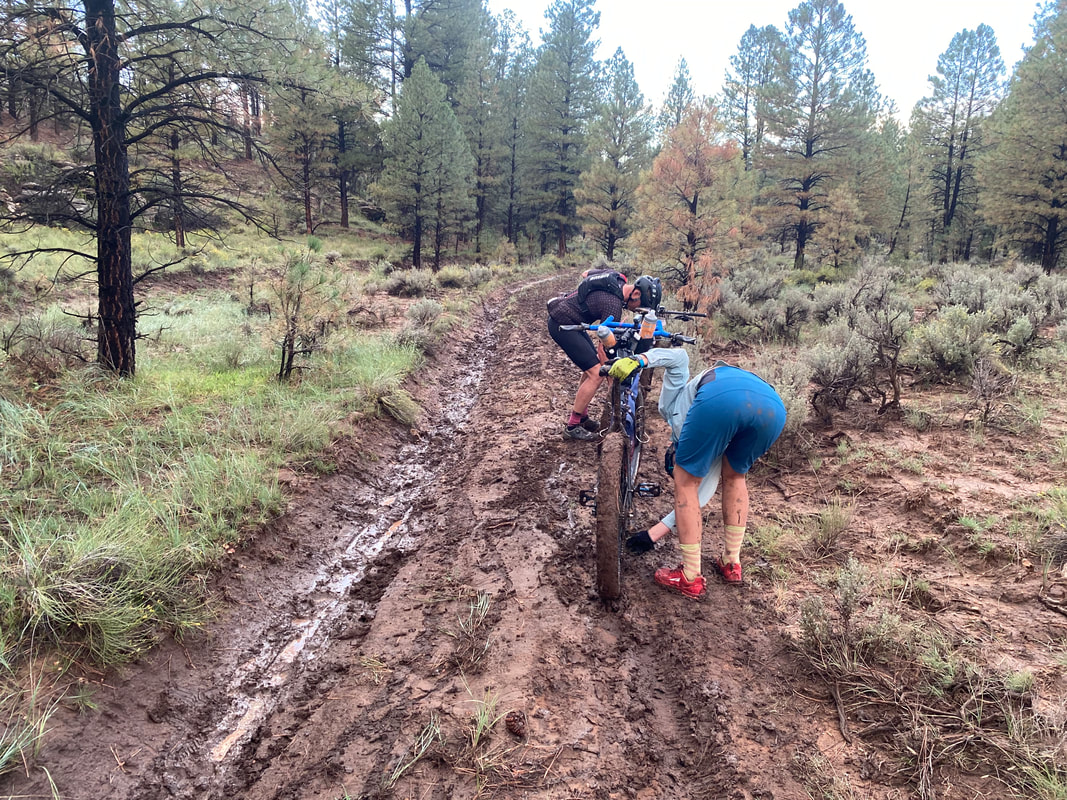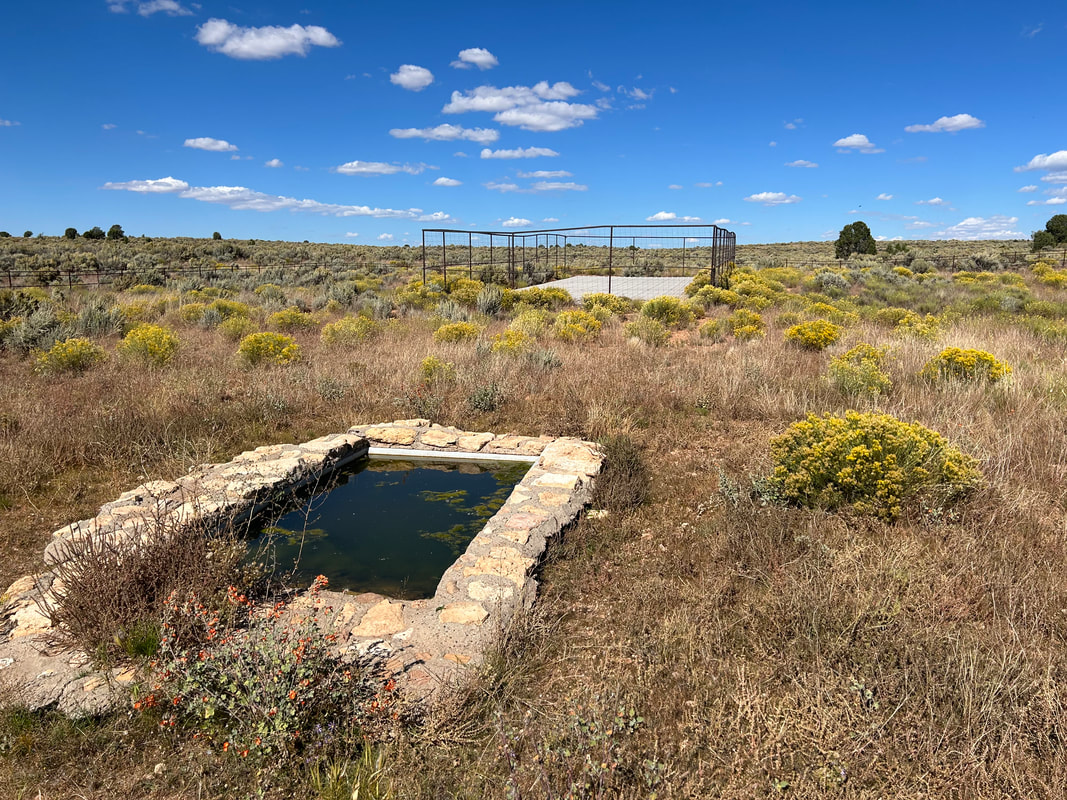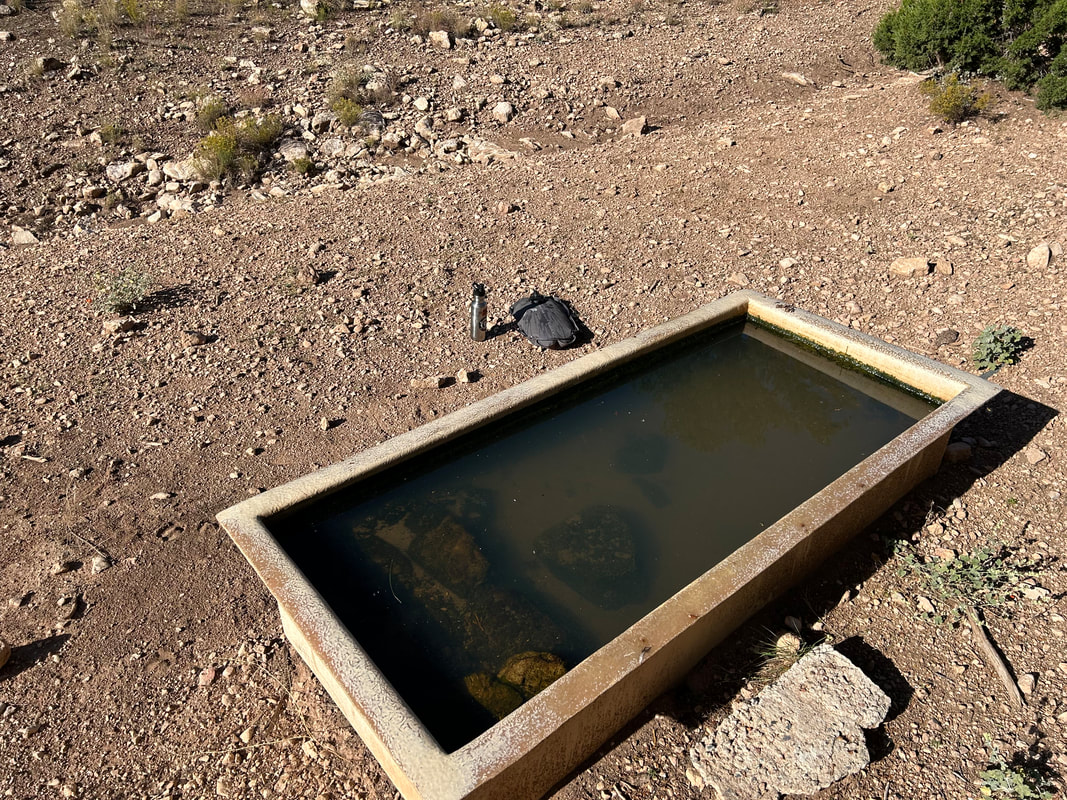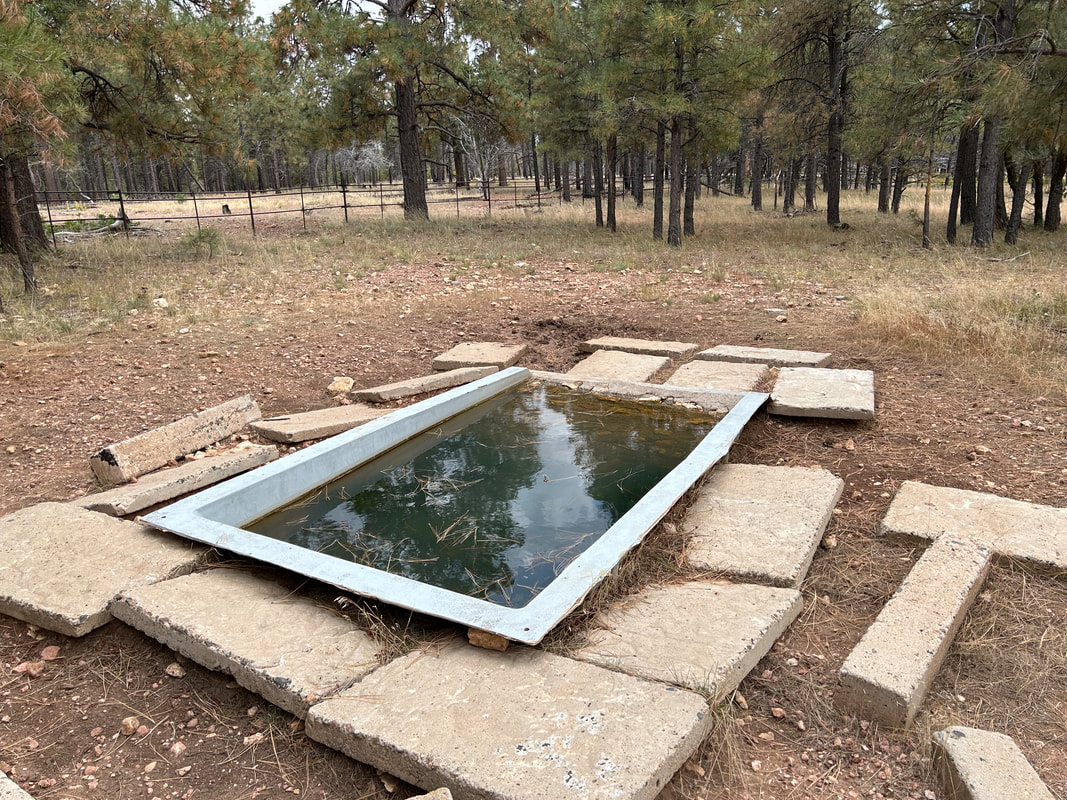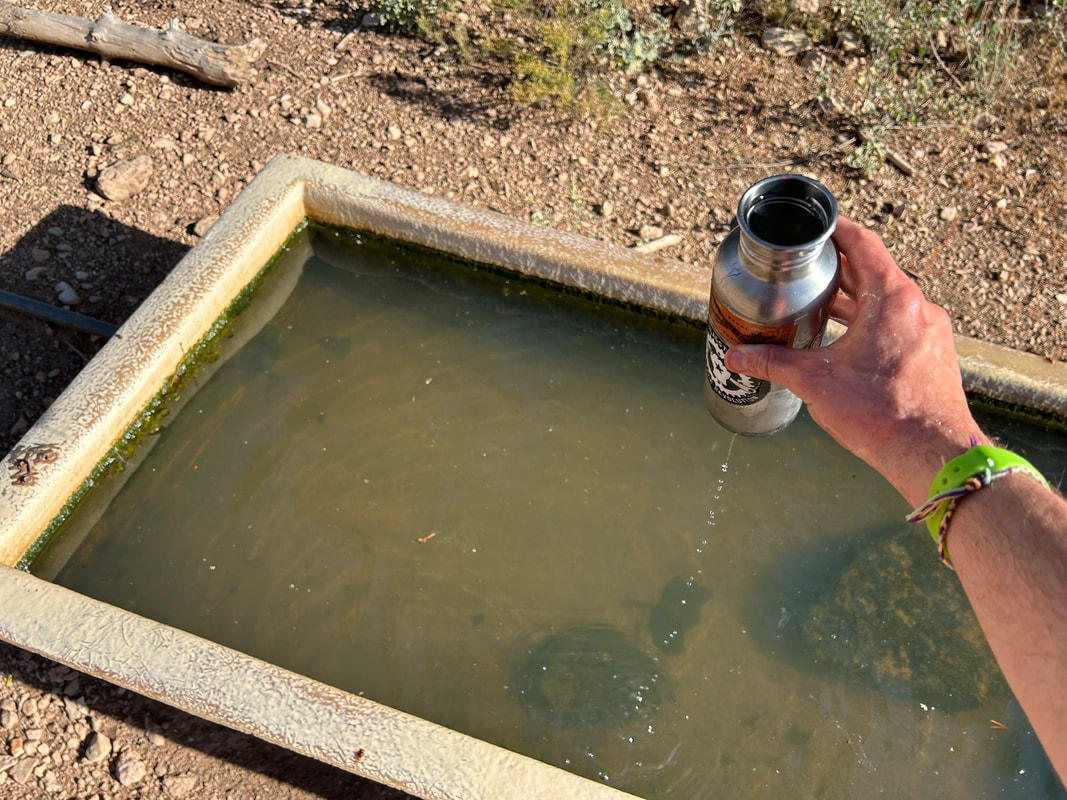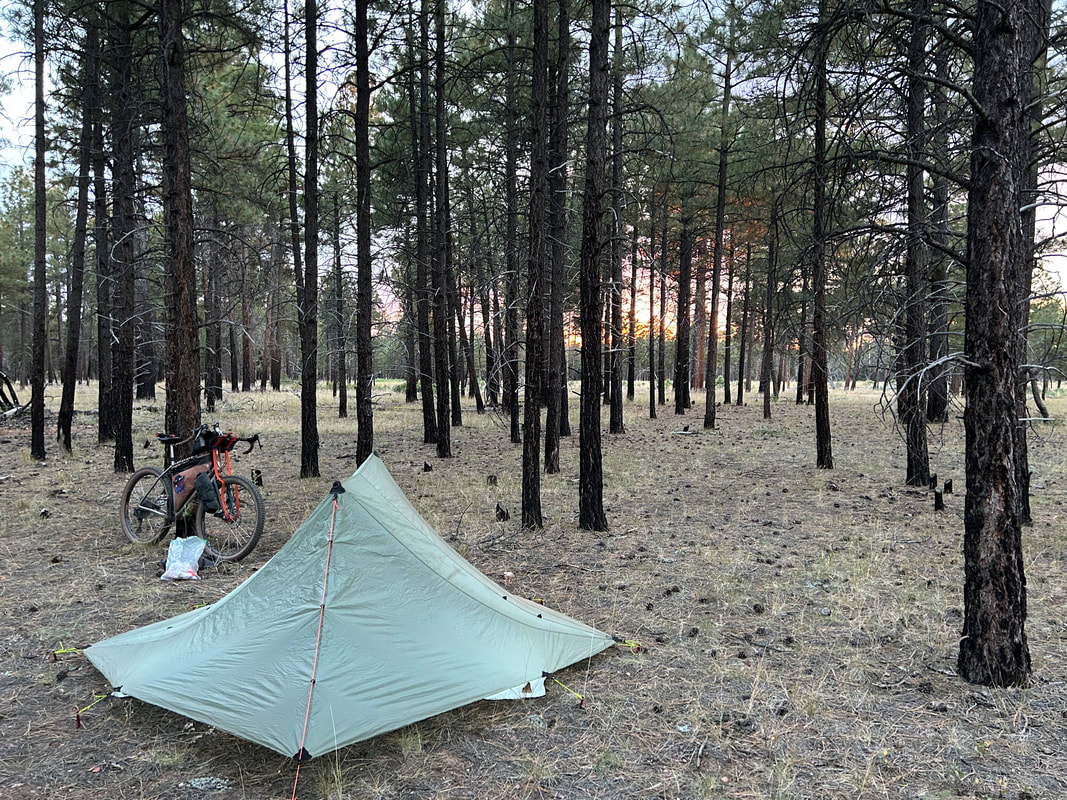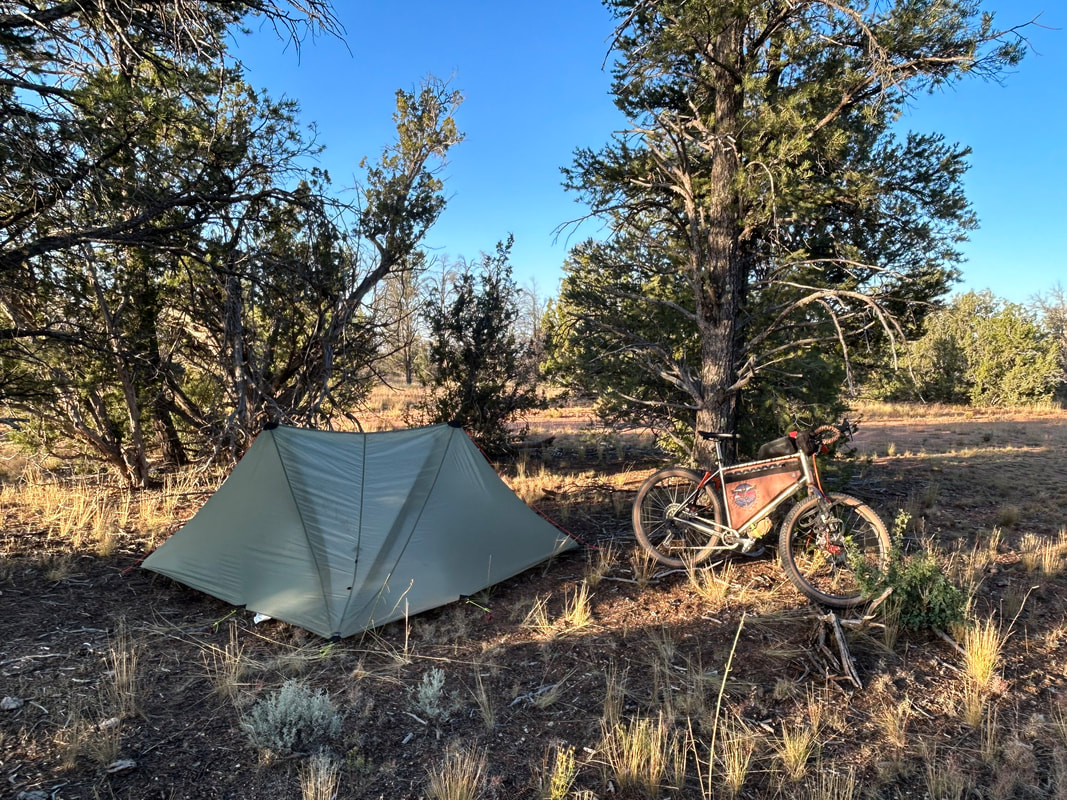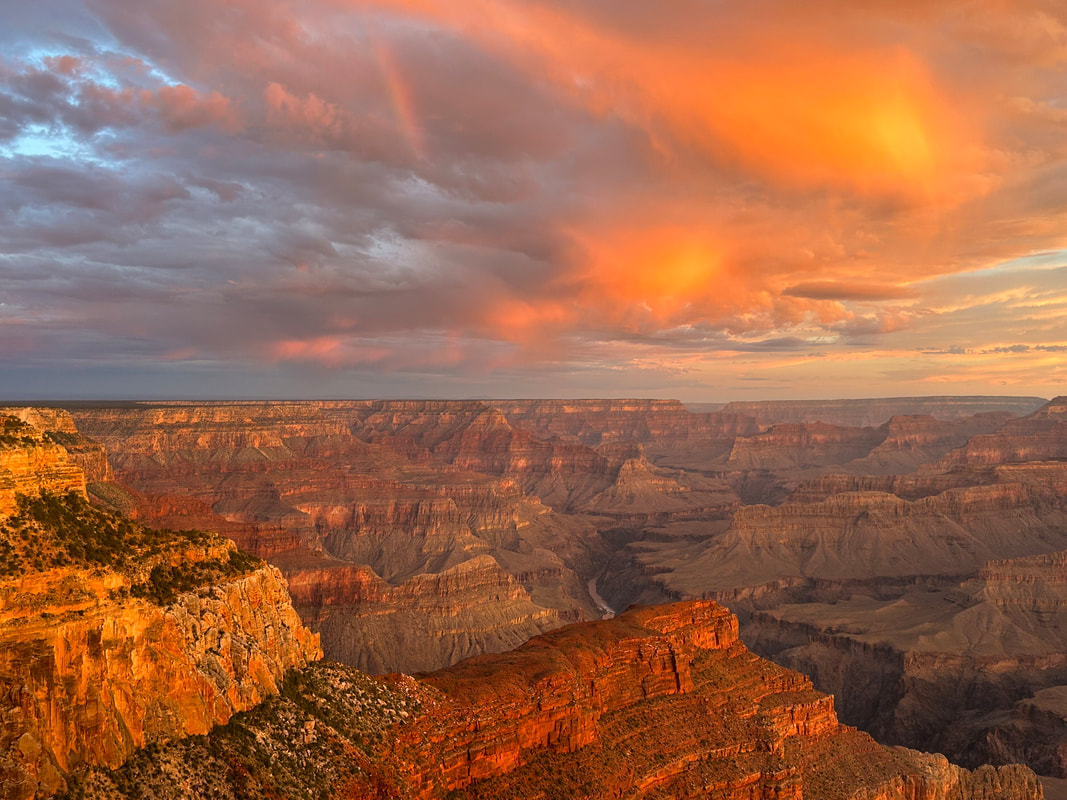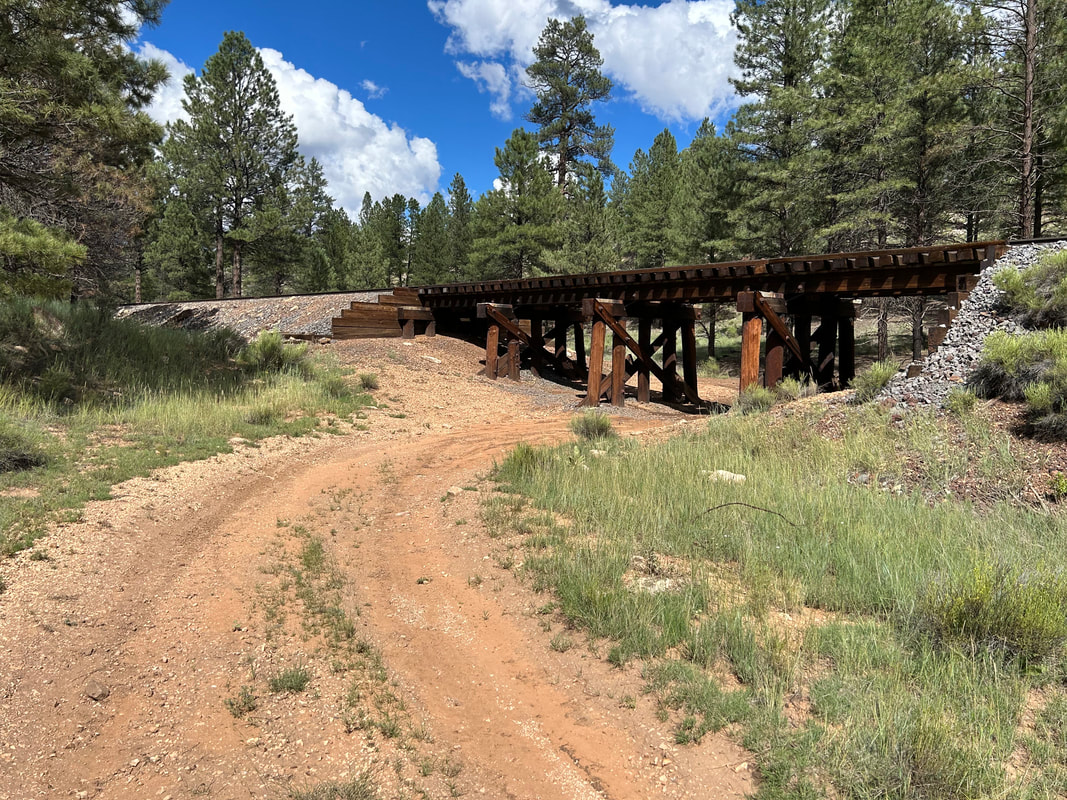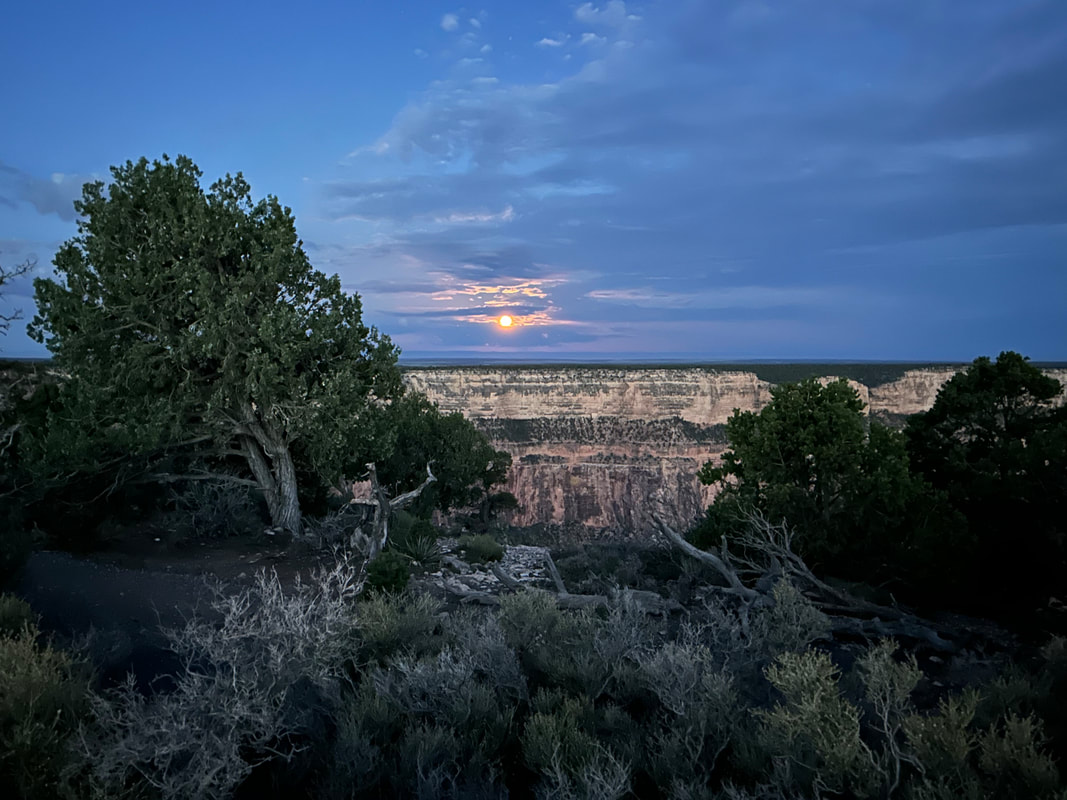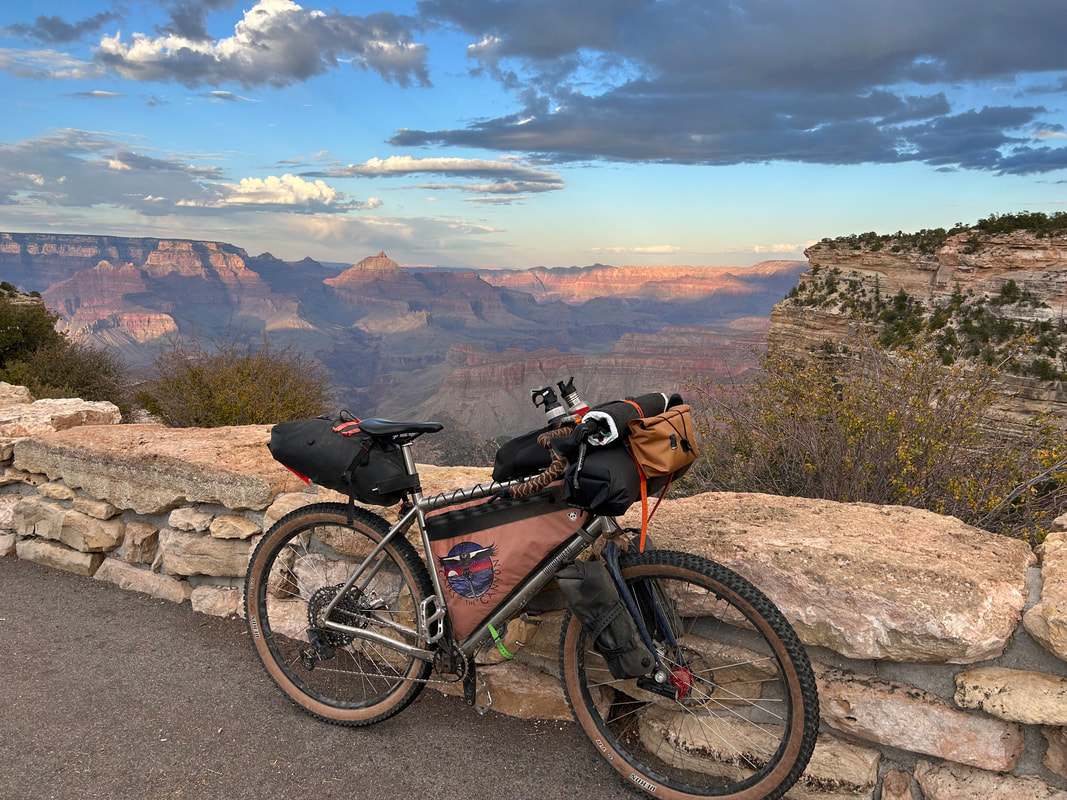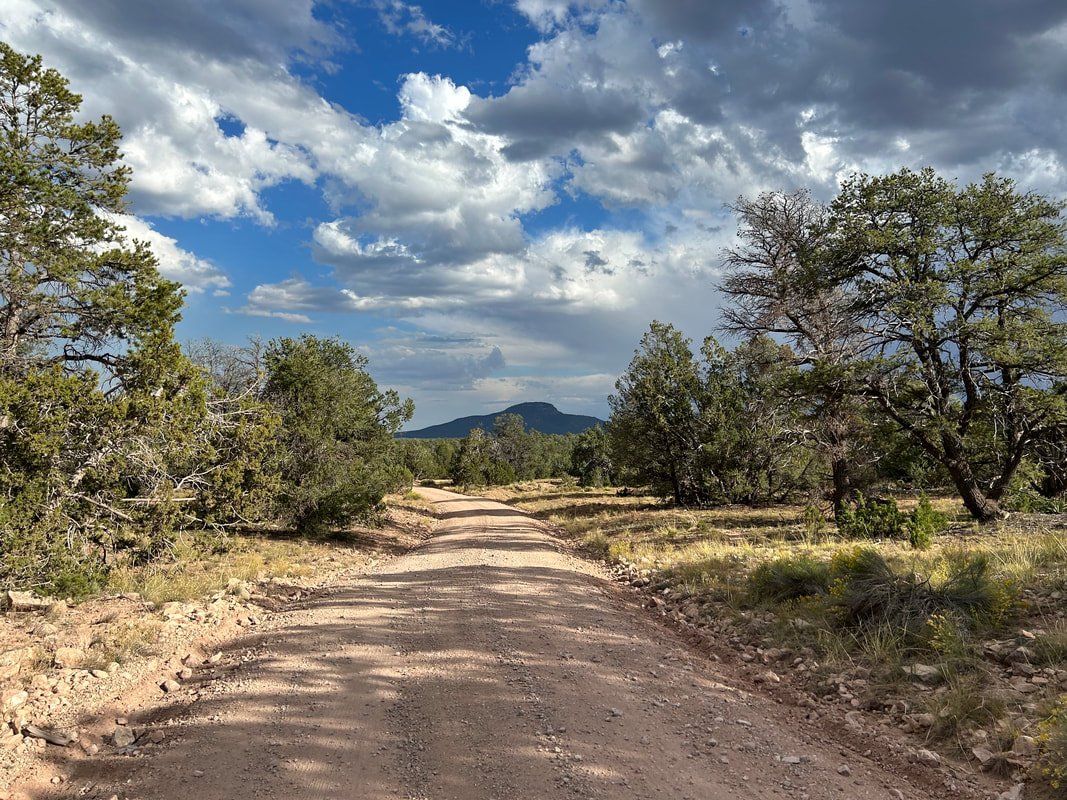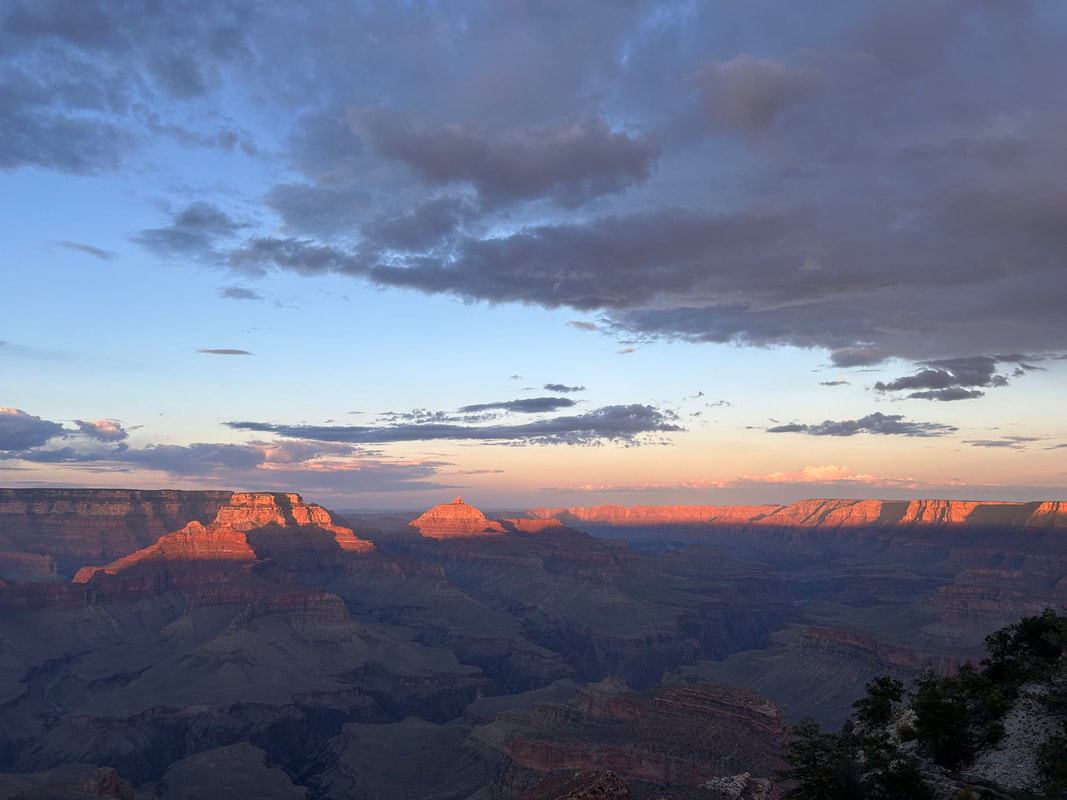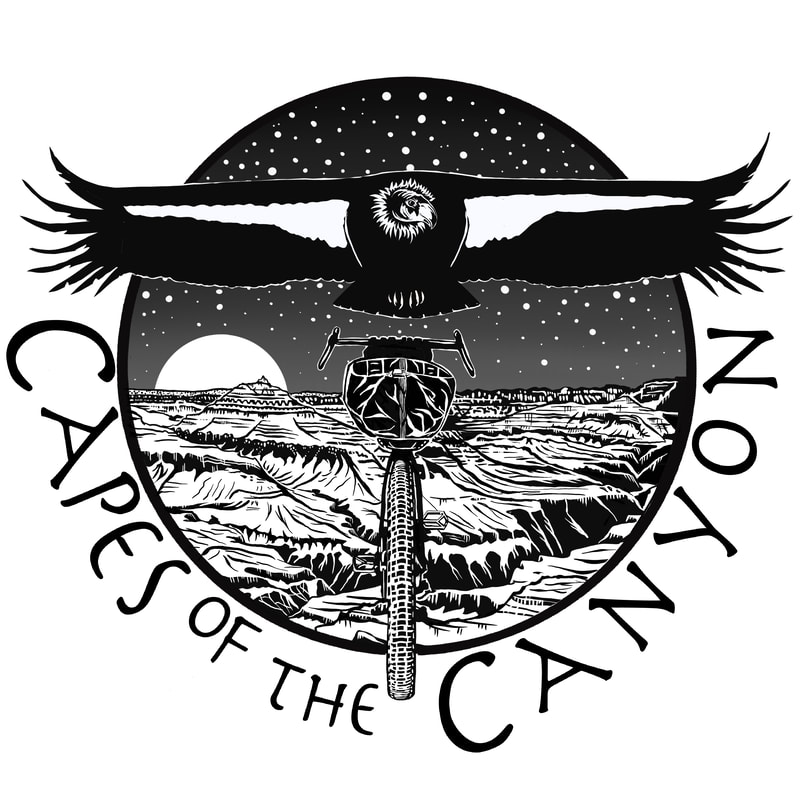1. Route Stats
Location |
Days to Ride |
Length |
Elevation Gain |
Number of Capes |
Grand Canyon - South Rim, Arizona, USA |
4-6 Days |
237.7 Miles |
12,068 Feet |
22 |
Physical Difficulty* |
Technical Difficulty* |
Seasons |
Tire Size |
4/10 |
5/10 |
Best: Late April - Early June Best: September - October Possible: Late June - Aug. |
Recommended: 2.5"-2.8"; Minimum Tire Size: 2.3" |
*Based on Bikepacking Roots Route Rating Scale (More info found under "Route Difficulty, Surface Conditions, and Direction to Ride"
2. South Rim Capes Overview
The Capes of the Canyon on the South Rim provides a backcountry ride through the southern landscape of Grand Canyon National Park and Baaj Nwaavjo I'tah Kukveni National Monument. From pinyon-juniper grasslands blanketing the base of Red Butte to towering ponderosa stands along the Coconino Rim that spill to limestone at Canyon edge, this route provides bikepackers an opportunity to see the Grand Canyon region. The goal of the route is to hit every bike-legal track that takes a rider to views of the Grand Canyon along the South Rim. The bonus is a backcountry ride though the arid evergreen woodlands and exposed highland geology of the Colorado Plateau along the way. Capes include the Little Colorado River Gorge, Desert View, Navajo, Lipan, Moran, Grandview, Duck on a Rock, Shoshone, Yaki, Pipecreek Vista, Mather, Yavapai, Trailview Overlook, Maricopa, Powell, Hopi, Mohave, The Abyss, Monument Creek Vista, Pima, Hermit's Rest, South Bass, and Havasupai.
Riders start in the conifers of Tusayan, AZ before descending to grasslands for a perimeter ride around sage-swathed Red Butte. Heading east, cyclists ride through ponderosa forests and across the vast pinyon-juniper savannas of Ancestral Footprints of the Grand Canyon National Monument before climbing to the high point of the route at 7,500 feet near Grandview and its namesake fire tower. Here, bikepackers can catch glimpses of the red-washed Canyon heart through the dark evergreens of the forest. Riders descend and trace the base of the Coconino Rim before getting a view of the Little Colorado River Gorge. After entering Grand Canyon National Park, bikepackers get their first expansive view of the Canyon at Desert View. Catch glimpses of the Colorado River pulsing with sediment down its spine. Cyclists continue along a spread of twenty-two South Rim capes, ride out through plains of sage to remote South Bass, and then plunge back into the forest before returning to Tusayan. For bikepackers camped at the more remote areas on the route, stare up at the stars each night for exceptional Dark Skies and clear views of the Milky Way.
Riders start in the conifers of Tusayan, AZ before descending to grasslands for a perimeter ride around sage-swathed Red Butte. Heading east, cyclists ride through ponderosa forests and across the vast pinyon-juniper savannas of Ancestral Footprints of the Grand Canyon National Monument before climbing to the high point of the route at 7,500 feet near Grandview and its namesake fire tower. Here, bikepackers can catch glimpses of the red-washed Canyon heart through the dark evergreens of the forest. Riders descend and trace the base of the Coconino Rim before getting a view of the Little Colorado River Gorge. After entering Grand Canyon National Park, bikepackers get their first expansive view of the Canyon at Desert View. Catch glimpses of the Colorado River pulsing with sediment down its spine. Cyclists continue along a spread of twenty-two South Rim capes, ride out through plains of sage to remote South Bass, and then plunge back into the forest before returning to Tusayan. For bikepackers camped at the more remote areas on the route, stare up at the stars each night for exceptional Dark Skies and clear views of the Milky Way.
Blog Journal + Daily Photos of the Route
3. Map and GPX
Surface Color Guide
- Purple = Improved Dirt Surface (2WD, Wider, Smoother, Better Maintained, Intact, Graded, etc.)
- Red = Rugged Dirt Surface (4WD, Doubletrack, Rough, Less Maintained, etc.)
- Brown = Primitive Dirt Surface (Particularly Rocky, Rutted, and Eroded)
- Black = Singletrack
- Blue = Vehicle Pavement
- Green = Paved Bike Path
Route Guide Sections
- Route Stats
- Route Overview
- Map and GPX
- Alerts and Closures
- Route Design Philosophy and Vision
- Route Passages
- Route Description
- Route Difficulty, Surface Conditions, and Direction to Ride
- When to Ride (Temperature + Climate)
- South Rim vs. North Rim Capes
- Capes Connectors
- Ecoregions and Landscape
- Where Bikes Are Allowed and Not Allowed
- Native Nations and This Land
- Leave No Trace and Bikepacking Ethics for the Colorado Plateau
- Water Sources
- Camping
- Food and Resupplying
- Sample Route Itinerary
- Fees and Permits
- Getting to the Start
- Parking
- Additional Important Information
- Other Rides in the Area
- Acknowledgments
- Social Media and Route Updates
4. Alerts and Closures
The Southwest is a dynamic region. The Capes of the Canyon is subject to wildfires, flash floods, extreme heat, blizzards, monsoon storms, and death mud. Grand Canyon National Park, Kaibab National Forest, and the Bureau of Land Management are the main land management agencies who may issues closures for access. BEFORE you ride, make sure you check EACH of the links below to see if important alerts or closures will affect your riding of the established routes. Be prepared to use maps to find alternates should a sudden change in route conditions occur.
Good physical maps for the region can be accessed or purchased below:
Good physical maps for the region can be accessed or purchased below:
5. Route Design Philosophy and Vision
This route was not designed to be a straight point-to-point endeavor. Instead, it weaves, spiderwebs, and wraps around the famously sought and the little seen aspects of the Grand Canyon rim region. When I ride, I ride for topophilia - a love of place. I ride to know an area's biodiversity, to breathe its odors, to see its beautiful niches, and to appreciate its detail. This route represents that approach.
A "cape" in geography refers to a high point of land that extends into a river, lake, or ocean. As unusual a comparison as it may seem, I often feel the Grand Canyon is analogized best as where ocean meets land: the rims swell as elevated crests before plunging into a volume of space a mile deep. The canyon is a sank range, an inverse mountain. When you ride to the capes on this route, you'll stand on juts of land protruding into geological space. The primary goal of the Capes of the Canyon is to take riders to notable rim overlooks of the inner Grand Canyon gorge. Your goal as the rider is to hit each one and soak them in. Sure, you can cut off time and distance by eliminating some of the spokes on the circumference of this ride, but know that you'll be missing some singularly interesting landscapes, ecosystems, history, culture, and views.
Ride the spokes.
A "cape" in geography refers to a high point of land that extends into a river, lake, or ocean. As unusual a comparison as it may seem, I often feel the Grand Canyon is analogized best as where ocean meets land: the rims swell as elevated crests before plunging into a volume of space a mile deep. The canyon is a sank range, an inverse mountain. When you ride to the capes on this route, you'll stand on juts of land protruding into geological space. The primary goal of the Capes of the Canyon is to take riders to notable rim overlooks of the inner Grand Canyon gorge. Your goal as the rider is to hit each one and soak them in. Sure, you can cut off time and distance by eliminating some of the spokes on the circumference of this ride, but know that you'll be missing some singularly interesting landscapes, ecosystems, history, culture, and views.
Ride the spokes.
6. Route Passages
The South Rim COTC can be broken up into a series of Passages. Click Passages and Overnighters for more information.
7. Route Description
Begin the route in downtown Tusayan where you can stock up on food and water. Leave the parking lot heading south out of town on the large multi-use sidewalks. You'll intersect with FR 302 where a left up the smooth dirt road provides a small climb to the hillsides surrounding the area. The route continues along the wide maintained gravel road through the expansive woodlands of the Baaj Nwaajvo I'tah Kukveni National Monument; ponderosa stands interspersed with meadows makes up the landscape. You'll hit an intersection with FR 688 where a left carries you up another climb before a gentle descent down to Highway 64. Head across the pavement, rejoin dirt on FR 306 which begins a long descent from ponderosa pines, to juniper-pinyons, and eventually large expanses of grasslands and shrubsteppe. Cycle eastward down remote doubletrack, cross HWY 64 once more to join some hero dirt on FR 305. The prominent profile of Red Butte comes into focus.
Red Butte is the birthplace of the Havasupai, and its profile stands in contrast the landscape of sage and grass. You can head just off-route north to view the Historical Grand Canyon Airfield and its fields of flowers come autumn. Even farther north is the Pinyon Plain Mine - an active uranium mine whose presence provocated the Grand Canyon Tribal Coalition to advocate for protection of this Cultural and ecological Landscape; their efforts were met with success when President Biden created the Ancestral Footprints of the Grand Canyon/Baaj Nwaavjo I'tah Kukveni National Monument in August 2023, preventing further uranium mining across nearly one million acres of landscape encompassing the Grand Canyon.
You'll head south and do a right-angel perimeter ride along the base of Red Butte at the low point on the route at 6000 feet. As you swing around Red Butte, the entire San Francisco Volcanic Field comes into view in the distance with Doko'oosliid (Humphrey's Peak) reaching 12,637 feet skyward - Arizona's highest peak. You'll continue along FR 320 up undulating hills into the pines before a turn on FR 301 carries you southward back into the sagebrush at the historical site of Moqui Stage Station. Cross a broad plateau of gramma grass savannas and juniper-pinyon woodlands on doubletrack. This is classic vegetation for this area and a great ride through the beautiful sprawling heart of the National Monument. Eventually, you'll start to swing north and finally west as you steadily climb up through ponderosa pine groves stretching along the elevation-gaining edge of the Coconino Rim.
The Coconino Rim hits the highest elevation of the route at 7500 feet. The increased elevation and precipitation supports a montane environment of ponderosa and oak. You'll cross paths with the Arizona Trail which offers an alternative singletrack ride if you want it. The route proper sticks to Coconino Rim Road where, through the trees, you'll catch tantalizing glimpses of the fall of land; plunges of treeline cresting before the shear fault of Grand Canyon vermillion crags. These are hints of views to come. Multiple wildlife tanks line the road allowing several opportunities for water resupply. Arriving at Grandview Tower is a chance to climb above the thick of vegetation and stare at the Canyon distant. Make sure to turn around and look back at the San Francisco Peaks behind you, all engulfed in an ocean of evergreen.
From here, you'll drop off the Coconino Rim into the Upper Basin - a wide and flat swath of sage and juniper-pinyon. You'll ride along the bottom of the rim walls and eventually cross Highway 64. On the other side, you'll jump on the old highway now siphoned off as pavement succumbing to the plants of ecological succession. You'll slowly climb up a canyon drainage through sage and trees that culminate in an epic overlook of the Little Colorado River Gorge and the Lower Basin. Views of Navajo Mountain, the Vermillion Cliffs, Echo Cliffs, Gray Mountain, the Navajo Nation, and the namesake gorge are incredible from here. Continue on and eventually you'll rejoin the highway and enter Grand Canyon National Park.
The first view of the Grand Canyon happens at Desert View. The Colorado River will stretch arterial before you amid the jostling colors of stone worn deep. Grab a resupply of food and water at the market and deli and camp at Desert View if you have reservations. From here, you'll be on a solid road stretch for about 50 miles. The pavement is smooth and runs right up against the rim parallel. There is little shoulder, so pay attention to cars. However, most are respectful and will give you distance when passing. Multiple opportunities for viewpoints and side trips abound - ride them all. Eventually, you'll ascend up the Coconino Rim again and reenter elevation. The road smoothly descends from here to Yaki Point.
At the South Kaibab Trailhead, you can jump on the paved multi-use Rim Trail for even more views of the heart of the Grand Canyon. Eventually, you'll leave the Rim Trail and head towards Mather Campground which boasts a hiker/biker site, the General Store, a post office, ATM, and Yavapai Lodge. The route spins back out to the main Visitor Center, Mather Point, and Yavapai Point before reentering the village along the Greenway. At Hermit's Rest, go around the main gate and enter a road for buses, pedestrians, and bicycles only. Hit up all the viewpoints before turning around at Hermit's Rest and partway returning. At the Abyss, you'll leave your retrace and join dirt again. You'll descend to Rowe Well Road and exit GCNP boundaries.
Swing right on Pasture Wash road and ride across the sage and juniper-pinyons lands of the Coconino Plateau. The road dead-ends at the Havasupai Tribal Nation boundary-line. DO NOT enter their lands without permission. Turn right at the boundary fence and ride rough doubletrack cross-country (inside the Kaibab NF, on the east side of the fence) until you hit a main dirt route. Take the road to cross back into Grand Canyon National Park. You'll ride out to Havasupai Point and the South Bass Trailhead which affords bikepackers a unique opportunity to camp at the edge of the rim (as long as you get a permit from the GCNP Backcountry Information Office beforehand). Camp here, enjoy the views, and soak in the solitude.
After camping on the rim edge, retrace your route back to Pasture Wash. Eventually, you'll leave the retrace and take an eroded side-road to some smooth doubletrack set in a small canyon that climbs up the heart of Coconino Wash. The route intersects with FR 335 that heads through northern woodlands and sagebrush. You'll cross the Grand Canyon Railroad deep in the woods at Apex and travel along the old trestle road. Swing north just outside the Grand Canyon Airport for a dirt ride that parallels the historic railroad and even swings under it several times before a climb up doubletrack through the montane conifers to maintained FR 328. It's a short ride from here to join the paved multi-use Greenway that carries bikepackers right back to the parking area finish in Tusayan.
Red Butte is the birthplace of the Havasupai, and its profile stands in contrast the landscape of sage and grass. You can head just off-route north to view the Historical Grand Canyon Airfield and its fields of flowers come autumn. Even farther north is the Pinyon Plain Mine - an active uranium mine whose presence provocated the Grand Canyon Tribal Coalition to advocate for protection of this Cultural and ecological Landscape; their efforts were met with success when President Biden created the Ancestral Footprints of the Grand Canyon/Baaj Nwaavjo I'tah Kukveni National Monument in August 2023, preventing further uranium mining across nearly one million acres of landscape encompassing the Grand Canyon.
You'll head south and do a right-angel perimeter ride along the base of Red Butte at the low point on the route at 6000 feet. As you swing around Red Butte, the entire San Francisco Volcanic Field comes into view in the distance with Doko'oosliid (Humphrey's Peak) reaching 12,637 feet skyward - Arizona's highest peak. You'll continue along FR 320 up undulating hills into the pines before a turn on FR 301 carries you southward back into the sagebrush at the historical site of Moqui Stage Station. Cross a broad plateau of gramma grass savannas and juniper-pinyon woodlands on doubletrack. This is classic vegetation for this area and a great ride through the beautiful sprawling heart of the National Monument. Eventually, you'll start to swing north and finally west as you steadily climb up through ponderosa pine groves stretching along the elevation-gaining edge of the Coconino Rim.
The Coconino Rim hits the highest elevation of the route at 7500 feet. The increased elevation and precipitation supports a montane environment of ponderosa and oak. You'll cross paths with the Arizona Trail which offers an alternative singletrack ride if you want it. The route proper sticks to Coconino Rim Road where, through the trees, you'll catch tantalizing glimpses of the fall of land; plunges of treeline cresting before the shear fault of Grand Canyon vermillion crags. These are hints of views to come. Multiple wildlife tanks line the road allowing several opportunities for water resupply. Arriving at Grandview Tower is a chance to climb above the thick of vegetation and stare at the Canyon distant. Make sure to turn around and look back at the San Francisco Peaks behind you, all engulfed in an ocean of evergreen.
From here, you'll drop off the Coconino Rim into the Upper Basin - a wide and flat swath of sage and juniper-pinyon. You'll ride along the bottom of the rim walls and eventually cross Highway 64. On the other side, you'll jump on the old highway now siphoned off as pavement succumbing to the plants of ecological succession. You'll slowly climb up a canyon drainage through sage and trees that culminate in an epic overlook of the Little Colorado River Gorge and the Lower Basin. Views of Navajo Mountain, the Vermillion Cliffs, Echo Cliffs, Gray Mountain, the Navajo Nation, and the namesake gorge are incredible from here. Continue on and eventually you'll rejoin the highway and enter Grand Canyon National Park.
The first view of the Grand Canyon happens at Desert View. The Colorado River will stretch arterial before you amid the jostling colors of stone worn deep. Grab a resupply of food and water at the market and deli and camp at Desert View if you have reservations. From here, you'll be on a solid road stretch for about 50 miles. The pavement is smooth and runs right up against the rim parallel. There is little shoulder, so pay attention to cars. However, most are respectful and will give you distance when passing. Multiple opportunities for viewpoints and side trips abound - ride them all. Eventually, you'll ascend up the Coconino Rim again and reenter elevation. The road smoothly descends from here to Yaki Point.
At the South Kaibab Trailhead, you can jump on the paved multi-use Rim Trail for even more views of the heart of the Grand Canyon. Eventually, you'll leave the Rim Trail and head towards Mather Campground which boasts a hiker/biker site, the General Store, a post office, ATM, and Yavapai Lodge. The route spins back out to the main Visitor Center, Mather Point, and Yavapai Point before reentering the village along the Greenway. At Hermit's Rest, go around the main gate and enter a road for buses, pedestrians, and bicycles only. Hit up all the viewpoints before turning around at Hermit's Rest and partway returning. At the Abyss, you'll leave your retrace and join dirt again. You'll descend to Rowe Well Road and exit GCNP boundaries.
Swing right on Pasture Wash road and ride across the sage and juniper-pinyons lands of the Coconino Plateau. The road dead-ends at the Havasupai Tribal Nation boundary-line. DO NOT enter their lands without permission. Turn right at the boundary fence and ride rough doubletrack cross-country (inside the Kaibab NF, on the east side of the fence) until you hit a main dirt route. Take the road to cross back into Grand Canyon National Park. You'll ride out to Havasupai Point and the South Bass Trailhead which affords bikepackers a unique opportunity to camp at the edge of the rim (as long as you get a permit from the GCNP Backcountry Information Office beforehand). Camp here, enjoy the views, and soak in the solitude.
After camping on the rim edge, retrace your route back to Pasture Wash. Eventually, you'll leave the retrace and take an eroded side-road to some smooth doubletrack set in a small canyon that climbs up the heart of Coconino Wash. The route intersects with FR 335 that heads through northern woodlands and sagebrush. You'll cross the Grand Canyon Railroad deep in the woods at Apex and travel along the old trestle road. Swing north just outside the Grand Canyon Airport for a dirt ride that parallels the historic railroad and even swings under it several times before a climb up doubletrack through the montane conifers to maintained FR 328. It's a short ride from here to join the paved multi-use Greenway that carries bikepackers right back to the parking area finish in Tusayan.
8. Route Difficulty, Surface Conditions, and Direction to Ride
Route Difficulty |
Physical Difficulty = 4/10
Technical Difficulty = 5/10
Technical Difficulty = 5/10
The technical difficulty of the route is due to the abundance of 4x4 roads that the South Rim Capes utilizes. The route travels a mix of wide, maintained 2WD USFS dirt roads, limestone chunky 4x4 doubletrack, and frequent pavement along the Rim. A lot of the roads are serviced yearly by the National Forest Service, but some rarely have work done and can become rutted/eroded in wet conditions. More on notable eroded sections can be found under "Surface Conditions" below.
The physical difficulty is mostly due to the climbing. Most of the route is found on the regularly rolling terrain of the Coconino Plateau that stretches between Flagstaff and the South Rim. The elevation profile of the route puts the low point at 6000 feet near Anita Station in the southwest corner and the high point at 7500 feet at Grandview Tower and again at Desert View along the northeast portions. In-between, riders can expect to climb and descend regularly across hills and drainages. And most salient, almost every cape has to be reached by ascending one-way up a road to the Rim. You will think about this each time you head to a cape. But take succor in knowing that those views of the Grand Canyon are well worth it.
Noteworthy Climbs
Finally, there are conditions difficulties on this route. These include climate, temperature, environment, elevation, water, and resupplies.
The difficulty ratings are based on Bikepacking Roots Route Rating Scale found below:
The physical difficulty is mostly due to the climbing. Most of the route is found on the regularly rolling terrain of the Coconino Plateau that stretches between Flagstaff and the South Rim. The elevation profile of the route puts the low point at 6000 feet near Anita Station in the southwest corner and the high point at 7500 feet at Grandview Tower and again at Desert View along the northeast portions. In-between, riders can expect to climb and descend regularly across hills and drainages. And most salient, almost every cape has to be reached by ascending one-way up a road to the Rim. You will think about this each time you head to a cape. But take succor in knowing that those views of the Grand Canyon are well worth it.
Noteworthy Climbs
- Climbing the Coconino Rim to Grandview Tower along the Rim Road
- Ascending to Desert View when entering Grand Canyon National Park along Highway 64
- Riding up to Grandview Point along Highway 64 from the bottom of Desert View Drive
- Getting to South Bass and Havasupai Point from the start of the boundary fence
Finally, there are conditions difficulties on this route. These include climate, temperature, environment, elevation, water, and resupplies.
- The South Rim is at an overall lower elevation leading to more arid and desert-like climate. Depending on the time of year, daily highs can be in the upper 90s in the summer and well below-freezing in the winter. This makes Spring-Early Summer and Fall the best times to ride. You can try riding into the Summer/Monsoon Season, but extreme heat and mud will definitely be physical challenges.
- The route's high point is at 7500 feet so altitude acclimatization is important.
- The southern and western portions of the route cross large pinyon-juniper grasslands where shade is rare and temperatures are higher.
- The Canyon Rim edge is much hotter than further away due to convection currents. Be aware of that in the hotter months when riding to each cape.
- Peanut butter mud is a very real possibility if it rains on the dirt roads.
- The scarce nature of water and infrequent food resupplies requires riders to carry several days of resources at a time. Always bring more water than you need should a spring or wildlife tank be dry.
The difficulty ratings are based on Bikepacking Roots Route Rating Scale found below:
Physical Difficulty |
Technical Difficulty |
3-4 – Regular rolling terrain with sustained climbing |
5-6 – Continuous sections of track may be rocky, loose, and steep; (e.g., 4×4 roads or singletrack in rugged/rocky terrain) suitable for intermediate mountain bikers |
Surface Conditions |
The South Rim Capes mostly sticks to forest service dirt roads. These roads can be smoother, broad, and are frequently better-maintained near highways and pavement. The roads found deeper in the heart of the Ancestral Footprints of the Grand Canyon National Monument quickly become less-maintained doubletrack that feature sections of washboard, ruts, and limestone rock. There are sections of more primitive rutted-roads out by South Bass Trailhead and Havasupai Point; the National Park Service rarely upkeeps these roads. Some portions of the more remote dirt roads on the route can have tree blowdowns over the winter: be prepared to go around these obstacles. Most of the capes on this route are reached via the large stretches of pavement built along the South Rim. The pavement is in good condition, but there is very little shoulder. Be defensive, wear bright colors, and use flashing lights. When possible, the route takes paved bike paths throughout the South Rim Village.
If any rain/snow is forecast, most of the unpaved route will become peanut butter/death mud and impassable in places. Leave No Trace and avoid riding at these times until the route dries out. In addition, flash flooding from precipitation is a possibility in washes or low areas - stay safe and stay out of those locations during monsoon rain dumps.
Noteworthy Primitive, Rocky Surfaces
Noteworthy Vehicular Pavement
If any rain/snow is forecast, most of the unpaved route will become peanut butter/death mud and impassable in places. Leave No Trace and avoid riding at these times until the route dries out. In addition, flash flooding from precipitation is a possibility in washes or low areas - stay safe and stay out of those locations during monsoon rain dumps.
Noteworthy Primitive, Rocky Surfaces
- A short ride on FR 347E to get to Little Red Horse Wash
- The ride out to the Little Colorado River Gorge (Cape 1) can be extremely rocky, rutted, primitive, and overgrown in places.
- FR 2501 on the way to South Bass can be chock full of limestone chunks and eroded.
- The out-and-back on the doubletrack along the boundary fence with the Havasupai Nation is full of babyheads, steep descents, and one absolute hike-a-bike both ways
- FR 334 and FR 3223 heading up Coconino Wash
Noteworthy Vehicular Pavement
- All of Highway 64/East Rim Drive: This is a long stretch of highway pavement with little shoulder, hills, and curves. It stretches from just outside Grand Canyon National Park at the bottom of the climb to Desert View all the way to the South Kaibab Trailhead. The portion outside the National Park has a fantastic and broad shoulder for cyclists to ride in. This shoulder almost entirely disappears once cyclists enter the Park. Wear bright colors, ride defensively, and have a flashing light. This stretch of pavement is frequented by cyclists and is a part of the official Grand Canyon Connector by the Adventure Cycling Association. Luckily, most of the viewpoints/parking areas require side-spur-roads meaning people will likely be keeping their eyes on the road while driving. There are lots of pull-outs and parking areas for you to get off the road for breaks, views, and capes too.
- South Rim Village: Mostly short spurts along a road with lots of traffic but good lines-of-sight. You quickly are on and off this road in-between sections of paved bike path.
- West Rim Drive to Hermit's Rest: No cars are allowed for the majority of the year save for shuttle buses. Cyclists frequently ride this awesome stretch of tarmac that features some of the best capes of the route. Plus, there is a paved greenway that you can jump on for part of the ride. By policy, cyclists MUST dismount and get their bodies and bikes off the road and onto the sides when a bus is passing - this is for the safety of the buses and you. Be courteous and do so.
Direction to Ride |
The route is intended to be ridden in a counterclockwise direction. The reasons for this include:
- To capture a growing sense of anticipation as the rim-edge of the Grand Canyon approaches - especially for those who have never seen it. The momentum of geological views ramp up beginning with Baaj Nwaavjo I'tah Kukveni National Monument --> Red Butte --> Coconino Rim and Grandview Tower --> Little Colorado River Gorge --> Grand Canyon.
- Desert View is a more strategic resupply option after spending unpaved miles out in the Kaibab as opposed to directly down the paved road.
- It saves remote and waterless South Bass for later in the trip when riders are more comfortable/familiar with the environment.
9. When to Ride (Temperature + Climate)
When to Ride |
Time of Year |
Average Highs |
Average Lows |
Precipitation |
Snow |
Best Time |
Spring/Early Summer (Late April - Early June) |
60.8 - 81.5 F |
36.4 - 55.7 F |
0.35 - 0.80" |
0.1-2.8" |
Best Time |
Fall (September - October) |
63.8 - 75.6 F |
41.6 - 52.5 F |
1.29 - 1.31" |
0.0-1.1" |
Potentially Possible |
Summer/Monsoon Season (Late June - August) |
80.9 - 84.4 F |
55.7 - 60.2 F |
0.35 - 2.88" |
0.0" |
NOT Recommended |
Winter (November - Mid April) |
41.5 - 60.8 F |
24.2 - 36.4 F |
0.72 - 1.32" |
2.2 - 12.9" |
All the data above are presented as ranges of monthly averages.
***Visit the NOAA Page for GRAND CANYON VISITOR CTR to view further climate information.
***Visit the NOAA Page for GRAND CANYON VISITOR CTR to view further climate information.
Time of Year |
Description of Conditions |
Spring/Early Summer (Late April - Early June) |
|
Fall (September - October) |
|
Summer/Monsoon Season (Late June - August) |
|
Winter (November - Mid April) |
|
10. South Rim vs. North Rim Capes
The Grand Canyon bisects the portion of the Colorado Plateau found in Northern Arizona into two distinct halves. The South and North Rims offer riders different views, perspectives, elevations, temperatures, climate, vegetation, and remoteness. Thus, the COTC exists as two circuits.
South Rim CapesThe South Rim Capes of the COTC is the more accessible of the two bikepacking routes. Only located a 1.5 hour drive from Flagstaff, Arizona, the South Rim encompasses the Coconino Plateau and the more developed Grand Canyon Village area. Riders entering Grand Canyon National Park will find longer paved stretches along the rim as well as more vehicles and people. This isn't to say the route is frontcountry - for more than 75% of the route takes in dirt forest roads and little traveled doubletrack that the majority of visitors to the South Rim simply don't visit. The route provides more opportunities for resupplies and water. The landscape is lower in elevation allowing the route to be ridden for a greater portion of the year. The landscape can be generalized as arid-uplands and desert, with dominant vegetation being the juniper and the pinyon pine. This route is shorter and there is less overall elevation gain.
Range of Days to Ride: 4 - 6 days |
North Rim CapesAcross the Grand Canyon, the North Rim Capes of the COTC is the less accessible and more remote ride. The North Rim of the Grand Canyon is a nearly 4 hour drive from Flagstaff, AZ and receives only a fraction of the visitors that the popular South Rim receives. The route often travels down rarely driven or ridden roads into lesser-seen parts of the Kaibab Plateau. Riders should be prepared to self-rescue and be self-sufficient on this route as hitching a ride may be unlikely if a problem arises. Truly reliable water resupplies are few with longer distances between sources. Food resupplies are even fewer. Bikepackers should expect to carry several days worth of food and at least 24 hours worth of water for several stretches. The landscape makes dramatic swings between high elevation subalpine and lower elevation exposed desert - make sure to acclimatize. The North Rim's winter weather is more extreme, making the riding season much narrower than the South Rim Capes. The landscape juxtaposes thick aspen groves and spruce with raw rocklands seeded with sparse grass and sage. This route is longer with far more elevation gain.
Range of Days to Ride: 10 - 17 days |
11. Capes Connectors
The Capes Connectors provide options to connect the North and South Rim Capes of the Canyon in three ways.
Further information on each of the Capes Connectors can be found at this webpage:
- Inner Canyon Connector
- Paved Connector
- Western Wildlands Dirt Connector
Further information on each of the Capes Connectors can be found at this webpage:
12. Ecoregions and Landscape
|
The Grand Canyon is located on the Colorado Plateau. The vast changes in elevation, roiling geology, and local microclimates lead to a rich offering of ecoregions. Landscapes in the region span from low desert and riparian strips along the Colorado River at the bottom of the Grand Canyon to subalpine mixed conifer forests and meadows at the highest points along the Kaibab Plateau of the North Rim. The North and South Rims vary considerably in elevation, precipitation, and temperature, providing cyclists very different experiences between the two circuits.
Montane Conifer Forests
Northern Woodlands and Sagebrush
Conifer Woodlands and Savannas
Chino/Coconino Grasslands and Shrubsteppe
Grand Canyon
Hualapai/Coconino Woodlands
Inner Canyon For riders looking to stash their bikes on top and hike over the rims into the inner gorge of the Grand Canyon, a unique ecoregion awaits. The inner canyon of the Grand Canyon is its own unique ecoregion composed of limestone, granite, shale, sandstone, and metamorphic rock. Starting from the rim edge and descending, pinyon, juniper, and firs will straggle and then fade as sage, Mormon tea, and rabbitbrush cling to the exposed rock. In many ways, descending to the Colorado River is descending ecologically from Canada to Mexico. Temperatures at the bottom differ from the top by nearly 20 degrees F. The Colorado River flows at elevation 2000 ft. and is frequently lined with rich riparian corridors. Hikers can expect to see cottonwoods, willows, mesquite, and tamarisk along the waterfront and especially lining side tributaries. In warmer months, these plants stand out as incredible neon green oases promising shade among the cooking red and ochre rock. Know your physical limits. It is a 5000-6000 foot vertical climb from the river to the rim. During summer, temperatures at the bottom of the Canyon can be nearly 120 degrees F. DO NOT attempt to do a rim to river hike when temperatures are elevated for your safety and the safety of first responders. Cool temperatures on the rim don't make cool temperatures in the canyon. Further Ecoregion Information: |
13. Where Bikes Are Allowed and Not Allowed
South Rim Capes Specific Bike Access
General Access
Bikes are STRICTLY forbidden below the rim in the inner gorge of the Grand Canyon. DO NOT RIDE YOUR BIKE DOWN INTO THE CANYON - you will get fined, it is illegal, and you will hurt the perception and opportunities of other bikepackers on this route. There are certain trails on top that are also off-limits to bikes; this route expressly avoids them. No cross-country travel in Grand Canyon National Park; practicing Leave No Trace means staying on established trails, roads, and paths.
Finally, respect tribal land and do not ride without permission in either the Havasupai or the Navajo Nations. This route stays explicitly within land domains where riding is public and legal. Although it may approach boundaries with the surrounding tribal nations, you should never ride onto the reservations without securing tribal government permission. Doing so otherwise is disrespectful and unlawful. I must note that although this route stays on "public lands," the formation of Grand Canyon National Park involved the forced removal of the Havasupai, and they have endured legal battles to keep their vastly smaller chunk of land out of their historical precedent. Know the land you are riding on is traditionally theirs, know their current reservation boundaries are smaller than where they historically inhabited, and know where you are riding to keep yourself both legal and respectful.
Beyond that, almost all paved and unpaved roads and trails on top of the rim are free and fair for riding a bike on. The Arizona Trail passages up on the rim of the Grand Canyon also allow bikes to be ridden. There are TONS of dirt roads, double track, and more that this route doesn't even begin to touch, all available for bike travel.
- FR 3223 in the Kaibab National Forest has a "Foot Travel Only" sign. Kaibab National Forest says bicycles are allowed on this section and any section saying "Foot Travel Only."
- FR 335 in the Kaibab National Forest includes a section of Private Land owned by GCR Acquisitions, LLC/Xanterra near mile 237 at Apex, just west of the Grand Canyon National Park Airport. There will be a sign saying "Not a Public Highway - No Trespassing." I talked to Xanterra and bicycles are allowed to cross this private land. DO NOT leave the road, camp, or explore the area - their permission for bikepackers only allows travel on FR 335 to cross their private land. This is marked on the Ride with GPS map.
- FR 313 and FR 328 cross small sections of private land. These roads have been designated legal for travel by the Kaibab National Forest Motor Use Vehicle Map (MVUM). Just make sure to stick to the road and do not camp in these areas marked on the RWGPS map.
General Access
Bikes are STRICTLY forbidden below the rim in the inner gorge of the Grand Canyon. DO NOT RIDE YOUR BIKE DOWN INTO THE CANYON - you will get fined, it is illegal, and you will hurt the perception and opportunities of other bikepackers on this route. There are certain trails on top that are also off-limits to bikes; this route expressly avoids them. No cross-country travel in Grand Canyon National Park; practicing Leave No Trace means staying on established trails, roads, and paths.
Finally, respect tribal land and do not ride without permission in either the Havasupai or the Navajo Nations. This route stays explicitly within land domains where riding is public and legal. Although it may approach boundaries with the surrounding tribal nations, you should never ride onto the reservations without securing tribal government permission. Doing so otherwise is disrespectful and unlawful. I must note that although this route stays on "public lands," the formation of Grand Canyon National Park involved the forced removal of the Havasupai, and they have endured legal battles to keep their vastly smaller chunk of land out of their historical precedent. Know the land you are riding on is traditionally theirs, know their current reservation boundaries are smaller than where they historically inhabited, and know where you are riding to keep yourself both legal and respectful.
Beyond that, almost all paved and unpaved roads and trails on top of the rim are free and fair for riding a bike on. The Arizona Trail passages up on the rim of the Grand Canyon also allow bikes to be ridden. There are TONS of dirt roads, double track, and more that this route doesn't even begin to touch, all available for bike travel.
14. Native Nations and This Land
The land around and including the Grand Canyon is the current and traditional home to eleven federally recognized tribes (as well as other non-federally recognized tribes) including the:
Native people are absolutely still here in the area, and have been here for thousands of years. The Grand Canyon is both an actual and spiritual home. To many Tribes, the Canyon is a Living Landscape. When you as a rider are bikepacking through this area, make sure to treat the Living Landscape as as you would a literal home: Recreate with Respect. Act with care.
The Grand Canyon is a Cultural Landscape; It is not a theme park.
The founding of the National Park involved the forced removal of indigenous groups, especially the Havasupai. The Havasupai's traditional land included not only the namesake canyon they still live in today, but many of the Grand Canyon's riparian gardens and campgrounds, including Ha'a Gyoh (Havasupai Gardens) and Mather Campground. The Park spent many years shuffling Havasupai families around, taking advantage of labor, restricting their land use, and forcing them outside the new federal boundaries.
Grand Canyon National Park has spent the last few years moving in the direction of rebuilding relations with associated tribes of the area. Recently, the Park has worked to turn Desert View into the Desert View Inter-tribal Cultural Heritage Site. The work to move towards rebuilding relations is going to take work by the Park. Words of intention show a desire to move the needle; more authentic action will need to be done. Further information on the tribes of the Grand Canyon area and the history of Native/park relations can be found below:
In August 2023, President Joe Biden created the Baaj Nwaavjo I'tah Kukveni (Ancestral Footprints of the Grand Canyon) National Monument. This effort was led by a coalition of Tribes in the area with an eye towards protecting their Ancestral Homelands, preventing uranium mining from impacting the watershed, and safeguarding the cultural and ecological aspects of the region. Nearly 1 million acres in size, and spanning land on both the North and South Rims, the National Monument now encompasses the entire Kaibab National Forest in the Tusayan District, parts of the North Kaibab District, and BLM lands around the House Rock Valley area. The Capes of the Canyon travels extensively through these ancestral lands. Keep the successful efforts of the Grand Canyon Tribal Coalition in mind, as well as the intent of the Baaj Nwaavjo I'tah Kukveni, as you bikepack the route. Further information on the Ancestral Footprints of the Grand Canyon NM is found below:
- Havasupai Tribe
- Hopi Tribe
- Hualapai Tribe
- Kaibab Band of Paiute Indians
- Las Vegas Band of Paiute Indians
- Moapa Band of Paiute Indians
- Diné (Navajo Nation)
- Paiute Indian Tribe of Utah
- San Juan Southern Paiute Tribe
- The Pueblo of Zuni
- Yavapai-Apache Nation
Native people are absolutely still here in the area, and have been here for thousands of years. The Grand Canyon is both an actual and spiritual home. To many Tribes, the Canyon is a Living Landscape. When you as a rider are bikepacking through this area, make sure to treat the Living Landscape as as you would a literal home: Recreate with Respect. Act with care.
The Grand Canyon is a Cultural Landscape; It is not a theme park.
The founding of the National Park involved the forced removal of indigenous groups, especially the Havasupai. The Havasupai's traditional land included not only the namesake canyon they still live in today, but many of the Grand Canyon's riparian gardens and campgrounds, including Ha'a Gyoh (Havasupai Gardens) and Mather Campground. The Park spent many years shuffling Havasupai families around, taking advantage of labor, restricting their land use, and forcing them outside the new federal boundaries.
Grand Canyon National Park has spent the last few years moving in the direction of rebuilding relations with associated tribes of the area. Recently, the Park has worked to turn Desert View into the Desert View Inter-tribal Cultural Heritage Site. The work to move towards rebuilding relations is going to take work by the Park. Words of intention show a desire to move the needle; more authentic action will need to be done. Further information on the tribes of the Grand Canyon area and the history of Native/park relations can be found below:
- Voices of the Grand Canyon Film
- I Am the Grand Canyon: The Story of the Havasupai People
- Associated Tribes - Grand Canyon National Park
- The Voices at Grand Canyon Storymap - Grand Canyon Trust
In August 2023, President Joe Biden created the Baaj Nwaavjo I'tah Kukveni (Ancestral Footprints of the Grand Canyon) National Monument. This effort was led by a coalition of Tribes in the area with an eye towards protecting their Ancestral Homelands, preventing uranium mining from impacting the watershed, and safeguarding the cultural and ecological aspects of the region. Nearly 1 million acres in size, and spanning land on both the North and South Rims, the National Monument now encompasses the entire Kaibab National Forest in the Tusayan District, parts of the North Kaibab District, and BLM lands around the House Rock Valley area. The Capes of the Canyon travels extensively through these ancestral lands. Keep the successful efforts of the Grand Canyon Tribal Coalition in mind, as well as the intent of the Baaj Nwaavjo I'tah Kukveni, as you bikepack the route. Further information on the Ancestral Footprints of the Grand Canyon NM is found below:
15. Leave No Trace and Bikepacking Ethics for the Colorado Plateau
Bikepackers, like all backcountry users, leave an impact on the land, vegetation, and wildlife of the places they travel through. Leave No Trace outlines specific actions that bikepackers can take to minimize their impact on the land. Below are some considerations I would urge bikepackers on the COTC to take that are specific to this area.
Ride on Dry and Compact Roads/Trails
The soil of the Colorado Plateau has a high clay and silt content with some serious caliche. Rain and snowmelt will turn the ground to peanut butter mud, or even horrendous death mud. It will clog up your tires and derailleurs. Even worse, it tears up the roads and trails as you leave long ruts and holes in the ground behind you. If there is rain in the forecast, don't ride the route. Wait for it to dry. This could take hours, days, or weeks depending on the time of year.
Avoid or Simply Don't Use Campfires
Climate change has been exasperating the aridity of the Southwest. Soils are drier, snowpack is lessening, air humidity is decreasing, and trees are dying from drought-associated stress. In foresummer (May/June) and windy days, conditions can be ripe for increasingly destructive wildfires. Northern Arizona has been stripped of many an acre by headline-grabbing infernos. Enough negative consequences of human-caused wildfires from campfires has led me to almost entirely abandon the practice in the backcountry. I cook stoveless, I pack layers for the cold, and I bring food to build my metabolic heat when I know the temperature will drop. I urge other bikepackers to consider doing the same on this route. If you do want to cook with heat, avoid alcohol/cat stoves and use fuel-controlled stoves like Jetboils and Whisperlites.
Look but Don't Disturb or Photo-Geotag Cultural and Archeological Items
There are parts of this route that may pass by unmarked sensitive cultural/historical/archeological sites or items. If you see or stumble on something, look at it, enjoy it, and learn more about the item when back in the frontcountry. Leave it exactly where it is and do not collect it. DO NOT post locations, geotag photos, or post the items on social media. This is at the request of both the Native Tribes of the area, Grand Canyon National Park, and Kaibab National Forest.
Avoid touching these items as well. Remember that this place is a Living Landscape to many Native groups - this means all items contain a life force and are alive in some way that creates a balance of nature. Take on an approach that treats all things (animate, inanimate, natural, cultural, etc.) as deserving the respect, dignity, and privacy that we would want/expect for ourselves by others. Looking through this different "cultural lens" takes some work. Taking these actions are an opportunity to demonstrate respect and awareness of Indigenous perspectives of the world.
Camp at Least 0.25 Miles from Water Sources
Plan to camp 0.25 miles or further from all water sources on this route, especially the Arizona Game and Fish Department wildlife tanks. More information on water sources can be found below.
***Leave No Trace is much bigger than just these four - I wanted to mention these four specifically for the COTC because of their local importance. Both Bikepacking Roots and Bikepacking.com have excellent resources on Leave No Trace for backcountry cyclists. These include:
Bikepacking Roots has the Love Where Your Ride Campaign where they partnered with the Leave No Trace Center for Outdoor Ethics to make bikepacking specific principles. Visit the site to see a breakdown of each principle listed above.
Backpacking.com has the Leave No Trace for Bikepackers: Ride. Camp. Respect principles where they outline many of the same items listed above but also include Know the Land and Represent the Community (both excellent inclusions). Visit their website to read more.
The soil of the Colorado Plateau has a high clay and silt content with some serious caliche. Rain and snowmelt will turn the ground to peanut butter mud, or even horrendous death mud. It will clog up your tires and derailleurs. Even worse, it tears up the roads and trails as you leave long ruts and holes in the ground behind you. If there is rain in the forecast, don't ride the route. Wait for it to dry. This could take hours, days, or weeks depending on the time of year.
Avoid or Simply Don't Use Campfires
Climate change has been exasperating the aridity of the Southwest. Soils are drier, snowpack is lessening, air humidity is decreasing, and trees are dying from drought-associated stress. In foresummer (May/June) and windy days, conditions can be ripe for increasingly destructive wildfires. Northern Arizona has been stripped of many an acre by headline-grabbing infernos. Enough negative consequences of human-caused wildfires from campfires has led me to almost entirely abandon the practice in the backcountry. I cook stoveless, I pack layers for the cold, and I bring food to build my metabolic heat when I know the temperature will drop. I urge other bikepackers to consider doing the same on this route. If you do want to cook with heat, avoid alcohol/cat stoves and use fuel-controlled stoves like Jetboils and Whisperlites.
Look but Don't Disturb or Photo-Geotag Cultural and Archeological Items
There are parts of this route that may pass by unmarked sensitive cultural/historical/archeological sites or items. If you see or stumble on something, look at it, enjoy it, and learn more about the item when back in the frontcountry. Leave it exactly where it is and do not collect it. DO NOT post locations, geotag photos, or post the items on social media. This is at the request of both the Native Tribes of the area, Grand Canyon National Park, and Kaibab National Forest.
Avoid touching these items as well. Remember that this place is a Living Landscape to many Native groups - this means all items contain a life force and are alive in some way that creates a balance of nature. Take on an approach that treats all things (animate, inanimate, natural, cultural, etc.) as deserving the respect, dignity, and privacy that we would want/expect for ourselves by others. Looking through this different "cultural lens" takes some work. Taking these actions are an opportunity to demonstrate respect and awareness of Indigenous perspectives of the world.
Camp at Least 0.25 Miles from Water Sources
Plan to camp 0.25 miles or further from all water sources on this route, especially the Arizona Game and Fish Department wildlife tanks. More information on water sources can be found below.
***Leave No Trace is much bigger than just these four - I wanted to mention these four specifically for the COTC because of their local importance. Both Bikepacking Roots and Bikepacking.com have excellent resources on Leave No Trace for backcountry cyclists. These include:
- Plan Ahead + Prepare
- Travel + Camp on Durable Surfaces
- Dispose of Waste Properly
- Leave What You Find
- Minimize Campfire Impacts
- Respect Wildlife
- Be Considerate of Other Visitors
Bikepacking Roots has the Love Where Your Ride Campaign where they partnered with the Leave No Trace Center for Outdoor Ethics to make bikepacking specific principles. Visit the site to see a breakdown of each principle listed above.
Backpacking.com has the Leave No Trace for Bikepackers: Ride. Camp. Respect principles where they outline many of the same items listed above but also include Know the Land and Represent the Community (both excellent inclusions). Visit their website to read more.
16. Water Sources
Water is scarce along this route. The Kaibab National Forest is considered the driest national forest in the United States. Although the South Rim receives an average of 15.56 inches of moisture a year, most quickly percolates through the porous rock of Kaibab Limestone that makes up the upper layers of this area. Within the canyon, water exits through numerous springs, but up on top, it's a dry area. Plan to carry several liters of water, sometimes enough to last at least 24 hours and more than you think you'll need should you arrive at a source and find it dry.
Definite water can be found in the town of Tusayan, at Desert View in GCNP, and in Grand Canyon Village within GCNP. Beyond that, water is mostly found in dirt cattle tanks, metal cattle tanks, and Arizona Game and Fish Water Catchments. The AZGFD Water Catchments help provide water to wildlife in the ever-drying environment of the southwest under climate change. There is no camping within 0.25 miles of AZGFD Wildlife Tanks (or other water sources). This route requires riders to dry camp. Be prepared to load up at water sources so that you can camp far away from them.
Consider making a donation to help the AZGFD keep these wildlife tanks stocked at AZWildlifeHero.com. You can also donate to Wildlife Water Works which is a nonprofit whose mission is to, "Replenish, Refurbish & Create Arizona Game Water Catchments." Donations to Wildlife Water Works can be made here. I suggest a minimum donation of $25 because it's hard work by volunteers to keep these water sources maintained and filled.
***Water sources on the Colorado Plateau, as with the rest of the Southwest, are often ephemeral or unreliable. To help give riders a sense of water availability, I've rated sources using the scale below.
Water Reliability Scale:
1 = unreliable; 2 = seasonal;
3 = mostly reliable; 4 = definite source
Consider making a donation to help the AZGFD keep these wildlife tanks stocked at AZWildlifeHero.com. You can also donate to Wildlife Water Works which is a nonprofit whose mission is to, "Replenish, Refurbish & Create Arizona Game Water Catchments." Donations to Wildlife Water Works can be made here. I suggest a minimum donation of $25 because it's hard work by volunteers to keep these water sources maintained and filled.
***Water sources on the Colorado Plateau, as with the rest of the Southwest, are often ephemeral or unreliable. To help give riders a sense of water availability, I've rated sources using the scale below.
Water Reliability Scale:
1 = unreliable; 2 = seasonal;
3 = mostly reliable; 4 = definite source
17. Camping
There is no dispersed camping within the boundaries of Grand Canyon National Park. However, there are several well-established sites including Desert View and Mather Campgrounds. Desert View does not have hiker/biker sites, so plan to reserve ahead of time if you want to camp there. Mather Campground in Grand Canyon Village has a fantastic hiker/biker site for walk-ups arriving by foot or bicycle. The hiker/biker site is shared with other cyclists and backpackers and costs $6 per night per person. Mather Campground is conveniently located next to the Post Office (M - F, 8 - 3:30 pm), the General Store, a Chase Bank ATM, Yavapai Lodge + Tavern, and a bus stop.
If you want to stay at the backcountry campsites above the rim at South Bass Trailhead or near Havasupai Point, you will need to reserve backcountry permits through the GCNP Backcountry Information Center. These permits require a walk-up at the BIC. As these sites are not accessible by vehicle, there is a high chance of achieving a walk-up permit. However, you can check site availability online by doing the following:
If you want to backcountry camp anywhere else above the Rim in Grand Canyon National Park, you'll need to navigate to the same link above and make sure to choose the proper Use Area. This Use Area Map will help you determine which zone is appropriate for your intended backcountry campsite.
Outside of GCNP in the the Baaj Nwaavjo I'tah Kukveni National Monument/Kaibab National Forest, excellent and numerous dispersed camping abounds. Make sure not to camp in the noted Private Properties and pay attention to boundary lines between the National Monument and Grand Canyon National Park.
If you want to stay at the backcountry campsites above the rim at South Bass Trailhead or near Havasupai Point, you will need to reserve backcountry permits through the GCNP Backcountry Information Center. These permits require a walk-up at the BIC. As these sites are not accessible by vehicle, there is a high chance of achieving a walk-up permit. However, you can check site availability online by doing the following:
- Head to Recreation.gov for Grand Canyon National Park Backcountry Permits.
- Click “Check Availability” under Available Permits on the right hand side.
- Choose the button tab “Above Rim Areas - South Rim” at the top.
- Examine the following options:
- SE1 - Signal Hill - Campsite
- SE2 - Ruby Point - Campsite
- SE3 - South Bass Trailhead - Campsite - Large or Small Group
If you want to backcountry camp anywhere else above the Rim in Grand Canyon National Park, you'll need to navigate to the same link above and make sure to choose the proper Use Area. This Use Area Map will help you determine which zone is appropriate for your intended backcountry campsite.
Outside of GCNP in the the Baaj Nwaavjo I'tah Kukveni National Monument/Kaibab National Forest, excellent and numerous dispersed camping abounds. Make sure not to camp in the noted Private Properties and pay attention to boundary lines between the National Monument and Grand Canyon National Park.
18. Food and Resupplying
Outside of the start and end in Tusayan, there are only 2 food resupplies mid-route. Riders need to plan several days of food between these points.
- Mile 118.0 - Desert View, GCNP: There is a permanent water source, bathrooms, a convenience store, and a small deli with an ice cream parlor.
- Mile 149.4 - Grand Canyon General Store and Grand Canyon Village: Grand Canyon Village has multiple lodges with restaurants. I recommend the El Tovar for breakfast and Yavapai Tavern for lunch/dinner. The General Store is well-stocked with everything from produce to backcountry meals. The prices are higher to reflect tourism, but I've been told this is the best grocery store with the best prices in a national park.
19. Sample Route Itinerary
This is a suggested itinerary. Use it as a rough guide for your own planning purposes. Feel free to use it, adapt it, or don't use it all and make your own plans. Plan your trip on this route based on your own strengths, comfortabilities, experiences, wants, and needs.
Day |
Mileage |
Elevation Gain |
Route Description |
1 |
~51 Miles |
2630 ft. |
|
2 |
~63.5 Miles |
2975 ft. |
|
3 |
~35 Miles |
2165 ft. |
|
----- |
Optional: 0 Day |
----- |
|
4 |
~44 Miles |
2220 ft. |
|
5 |
~44.5 Miles |
2170 ft. |
|
20. Fees and Permits
- Grand Canyon National Park requires a fee for entry. No cash, credit/debit only. ($35 for a vehicle; $20 for a bicycle).
- Baaj Nwaavjo I'tah Kukveni National Monument/Kaibab National Forest has no fees.
- A Recreational Land Use Permit is required for any travel or camping on Arizona State Lands. Apply for and pay for one before you head out on the route. Carry it with you.
21. Getting to the Start
There are three main ways to the get to the start of the Capes of the Canyon.
You can rent a car easily in Flagstaff, Phoenix, or Las Vegas - these are the three main cities people fly into for visiting the Grand Canyon.
For those interested in flying to Flagstaff and then biking to the start, there are a few options. You can either fly with your bike and ride it right from the airport, or you can ship it to one of the many bike shops in Flagstaff (my favorites are Flagstaff Bike Revolution and Absolute Bikes).
There are five main options for biking from Flagstaff to the Grand Canyon.
I've designed the Flag to Capes Connector as a fast, gravel and dirt forest-road based approach. The Flag to Capes Connector provides a direct route for bikepackers looking to arrive at the South Rim of the Capes of Canyon by plane and bike from Flagstaff, AZ instead of by car. From there, you'll need to use the Capes Connectors to get to the North Rim. More information on the Flag to Capes Connector can found under the Ride with GPS link and GPX below.
- Drive to the start (a personal car or rental).
- Fly into Flagstaff, AZ and bike here.
- Straight-up bike to the start from wherever.
You can rent a car easily in Flagstaff, Phoenix, or Las Vegas - these are the three main cities people fly into for visiting the Grand Canyon.
For those interested in flying to Flagstaff and then biking to the start, there are a few options. You can either fly with your bike and ride it right from the airport, or you can ship it to one of the many bike shops in Flagstaff (my favorites are Flagstaff Bike Revolution and Absolute Bikes).
There are five main options for biking from Flagstaff to the Grand Canyon.
- Flag to Capes Connector (dirt roads and multi-use paths - goes to the South Rim)
- Capes Connectors (dirt, paved, or hiking - go from the South Rim to the North Rim)
- The Arizona Trail (singletrack)
- The Western Wildlands Route (singletrack and dirt roads)
- Grand Canyon Connector (paved)
I've designed the Flag to Capes Connector as a fast, gravel and dirt forest-road based approach. The Flag to Capes Connector provides a direct route for bikepackers looking to arrive at the South Rim of the Capes of Canyon by plane and bike from Flagstaff, AZ instead of by car. From there, you'll need to use the Capes Connectors to get to the North Rim. More information on the Flag to Capes Connector can found under the Ride with GPS link and GPX below.
22. Parking
Park your car for the duration of the route at the Grand Canyon Visitor Center - IMAX in Tusayan, AZ. You may park anywhere on the paved parking area, but not the gravel lot. Make sure to check into the Visitor Center with your (a) car make, (b) car model, (c) license plate number, and (d) expected return date; just let them know you're riding the COTC. If the center isn’t open, leave a note on your dashboard saying, “Bikepacking the Capes of the Canyon Route - Expected return date XX/XX/XXXX." The Center is open seven days a week from 9 am - 6 pm.
23. Additional Important Information
- Hunting Season: Starts in September and goes through December. Hunters will mostly be seeking deer and elk. Expect to see more trucks, backcountry campers, ATVs, and individuals on foot. WEAR ORANGE and make yourself visible as you ride. Be smart and be seen during hunting season. Wildlife Tanks may have more hunters scoping them out.
- Dark Skies: Grand Canyon National Park is an International Dark Sky Park. This means that you can expect to have anywhere between Bortle Class 1 - 3 night skies overhead (even better night viewing during a new moon). The Bortle Class Scale is used to rate night skies on their clarity and lack of light pollution. A Bortle Class 1 is the darkest possible and there are several locations along these routes where, should you camp, you will have this level of darkness. Here, night skies will be virtually unimpeded by artificial light. You can use the following sites to explore more:
- Fences: There may be "cowboy fences" on this route which consist of barbed wire wrapped around vertical wooden branches that are strung across roads. They can be opened by removing a loop of wire on one side. Most importantly, leave fences as you found them; re-close them if they were closed.
- Black Bears: There are black bears which means you need to properly store your food at night using a bear-aware method.
- Hantavirus and Plague: Bubonic plague and hantavirus are frequent enough amongst the rodent population that you should avoid their saliva, feces, urine, and direct bodily contact. Be careful when entering old cabins and caves where droppings are plentiful and ventilation is limited. These are prime areas for possible contraction of these diseases.
24. Other Rides in the Area
There are several other routes located in the area for those interested in checking them out:
25. Acknowledgements
I want to thank the entire office at the Kaibab National Forest - Tusayan District including Joel Dorsey, Chelsea Muise, and Kevin Lehto for fielding my questions, looking over the maps, and enthusiastically working with me. Their insight into the legal/appropriate areas to ride as well as water sources was extremely helpful. I want to thank Marc Ducharme and Grand Canyon Railroad/Xanterra for securing bikepacker permission to cross their property at Apex. I want to thank Janet Rosener and the Grand Canyon Visitor Center - IMAX for providing free and safe parking for cyclists on this route. I want to thank Stony and Christine Ward for helping to promote the route with the town of Tusayan, AZ. And for their time riding, scouting, and helping me network within Grand Canyon National Park, I'd like to thank Janna, Kate, and Dan. I'd like to give a huge shout out to Rebekka Anderson of Erosion Studio for her fantastic artwork creating the route logo. For his thoughts and guidance on Indigenous perspectives of the Living Landscape, I'd like to thank Jack Pongyesva of the Intertribal Centennial Conversations Group and Grand Canyon Trust. Finally, I'd like to thank Bikepacking Roots for showcasing the Capes of the Canyon under their Community Routes Project (CRoP).
26. Social Media and Route Updates
Route Updates:
Rider Feedback: Use the Comment box below or email me to give a trip report, list any concerns, or provide an update on the route. Make sure to give:
- Date
- Location and Mile
- Feedback/Trip Report Details
View this profile on InstagramCapes of the Canyon Bikepacking Routes (@capesofthecanyon) • Instagram photos and videos
